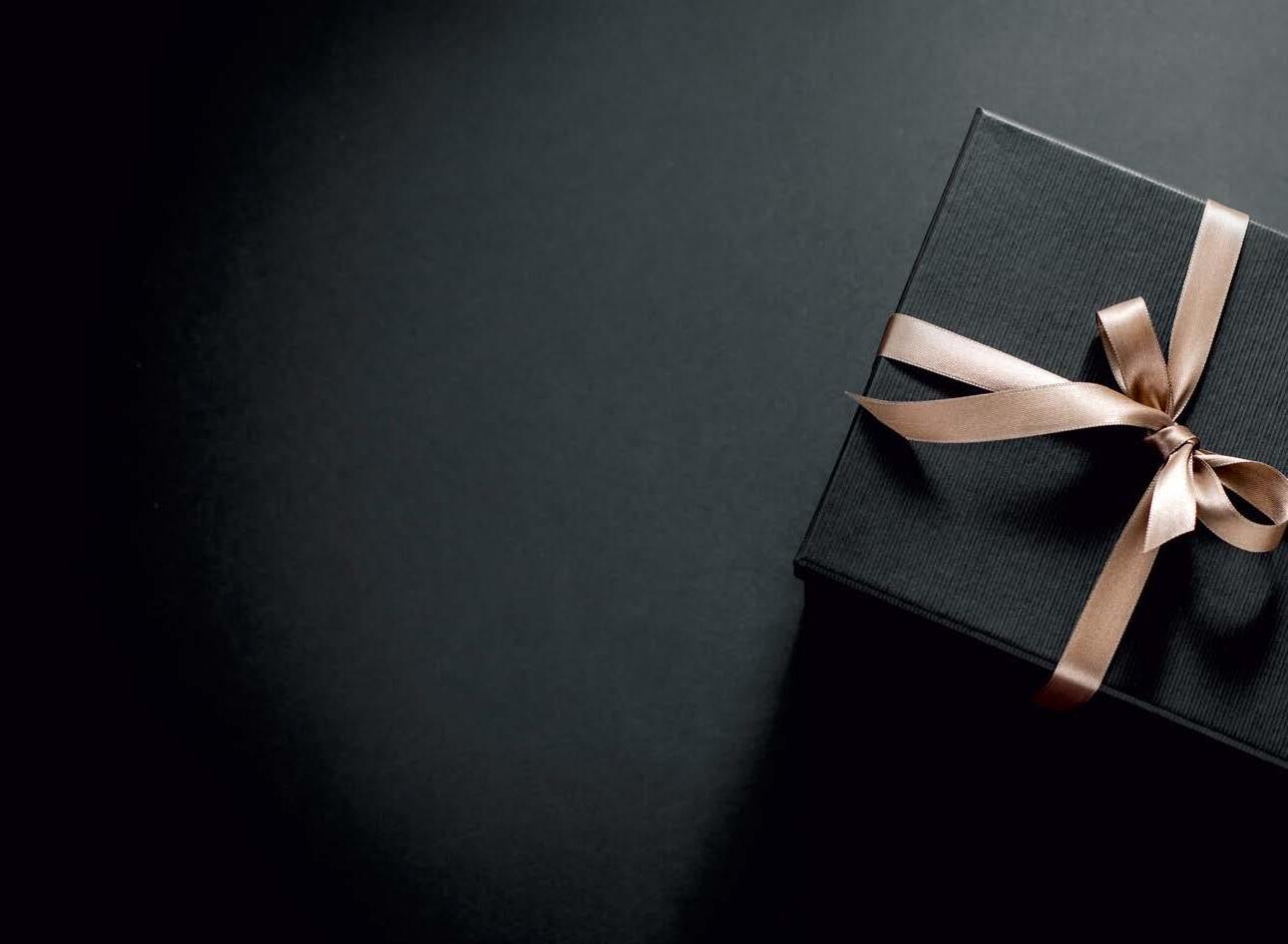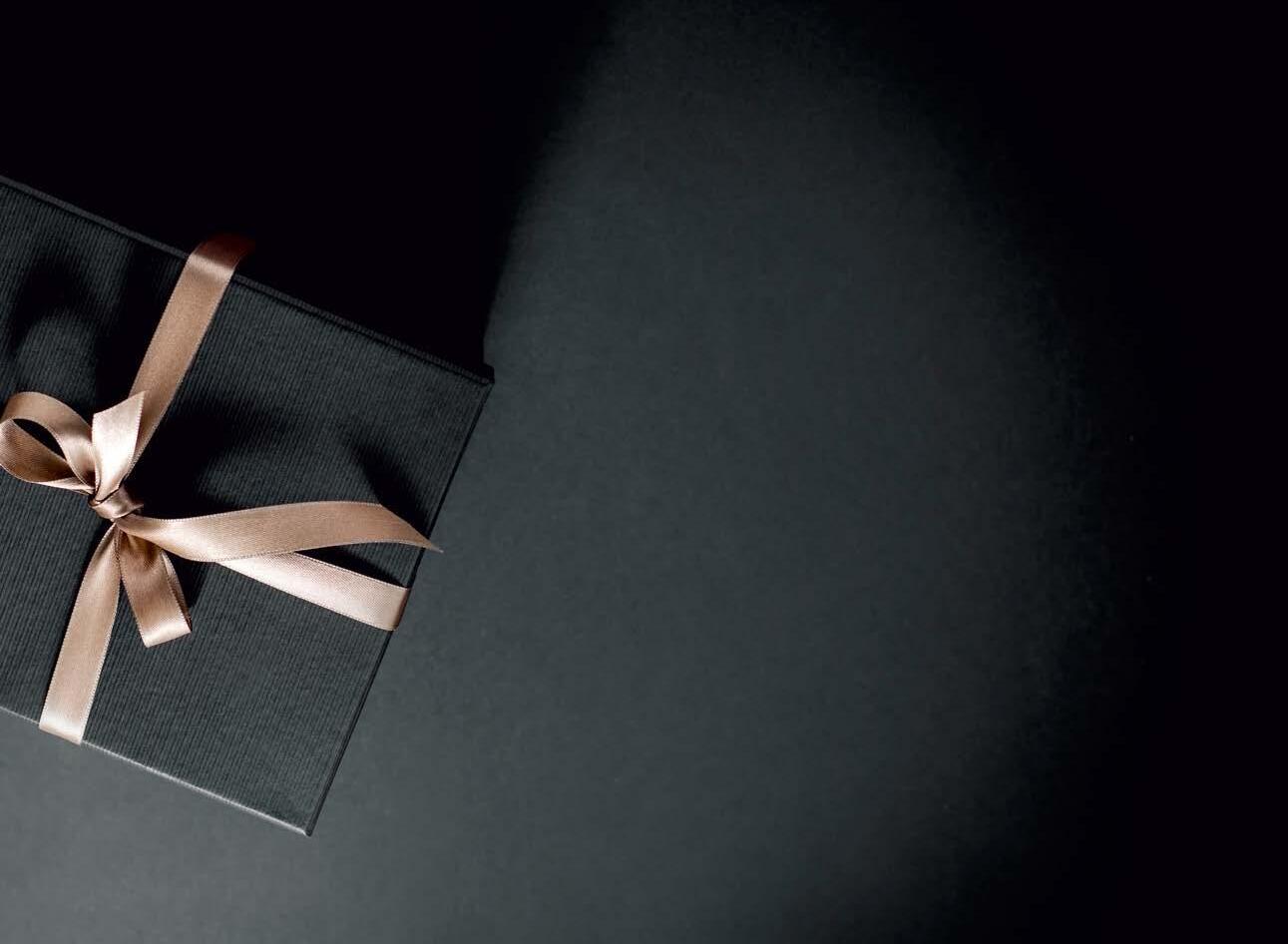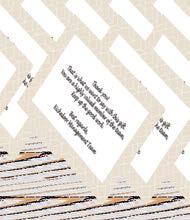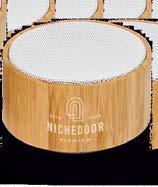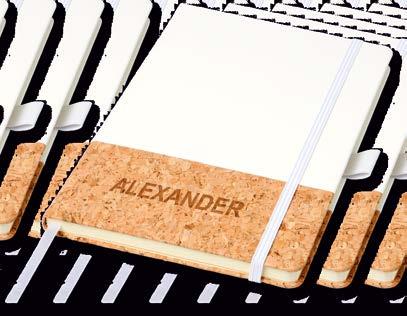www.czechleaders.com including electronic version


www.czechleaders.com including electronic version

Interview with H.E. Mr. Stéphane Crouzat, Ambassador of France
THE EU MUST ACT AS A GEOPOLITICAL POWER
Interview with H.E. Ms. Ana Berenice Diaz Ceballos Parada, Ambassador of Mexico GREAT OPPORTUNITIES DESPITE THE DISTANCE
Interview with H.E. Mr. Richard Masozera, Ambassador of Rwanda AFRICA’S IMPORTANCE IS GROWING
Interview with H.E. Mr. Claudio Javier Rozencwaig, Ambassador of Argentina CELEBRATING 100 YEARS WITH A POLITICAL RELAUNCH
Interview with H.E. Mr. Duong Hoai Nam, Ambassador of Vietnam SERVING ON THE EVE OF AN ANNIVERSARY
Interview with H.E. Mr. Emil Krsteski, Ambassador of North Macedonia NORTH MACEDONIA DESERVES TO BE MEMBER OF EU
Interview with Ms. Natalia Bayona, UN Tourism Executive Director TOURISM IS THE MOST HUMAN SECTOR OF ALL
World business goes to Osaka, Japan BECOME A PARTNER OF THE CZECH PARTICIPATION AT EXPO 2025
A woman who spoke little and did a lot IN MEMORY OF DIANA STERNBERG
A glass spiral in Osaka THE CZECH NATIONAL PAVILION FOR EXPO 2025 WILL BE A MARVEL
Chronic venous insufficiency affects up to 80% of the population
A NEW VASCULAR CENTRE OPENS IN PRAGUE 5
MyleFly helps frequent flyers HOW TO CASH YOUR LOYALTY MILES
The kind of clothes you want MAKING CZECH T-SHIRTS LESS ORDINARY
The Chiavary Bridge and restricted war diary THE WEATHER WAS IDEAL FOR BOMBING
Holidaying in Sorrento BUONGIORNO ITALIA!
A farewell message from H.E. Ms. Tanja Strniša, Ambassador of Slovenia
A farewell message from H.E. Mr. Alexandru Codreanu, Ambassador of the Republic of Moldova
PRAGUE NEVER LETS YOU GO…
A farewell message from H.E. Mr. Philippe Guex, Ambassador of Switzerland
I AM CLOSING THE LOOP
A farewell message from Mr. Toni Strniša, spouse of Slovenian Ambassador, H.E. Ms. Tanja Strniša
A special reception at the Kaunický Palace NATIONAL DAY OF ARGENTINA 2024
Czech Roots on the top of the museum THE 11TH FASSATI ART FESTIVAL GALA EVENING
Celebrating 100 years of diplomatic relations CZECH – ARGENTINE POLO DAY
Benke Aikell – Founder | Eva Anderová & Meshulam Zisso – Owners & Executive Editors | Petra Kubernátová – Webmaster | Martina Hošková – Edit & Translation | Martin Mikeš – Graphic Design | Printing house – Tiskárna H.R.G. Litomyšl | Publisher PRIME (1998) s.r.o., Olgy Havlové 2914\52, 130 00 Žižkov - Prague 3, IČ: 25682784, DIČ: CZ25682784, e-mail: info@czechleaders.com, www.czechleaders.com | Czech & Slovak Leaders, Olgy Havlové 2914\52, 130 00 Žižkov - Prague 3, email: info@czechleaders.com, www.czechleaders.com | Licence: MK ČR E 13147 | No reproduction is permitted in whole or part without the express consent of Czech & Slovak Leaders | The advertiser is responsible for the advertising contents | Opinions expressed in this publication are those of the authors or persons interviewed and do not necessarily reflect the views of the editors or Czech & Slovak Leaders | All editorial material and photos in Czech & Slovak Leaders Magazine is digitally stored and may be republished by Czech & Slovak Leaders either in printed form or in various digital media | All correspondence to Czech & Slovak Leaders Magazine may be published.
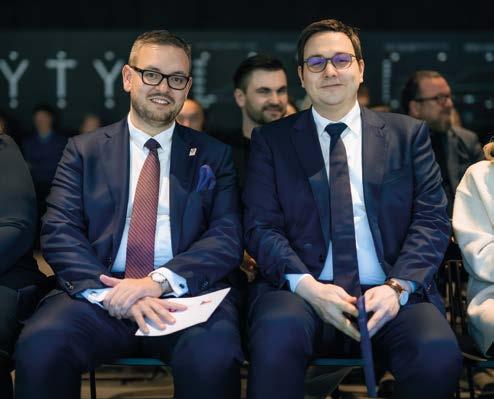
World EXPOs are an excellent opportunity to strengthen a national brand and connect the global market with Czech companies. EXPO is the most significant social, cultural, and business event in the world, taking place once every five years. It regularly attracts tens of millions of visitors from all around the globe, encouraging participants to showcase innovations, new technologies, and their national achievements. For companies, it’s a chance to present themselves on an international scale and forge new key partnerships.
The upcoming EXPO 2025 will be held from April to October in Osaka, Japan, on the island of Yumeshima. Czechia will be represented by a confident and visually intriguing pavilion made of spruce wood and a glass façade.
Czech participation offers to its partners an excellent platform to strengthen their brand, establish valuable connections, as well as
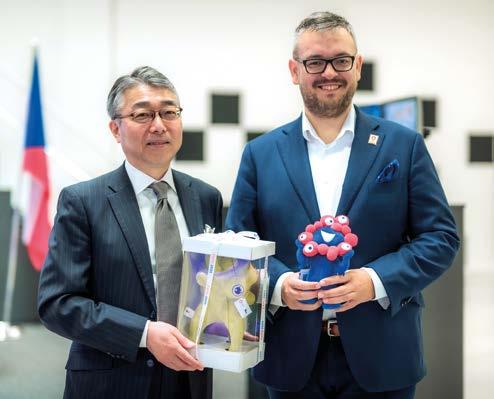
a unique chance to present themselves to potential partners from around the world and discuss current trends, technologies, and innovations. For all this, they can use the facilities of the Czech National Pavilion and other services, such as language interpretation or marketing support.
Participation in EXPO 2025 will provide our partners with a great opportunity to expand not only into Japan but also into the broader, highly competitive Indo-Pacific region. In Asia, the perception of the state is stronger than in Europe, and if a company cooperates with the state and participates in the national pavilion, it carries much greater significance and relevance in the eyes of local clients and business partners. EXPO is a prestigious affair and a great reference project, even if you don’t have export ambitions towards Asia. For instance, it can help you increase commissions, gain new partners, and attract new clients.
For the 26 weeks of EXPO, we have prepared a number of business topics and branches which we want to present in Japan together with our partners. These include, for example, nanotechnology, fintech, space technology, cybersecurity or circular economy. For the calendar of business events, scan the QR code.
Our potential partners can choose between four different partnership types. You can also collaborate with us as an official supplier or as a partner of the #road2expo business conferences.
Want to learn more? Contact us at partnership@expo2025czechia.com. Join us and help shape the future of Czech business at EXPO 2025. Together, we can achieve global success.
Ondřej Soška, Commissioner General of the Czech participation at EXPO 2025
SCAN QR fore more

The name of Mrs. Diana Sternberg (whose full name was Franziska Diana Phipps Sternberg) is inseparably linked with the Good Will Committee – Olga Havlová Foundation. Along with Olga Havlová, she was at the very inception of the organization. “Her noble assistance significantly contributed to the realization of numerous charitable projects and helped countless people in need,” stated the foundation’s director, Monika Granja.
Diana Sternberg was born in 1936 in Vienna, Austria, but after just five days she left for Častolovice, Czechoslovakia, with her mother, Cecílie. She lived in the castle
there until World War II, when the Nazis confiscated the property. She returned to Častolovice after the war. In 1948, after the Communists came to power, she went into exile with her parents. They settled in California, and later in Jamaica. In 1957, she married the American Harry Phipps, whom she met during her stay in Europe. Her husband died six years into their marriage. After that, she moved with her mother and daughter Alexandra to England, where she established herself as an interior architect. In the United States, she published a book on interior architecture that became a bestseller. After the Velvet Revolution, she also participated
in the renovation of the interiors of Prague Castle and the castle in Lány. She lived in Častolovice Castle, which she regained through restitution, since 1992.
Mrs. Diana Sternberg first met Mrs. Olga Havlová in 1988. At the time, she was in Prague with a group from the Helsinki Committee, and they went to visit the Havels. She recalled that moment: “We were quietly and in the dark walking down the stairs to ensure our presence didn’t endanger anyone. When we were halfway down the steep climb, the entire staircase lit up. A beautiful woman stood on the landing and asked, ‘Why are you walking in the
dark? Can’t you turn on the light?’ And that was Olga Havlová for me. Practical and logical, smart, unsentimental, and witty.”
The friendship between the two women began in June 1989 at Hrádeček, where they came with friends Harold Pinter and his wife to visit Václav Havel during his house arrest. Later, Olga and Diana started visiting social institutions and healthcare facilities together, trying to help people living there as discarded individuals, disconnected from life, as well as people outside of the walls of those facilities. The worst, they thought, were the institutions full of elderly people, and the homes for children who were confined there. They were helping them even before the Good Will Committee was formally established.
Diana Sternberg spent a quarter of a century alongside the Good
Will Committee as a member of the foundation’s board. She was involved in the establishment of its sister organizations in England and the USA. She always held great respect for the people in leadership roles at the foundation. She felt guilty for not being able to adhere more closely to Olga’s example, learning about those in need only through paperwork rather than meeting or talking to them in person.
“That is a flaw in my character –I am ashamed that I cannot be public. Olga Havlová also suffered from this, but because of her position, she had to be more disciplined,” explained Mrs. Diana.
Mrs. Diana had a very good awareness of charity in general. She considered charity in America to be very solid and heartfelt. She saw Americans as people with very good hearts and striving to be socially visible; plus, the tax advantage of giving donations
played a significant role there as well. When she moved to London, she encountered a different kind of charity. “More is done here, and less is talked about. I had a friend who visited prisoners once a week her whole life and talked with them. Other women go to the hospitals – they are called ‘book ladies’ – and they bring along a stroller with a small library. The patients either choose a book to read themselves or the ‘book lady’ reads a selected book for them. You can’t say which activity is more important. Every help is good,” noted Mrs. Diana. She was pleased that the approach to charity in the Czech Republic was gradually improving. She had great sympathy for people fleeing their homes to escape danger, and kept reminding us of the help provided in other countries to Czechoslovaks who emigrated. At her ancestral castle in Častolovice, Mrs. Diana regularly received children from the Sun Foundation,



which she was taken to at its opening in 1991 by Olga Havlová. She loved the kids, and hoped that it was mutual. She always looked forward to their visits.
“We dance, we sing, we have clowns and plenty of food. It’s cheerful,” she described the meetings with the children. She greatly admired the work of the foundation’s director, Doctor Blanka Dvořáková, attributing to her success the fact that ‘her children’ with combined disabilities navigate life without awareness of their handicap. She also collaborated with a shelter for parents with
children in nearby Kostelec. For disabled visitors, she provided a stair climber at Častolovice Castle, and designed tours for the visually impaired with the opportunity to touch everything.
Diana Sternberg loved literature and music, claiming that she could not live without them. Nature filled her with positive energy. In Častolovice, she built a mini zoo, aviaries for birds, a shelter for sick swans, established both a rose garden and a water garden, and planted new trees for the future of the
castle park, which is very popular among visitors.
In 2015, Diana Sternberg ended her active involvement with the Good Will Committee –Olga Havlová Foundation. She withdrew from public view but continued to support its activities with generous donations. She died on July 31st, 2024, two minutes before midnight, in a Vienna hospital, surrounded by her close family.
Excerpted from the interviews for the magazine Good News of the Good Will Committee – Olga Havlová Foundation: 1/ “Volunteering to help is a matter of course,” says Diana Phipps; interview by Irena Šatavová (No. 4/2009) 2/ A woman who speaks little and does a lot: Diana Sternberg; interview by Irena Šatavová (No. 3/2015)
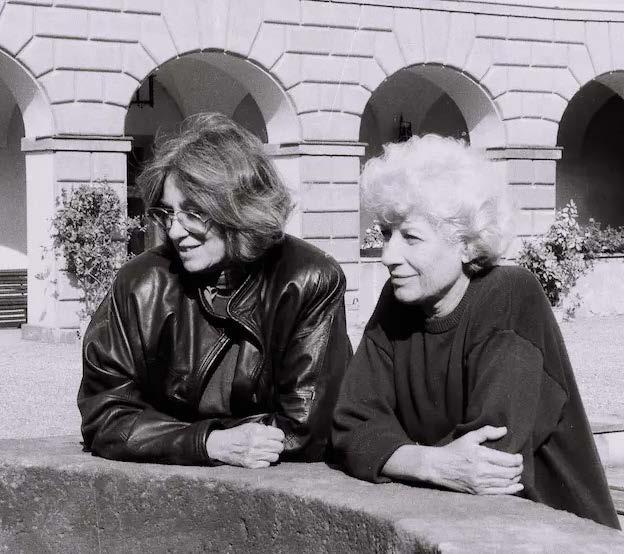
H.E. Mr. Stéphane Crouzat, Ambassador of France, rightly describes his new position as starting in the most intense way imaginable. “I arrived on March 3rd, presented my letters of credence to President Pavel on March 4th, and on March 5th I was welcoming President Macron for an official visit!” He identifies the two key areas of cooperation that have brought our countries closer together in recent years as “unwavering common support to Ukraine and our determination to make nuclear energy a key element of the energy transition in the EU”.

H.E. Mr. Stéphane Crouzat, Ambassador of France
Tell us about yourself. What made you become an ambassador?
I was born and educated in Paris, a city in which I feel very much at home. I studied humanities and political science. I was interested in international relations early on, but only joined the diplomatic service in my thirties, after having worked for the Ministry of Foreign Affairs in the cultural sector. Postings took me to New York, Warsaw, and Dublin for my first posting as ambassador. Climate change issues have been a very important part of my diplomatic experience. First, I was a diplomatic advisor to Ségolène Royal, Minister of Environment and Energy, during COP21 and the adoption of the Paris Agreement. Later, I became Climate Ambassador, a position I held just before being nominated to Prague. This experience has made a lasting impact on me. I came to realise how existential a threat climate change has become. I often bring it up in my conversations here in Czechia.
You have been in the Czech Republic for a few months now. Can you share some of your impressions?
My term here started in the most intense way imaginable. I arrived on March 3rd (after coming back from Tokyo the day before from my previous position), presented my letters of credence to President Pavel on March 4th, and on March 5th I was welcoming President Macron for an official visit! I am very thankful to the Czech authorities, who allowed me to be operational from day one. Those first days were a fantastic opportunity for me to meet key stakeholders of the bilateral relation, especially regarding our cooperation in the field of energy, with the Czech-French nuclear forum, and in culture, with a memorable visit to the National Gallery, where our President
stayed for an hour and a half to admire Czech masterpieces and the remarkable French collection bought by Czechoslovakia in 1923. Prague is a wonderful city, which I love to discover every day. I have also been travelling around the country as much as possible, to places such as Plzeň, Brno, Vysočina, Třebíč, Ostrava, České Budějovice, Karlovy Vary, and lately to Most for the Olympic Festival. Prague is so beautiful that it would be easy to stay here, but I feel it is important to move around, discover Czechia in its diversity, and boost regional cooperation.
How many countries did you serve in before?
I have served in New York, at our permanent mission to the UN; in Warsaw, as a cultural counsellor; and in Dublin for my first posting as ambassador. In my previous life, I was director of the French Institute in Edinburgh, and did my national service at the French embassy in Jakarta, Indonesia.
Does being an ambassador fit into your lifestyle?
I like meeting interesting people and discovering new places, so, yes, this is the ideal job for me.
Many people share your hobby of discovering new places, and many do so in France. How do you promote your country?
France is the first touristic destination in the world. As you know, the Olympic Games took place from July 26th to August 11th, followed by the Paralympics from August 28th to September 8th. This has been a tremendous opportunity to showcase the best of France, while hosting the biggest sporting event in the world.
Our embassy in Prague plays its part in promoting France as a touristic destination, by hosting
“Atout France”, the agency dedicated to this purpose. This involves close cooperation with French regions and localities, notably regarding winter sports or the coastlines. We also do a lot to promote France as a place to invest in, with the yearly “Choose France” event where top CEOs (including Czech CEOs) are invited to Paris. We promote, through our French Institute in Prague, our network of six Alliances Françaises throughout Czechia, the learning of French as a foreign language, and all things related to French culture. Stay tuned, amongst many other exciting upcoming events, for the upcoming French Film Festival in November!
France is a leading and founding member of the EU. How do you see the future of not only the EU but of Europe as a whole?
The war in Ukraine has considerably reshaped the way Europe should see itself and its surroundings. Even before this brutal aggression, France advocated for a strong Europe, one more independent strategically and industrially, by ramping up our defence capacities, as well as our ability to be independent energetically or regarding access to raw materials. This was spelled out by President Macron in his speech at the Sorbonne University as early as 2017, and again in his Sorbonne speech in May 2024, and pushed throughout our French Presidency of the Council of the EU in 2022 with our “Versailles agenda”, in reference to the summit that took place in March 2022. Facing Russian aggression and a world which is ever more brutal and competitive, Europe could indeed face decline. This can be avoided if we stay true to our values and the principles that founded the EU, and act as a geopolitical power, without being shy or naïve.
A crucial next step will be the enlargement of the EU, a process
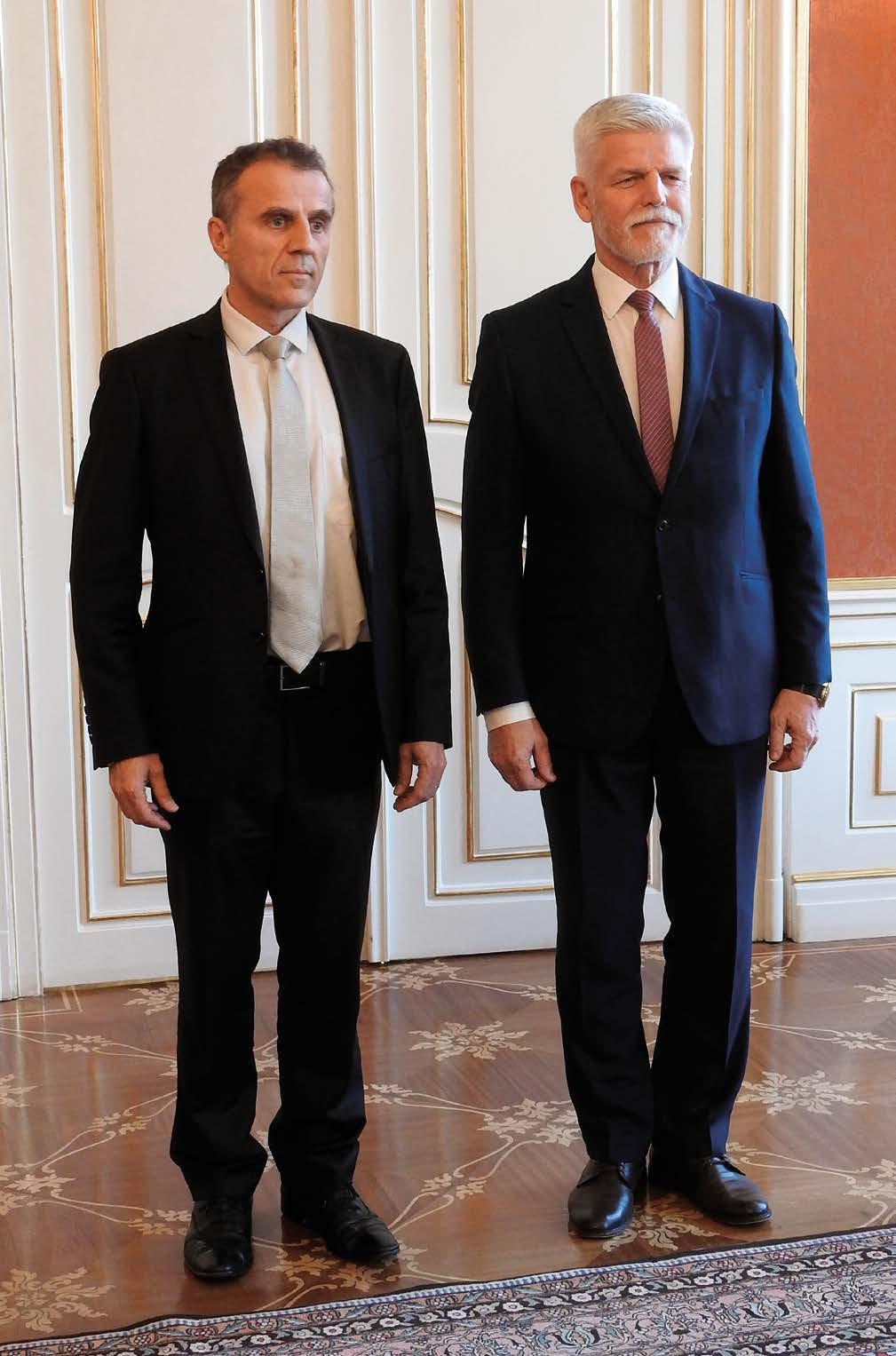

that has significantly moved forward since 2022. We need to find ways to make the EU as efficient with new Member States as it currently is. We count on all our partners to participate in this debate.
Can you evaluate the current status of Czechia – France bilateral relations?
Our economic relations have continuously grown since Czechia entered the EU, and we are Czechia’s 6th biggest supplier, 4th biggest client, and 3rd biggest investor. On a cultural level, we have implemented solid long-term partnerships between the Czech Narodní galerie and the Centre Pompidou and the Louvre. The succession of our EU Presidencies in 2022 allowed for a constant dialogue over key European issues, which has not stopped since and will continue under the new Commission. The visit of President Macron last March gave us a precise roadmap of bilateral partnerships to undertake or deepen, across the board, thanks to the action plan of our strategic partnership signed by President Macron and Prime Minister Fiala
on March 5th. The action plan covers all areas of cooperation, from security and defence to trade, transport, scientific, educational, and cultural exchanges, and more.
We have moved closer in recent years, notably regarding our unwavering common support to Ukraine and our determination to make nuclear energy a key element of the energy transition in the EU with the European nuclear alliance. However, the decision by the Czech government, announced on July 17th, not to select EDF as the “preferred bidder” for the construction of new nuclear reactors at Dukovany – a 100% European bid – has been a setback. EDF stands ready to pursue or relaunch discussions with CEZ and the Czech government should circumstances change. France will continue to invest in building energy sovereignty at the European level, through the European nuclear alliance and its own nuclear renaissance programme.
Let us conclude with a wish for both countries – will you?
I can only wish that our bilateral relations move forward to even higher levels. Had EDF won the tender of the nuclear reactors of Dukovany, we would have had our common work carved out for us. While we regret that Czechia did not make a European choice in a key industry for our continent, we have to move forward and build on our common interests in every sector. The Czech embassy in Paris will have a great new ambassador, Jaroslav Kurfürst, who will also contribute to making our countries ever closer. As for Czechia, I hope it will keep growing strong, as it has over the last twenty years thanks to its accession to the European Union, and that more and more Czechs will recognize the benefits of having joined the EU and being an active player in it. Czechia has much to offer to the EU in terms of being a staunch defender of individual freedoms and the rule of law, with its legacy of Václav Havel and the Velvet Revolution. Keep enjoying the taste of freedom!
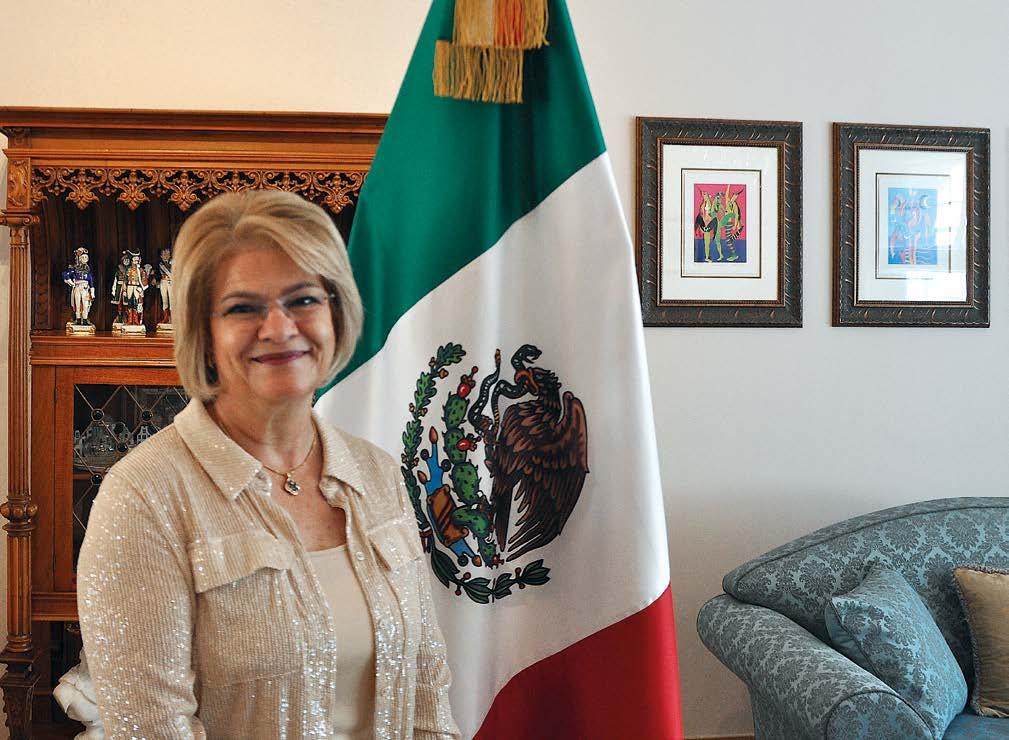
Can you introduce yourself to our readers?
Sure. I was born in Mexico City. I hold a degree in International Relations from the Universidad Iberoamericana. My Bachelor’s thesis was awarded the Prize for the Best Thesis on Human Rights by the National Human Rights Commission in 1994.
I have worked in the Ministry of Foreign Affairs of Mexico for over
30 years in areas as diverse as multilateral and regional forums, bilateral relations, and consular affairs. I think this diversity has enriched my career and broadened my perspective. I became a member of the Mexican Foreign Service in 1998.
I have had the honour of serving as Ambassador of Mexico to the Czech Republic since April of this year. Before that, I had the privilege to serve as Consul General of
H.E. Ms. Ana Berenice Diaz Ceballos Parada, Ambassador of Mexico, arrived in Prague with her husband and two Golden Retrievers in April of this year. “I see enormous interest in Mexico here, and such a great start makes me extremely excited about future projects,” she says.
“One of my top priorities is to contact companies and explore new opportunities for trade and investment.
Mexico stands out not only for its vast natural resources but also for its robust logistics and manufacturing platforms. This dual capacity offers a unique opportunity to deepen our collaboration.”
Mexico in Vancouver, Canada, for almost 8 years (July 2016 to March 2024), and as Head of the Mexican Consulate in Oxnard, California (May 2013 to July 2016).
My husband is an industrial engineer, and we have two adorable Mexican Golden Retrievers, Milly and Lizzy, whom we love and have brought with us to Prague.
Over 30 years of work for the Ministry of Foreign Affairs of Mexico must have put you in quite a range of different roles. Can you name some?
In the Ministry of Foreign Affairs, between July 2005 and April 2013, I held the position of Chief of Staff of the Vice Minister of Foreign Affairs, overseeing bilateral Mexican relations with Europe, Asia-Pacific, Africa, and the Middle East, and also served as Sous-sherpa of the President of Mexico in the Group of 20, which brings together the world’s leading economies - Mexico chaired and hosted the G20 World Summit in Los Cabos, Mexico in 2012.
I also served as Deputy Director General for Global Issues (July 2002 to June 2005), and held various positions within the Office for the United Nations System (June 1993 to June 2002). During this period, I specialized in political, economic, financial, social, environmental, migration, transnational organized crime, corruption, and human rights issues.
What made you become a diplomat?
I think that, in my case, there was a combination of professional and personal reasons to become a diplomat. There was also the constant search to channel some of my concerns and passions that started at an early age while studying, learning languages, travelling with my family throughout Mexico and abroad, attending
a yearly summer camp, and being involved in altruistic or philanthropic projects in Mexico and abroad.
Through the years I developed my passion for national politics, policy-making, international relations, and global issues; a desire to make a difference; the need to advance my career and have personal and professional growth; advocating for gender equality, human rights, and non-discrimination; and the great privilege of becoming a member of the Mexican Foreign Service to promote my country’s interests and values abroad.
Diplomats live and work in constant touch with other people. Who were some of the inspiring personalities you met on your career path?
I was very lucky to have found great people in life – teachers, bosses, and friends who became my mentors and role models and taught me important values, skills, and qualities that I think have contributed significantly to enriching and broadening my professional and personal life.
The first one that comes to my mind is Mr. Gilberto Rincón Gallardo (1939-2008), who was a notable Mexican politician, social activist, and advocate for human rights. I had the privilege to work on and jointly present with him, back in 2001, the initiative to establish an Ad-Hoc Committee to elaborate the “United Nations International Convention on the Rights of Persons with Disabilities”. This was a legally binding human rights instrument that has reached, after 10 years of adoption, almost universal ratification, with 191 ratifications and accessions by member countries.
Mexico is soon going to welcome its first female president. Do you think having
more female politicians and diplomats can make the world better?
Absolutely, female politicians and diplomats can make the world different and better. This is because we like to think out of the box, and look for different and creative solutions that incorporate the gender perspective in policymaking and budgets in critical areas such as poverty, education and training, health, the fight against violence, armed conflicts, economy, power and decisionmaking, institutional mechanisms, human rights, media, environment, and the rights of girls and young women.
For many years we have fought for gender equality, empowerment, and more opportunities. I think our leadership helps create more inclusive, equitable, and sustainable societies, benefiting everyone.
In the 21st century, we are still facing systemic barriers that need to be removed so that women can participate on equal terms in all areas of life, whether public or private. Despite some progress, real change has been agonizingly slow for the majority of women and girls in the world. Today, not a single country can claim to have achieved gender equality. Multiple obstacles remain unchanged. As a result, women remain undervalued. They continue to work more, earn less, have fewer choices, and experience multiple forms of violence at home and in public spaces.
Do you expect some changes in this regard after the new Mexican president takes office?
I am confident that with the new President of Mexico, Mrs. Claudia Sheinbaum Pardo – whose presidency starts on October 1st – a new era for the empowerment of women and girls will be inaugurated in Mexico and be
materialized in laws, decisions, and policy-making for the advancement of women and girls, and to comply with the goals of the 2030 UN Agenda on Sustainable Development.
She has recently announced the cabinet that will accompany her in the next six years, and has been careful enough to maintain parity between men and women. That is a positive sign. I hope this will also be the case in the legislative and judicial systems.
You arrived in Prague a few months ago to take up your ambassadorial position. Can you share your impressions so far?
The Czech Republic is a wonderful country, where everywhere you go you can appreciate the details of its rich history and culture. Since my arrival, I have been very impressed by its beautiful landscapes, incredible architecture, and, above all, by its modern and vibrant society. The Czech people have welcomed me, and, in these months, I have been able to notice that there is enormous interest in Mexico, whether for its culture, attractiveness for doing business, varied tourist destinations, world-famous gastronomy, or even icons of popular culture.
I have had the fortune of talking with the highest-rank authorities of the Czech Republic: I presented my credentials to President Pavel in a beautiful ceremony at Prague Castle, greeted Prime Minister Petr Fiala at one of the biggest events of the year, and have spoken at length with Minister Jan Lipavský about the bilateral relationship, among other meetings in different ministries and public agencies. At the same time, I have been able to lead cultural activities in which we got to share with the Czech people the richness of Mexican painting, music, cinema, and literature. I think this is a great start, and
it makes me extremely excited about future projects.
Can you briefly sum up the current status of Czechia-Mexico relations?
This year we celebrate 102 years of diplomatic relations. This is a longstanding friendship that is based on mutual respect, shared values, and many coincidences in foreign policy priorities. This translates into open and constant political dialogue at all levels: an increasingly large economic exchange with very promising prospects, great coordination in multilateral forums – particularly within the United Nations, and new links between academic and research institutions.
Mexico is the Czech Republic’s main trading partner in Latin America – it is a gateway to North America, as well as a reliable interlocutor on the whole continent. At the same time, the Czech Republic is a country that plays a very relevant role in the context of the European Union and at the regional level in Central Europe, in addition to being involved in the most pressing causes of the international system.
How would you like to bring both countries even closer?
In Mexico, just like in the Czech Republic, we are projecting the place we want to occupy in an increasingly dynamic and complex international system.
With our Czech counterparts, we want to strengthen high-level political dialogue as these meetings encourage the advancement of joint projects, as well as provide a space for contacts between companies, universities, government agencies, and other partners.
We also want Czechs to know more about Mexico, and, despite
the distance, be able to appreciate the great opportunities it offers. We are the 12th largest economy in the world, with a market of more than 120 million people. We also have a robust industrial sector that is deeply integrated into North America, and a network of free trade agreements that give us access to more than 50 countries, including the European Union. That, combined with our strategic position in America, between the Pacific and Atlantic oceans, makes us one of the most open and dynamic economies in the world. We also have a young and highly trained population, and we find ourselves in a very interesting moment of profound transformation.
As you can imagine, one of my top priorities is to contact companies and explore new opportunities for trade and investment.
I also want to focus on programs for the exchange of academics and scientists. The Czech Republic distinguishes itself for the excellence of its universities and research institutes, and has very clear goals for R&D, innovation, and sustainable development. This works perfectly with our shared vision of technology as a catalyst of development – with a focus on sustainability and resilience – and we want that to reflect on our economies for sure.
You mentioned trade and investment as one of your top priorities. What are you planning to focus on?
We will work to maintain the growing trend of bilateral trade, which is largely due to our complementarity in strategic sectors such as automotive, ICT, and electronics. In 2023 alone, total trade exceeded $2.3 billion, which registered an increase of 13% year-on-year, and consolidated the Czech Republic as our 10th largest trading partner in the EU.

While we rely largely on our champion industries, we will work on creating new opportunities for the biotechnology, nanotechnology, medical devices, new materials, infrastructure, and renewable energy sectors.
I can assure you that we have closely followed the Czech Republic’s trade diversification efforts, and fully agree on the need to find reliable partners in supply chains, from energy sources to the provision of critical materials. In this regard, Mexico stands out not only for its vast natural resources but also for its robust logistics and manufacturing platforms. This dual capacity offers a unique opportunity to deepen our collaboration.
Can you highlight any specific opportunities in Mexico that
might attract Czech businesses?
We want Czech companies to know about Mexico’s attractiveness for nearshoring, the new trend to tackle the challenges of global commerce. Right now, we are working in particular on creating opportunities in electromobility, for example in the Bajío region, (Queretaro, Aguascalientes, Guanajuato, and San Luis Potosí).
Just in the first quarter of 2024, the electromobility sector accounted for 62% of total foreign investment in Mexico, including assembly plants for hybrid and electric vehicles, battery components, and aluminium auto parts, to name a few examples.
There are other investment opportunities in strategic projects to create circular economy models. The Sonora plan provides the
framework for the construction of five solar power plants, one of which will be the biggest in Latin America, aiming to provide electric energy for industrial parks. It also has a focus on the extraction of critical materials, such as zinc, copper, gold, and lithium, to produce batteries and semiconductors.
For infrastructure and logistics, we are developing an interoceanic corridor, which will facilitate the crossing of goods and materials by connecting the Pacific and Atlantic oceans through the narrowest part of Mexico’s territory. It will promote the development of the mining, petrochemical, electronics, and automotive industries (with a focus on electromobility), as well as machinery, ICT, semiconductors, medical devices, and pharmaceuticals, among others.
We shouldn’t forget the fact that Mexico is also a big holiday destination for Czech people. Do you agree?
Yes, and I must say that Mexico has it all: It is a powerhouse for artistic creation, a mega-diverse country, and has a great variety of climates and landscapes. It has cultures dating back millennia, and a unique gastronomic tradition. But, above all, the attractiveness of Mexico lies in the warmth of its people, and in the different experiences they can provide to our foreign visitors to discover all of the above.
Mexico is a world-class tourist destination, the sixth in the world, with around 42 million visitors per year. In my home country, you can appreciate vestiges of pre-Hispanic cultures on 45,000 archaeological sites, and we have the largest number of sites declared World Heritage Sites by UNESCO. In Mexico, you can visit parks and natural reserves, which are home to 10% of the biodiversity in the world, and practice ecotourism activities such as diving in the second-largest coral reef in the world. You can also rest on wonderful beaches, either in quiet traditional towns or in cities with large resorts and luxury hotels. Mexico is a great destination for lovers of history, photography, and crafts, who can spend days touring colonial towns and enjoying our immense offer of museums, galleries, restaurants, bars, nightclubs, and the list goes on.
What is the latest news on Mexican tourism?
Currently, we are very happy to promote the first direct flight between Prague and Puerto Vallarta, starting October 2024. It is a charter operated by Fischer and EximTours that will connect both cities, offering all-inclusive packages with top-level suppliers. We hope that Czechs can take the
opportunity to get to know this beach destination, which maintains a traditional atmosphere while not skimping on offering a wide variety of restaurants, bars, and clubs, as well as tourism, recreation, and nature activities. Without a doubt, this is an excellent opportunity for those who want to get to know Mexico, and have a break during wintertime.
As an ambassador, you proudly represent your country. What makes you proud to be Mexican?
There are many reasons why I feel proud to be Mexican. One of the foremost is our rich cultural heritage. Mexico is home to a tapestry of traditions, languages, and customs that reflect a deep and diverse history that covers ancient civilizations like the Aztecs and Mayans. It is traditional colonial cities like Zacatecas or Mérida, or our modern and industrial cities like Monterrey and Guadalajara, that make Mexico a great multicultural, diverse country, and a great destination.
Mexican gastronomy is another significant source of pride, and has been designated as an intangible heritage of humanity by UNESCO. Mexican food is recognized worldwide for its rich flavours and variety. From tacos and tamales to mole and pozole, our food is a delicious combination of creativity, fresh local ingredients, and traditional cooking methods.
Mexico is also world-known for its great archaeological sites throughout the country such as Teotihuacan, Monte Alban, and Chichén Itzá. These ancient civilizations made significant contributions to the cultural, scientific, and social development of Mesoamerica in diverse fields like architecture, astronomy, mathematics, agriculture, and more. Their lasting legacy continues to be studied and admired today.
Mexico has, as well, a proud legacy in arts, culture, and sciences. Figures like Frida Kahlo and Diego Rivera have left an indelible mark on the art world, while Octavio Paz and Carlos Fuentes have enriched literature. In science, individuals like Mario Molina, who won a Nobel Prize for his work on the ozone layer, showcase our country’s intellectual contributions. These achievements highlight the talent and ingenuity of our people.
This interview is done on the occasion of your National Day. Would you like to conclude with a message to both Mexicans and Czechs?
On this National Day, I want to celebrate the spirit and resilience of the Mexican people. We have a rich history and a vibrant culture that we should be immensely proud of. Let’s continue to cherish our heritage, support one another, and strive for a brighter future. To the Czech people, I extend an invitation to experience the warmth, beauty, and richness of Mexico. ¡Viva México!
Dear friends,
The roots of friendship and cooperation between Czechs and Slovenians go far back in history, as we lived as the same entity for many centuries – something which is reflected today in the close cooperation between the two countries in many fields. That is why serving my country in the Czech Republic was a real privilege for me.
Today, Slovenia and the Czech Republic are members of EuroAtlantic integrations, successfully cooperating in regional alliances and sharing the same democratic values. Economic trade between the two countries is growing, and we are happy to see the increasing number of Czech tourists visiting Slovenia. But the cooperation extends to many other areas too, and I was happy to help promote very lively cultural exchanges at all levels, from amateur to cuttingedge arts, student exchanges, cooperation between Czech and Slovenian municipalities, and people-to-people contacts.
The work of the Embassy of Slovenia in my five-year mandate was marked by the Slovenian Presidency of the Council of the EU in the second half of 2021, and by the Czech Presidency of the Council of the EU a year later. In 2022, we celebrated 30 years of diplomatic relations between the Republic of Slovenia and the Czech Republic. In the same year, the Embassy, together with local partners, organized several cultur-
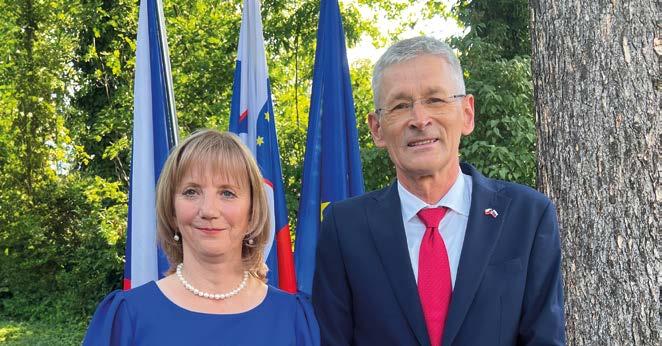
al events to commemorate 150 years of the birth of the outstanding Slovenian architect Jože Plečnik, who was entrusted to be Prague Castle’s main architect by the first Czechoslovak President Masaryk. Together with my husband Toni, who looked after the bees in the Embassy’s garden apiary, I was particularly proud of our bee diplomacy events to raise awareness for the global importance of pollinators for both the environment and food security.
Thanks to these events, the excellent cooperation between our two countries at the political and other levels has been particularly intense over the past few years. At this point, I would like to thank the Czech leaders and partners for all their valuable contributions in deepening bilateral cooperation.
I and my husband would also like to thank the Embassy’s staff for their assistance, and to the members of the diplomatic community in Prague for their friendship and
support. Last but not least, we would like to thank the Czech and Slovak Leaders magazine for publishing the Embassy’s events, as well as for their appreciated support of our efforts.
Let me conclude with words from the almost two-centuries-old lyrics from Slovenia’s anthem –written by the famous Slovenian poet France Prešeren, he wrote a toast to the nations: “Who long to see, that all men free, no more shall foes, but neighbours be!” – let us do our utmost to make these thoughts a reality!
Dear friends, my husband and I are very grateful for the new experiences, connections, and friendships acquired in beautiful Czechia, which will remain in our hearts forever.
Česká republika zůstane navždy v našich srdcích.
Tanja Strniša, Ambassador of Slovenia to the Czech Republic August 2024

After graduating from medical school in exile in 1989, he abandoned his medical career and “joined hands with my countrymen in the four year liberation struggle which led to the defeat of the repressive regime in Rwanda at the time, and the halt of the 1994 Genocide against the Tutsi”. He eventually became ambassador of his newly rebuilt country in 2018. We have spoken with H.E. Mr. Richard Masozera, Ambassador of Rwanda to the Czech Republic, about developments in his country, as well as Czechia-Rwanda relations.
Can you tell us about yourself?
First of all, I would like to thank you for affording me this opportunity to be interviewed by your magazine. I have been Rwanda’s Ambassador to the Czech Republic since August 2023.
I have served in Government for the last thirty years, in a broad
range of areas. I am a medical doctor by training, and I graduated from medical school in Uganda –where I was a refugee – in 1989.
My parents fled to Uganda, from Rwanda, in the early 1960s after the political upheavals in Rwanda. As refugees, living in exile, we always felt Rwanda was home. My desire to return home is what
shaped my future – and the rest of my life – after graduating from medical school.
In 1990, I, along with many others, participated in the historic mission to return to our country in 1994, after a four-year liberation struggle. To cut a long story short: this is how I abandoned a medical career and became active in the rebuilding of my country and in the effort to address the political ills which had led to cyclical political violence, as well as the alienation of large sections of its people from the country, for over thirty years. Since 1994, I have been involved in managerial roles in Foreign Affairs, Immigration, and the Security and Aviation sectors.
How did you become an ambassador?
I was honoured to become ambassador by political appointment, nominated by His Excellency the President of the Republic of Rwanda in September 2018.
Can you give us a picture of what the current status of Czechia-Rwanda relations is?
The Czechia-Rwanda relations are strong and continue to grow. The Czech Government’s engagement with Africa has increased in recent years, and Rwanda is a direct beneficiary of this increased Czechia-Africa engagement. At the same time, it is important to note that, currently, Africa as a whole is growing in terms of its geopolitical, strategic, security, and economic importance.
The Government of Czechia has increased its bilateral engagements with Rwanda, and these will continue to focus on stronger political and economic ties through key targeted sectors. The Government of Rwanda’s overall vision and targets overlap with the Czech Government’s
priorities, and both countries are ready to lean in and cooperate. Our two countries are keen on establishing economic and diplomatic ties covering areas such as agriculture, healthcare, information and communication technology, and climate change initiatives.
In recent years, there have been high-level visits of the Foreign Ministers of the two countries to Rwanda and Czechia. Officials of both countries have met to discuss infrastructure projects, trade and industry, and investment opportunities, to name a few. A Memorandum of Understanding on Political Consultations has been signed between Rwanda and the Czech Republic, which opens the way for concrete contractual agreements in the near future. There is also a strong partnership between Rwanda and the Czech Republic in the space sector.
Finally, as a testimony to the strength of the healthy relations between our two countries, Rwanda was recently honoured to host His Excellency Petr Pavel at the 30th commemoration of the genocide against the Tutsi in April.
Sadly enough, the genocide may still be the first thing that a Czech person would think about in connection to Rwanda. What strategy does your home country apply in order to prevent violence in the future?
Before 1994, Rwanda had a tumultuous political history, with cyclical political violence culminating in the 1994 genocide against the Tutsis. Over the last thirty years, since the RPF (Rwandan Patriotic Front) took control, my country has been able to enjoy peace and calm.
This has enabled the leadership to focus on the rebuilding and reconstruction of the country, and as a result Rwanda has achieved
significant economic growth and stability. The people of Rwanda today have demonstrated resilience and commitment to foster unity and development, and the ability to turn the page on a painful history.
Under the leadership of our President, Rwanda and its people have made some difficult choices to bring the country back from the brink, when many almost declared it a failed state.
The three defining choices were:
1) To stay together
Firstly, this was done by letting refugees come home – whom previous governments had denied citizenship to for over thirty years. Secondly, releasing a number of genocide suspects following a home-grown traditional form of justice known as Gacaca – many, we believed, had been used as instruments of a bad and divisive political leadership or system. Thirdly, having a new, inclusive constitution that transcended the politics of division, and entrenched the rights of women. Lastly, having comprehensive education, as well as health benefits, for all citizens.
2) To be accountable to one another as a people
Firstly, this was achieved through a decentralization of power up to the village level. Secondly, by working with our development partners and accounting for all the support that Rwanda receives. Thirdly, through building merit-based systems, whether it be in the workspace or in schools, and fighting discrimination (what eventually destroyed our country) – this has been a hallmark of all previous governments since independence. Lastly, through a strong anti-corruption drive that does not spare even high-ranking members of government.
Following the genocide against the Tutsi, the country had its economy, infrastructure, and social fabric destroyed. Those in leadership made a deliberate decision to think big. This approach is also what informed the liberation
struggle in the years before 1994. Ambitious plans were made, and the people of Rwanda responded to the call. These plans included what we called “Vision 2020” –a reference for the targets we set to meet our development goals. Making Rwanda attractive for business includes a significant
investment in a broadband network. Our President was, and still is, a strong believer in the power of ICT to leapfrog development.
Today, Rwanda is a far cry from what it was in 1994 and is a proud member of the global community.
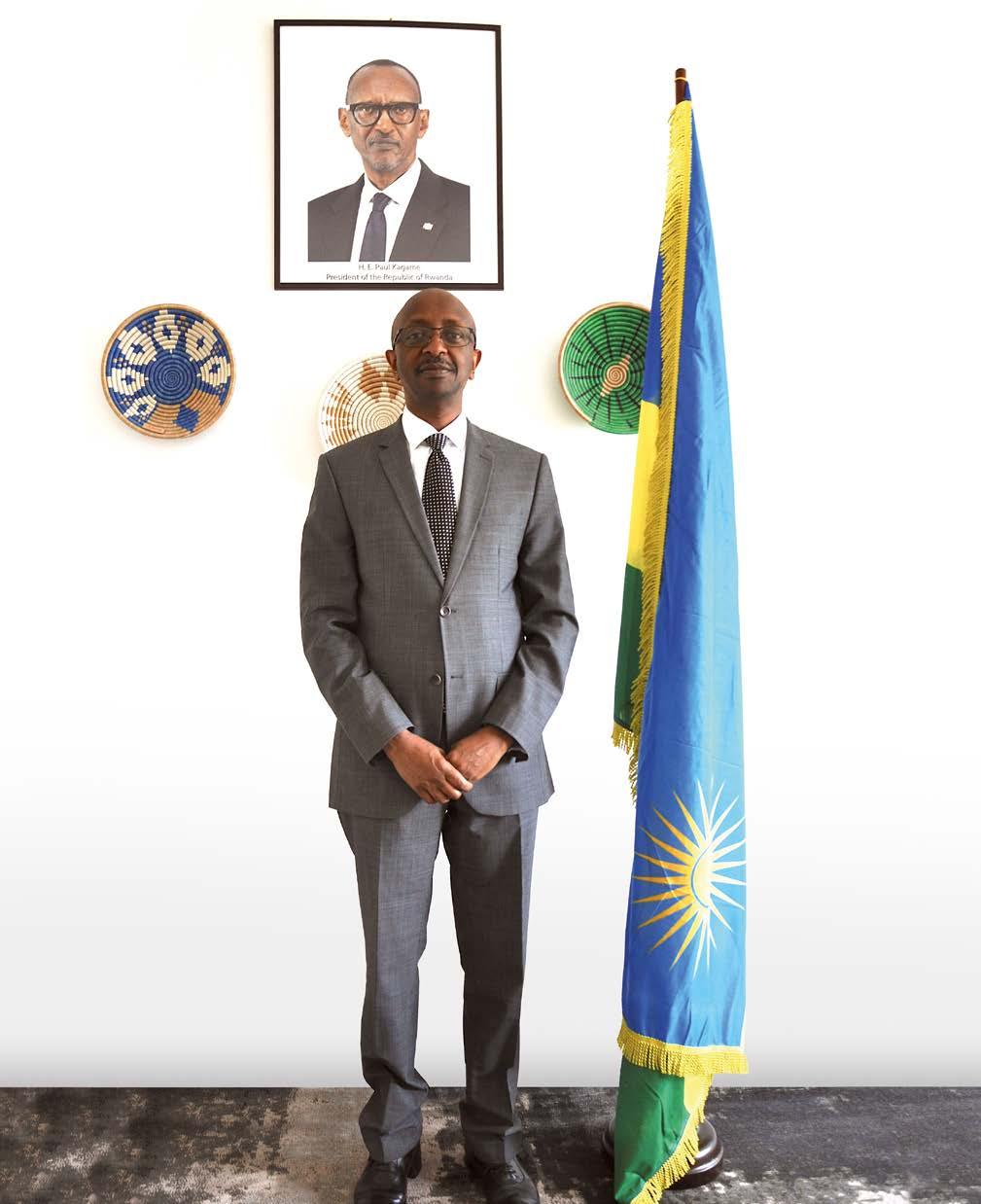
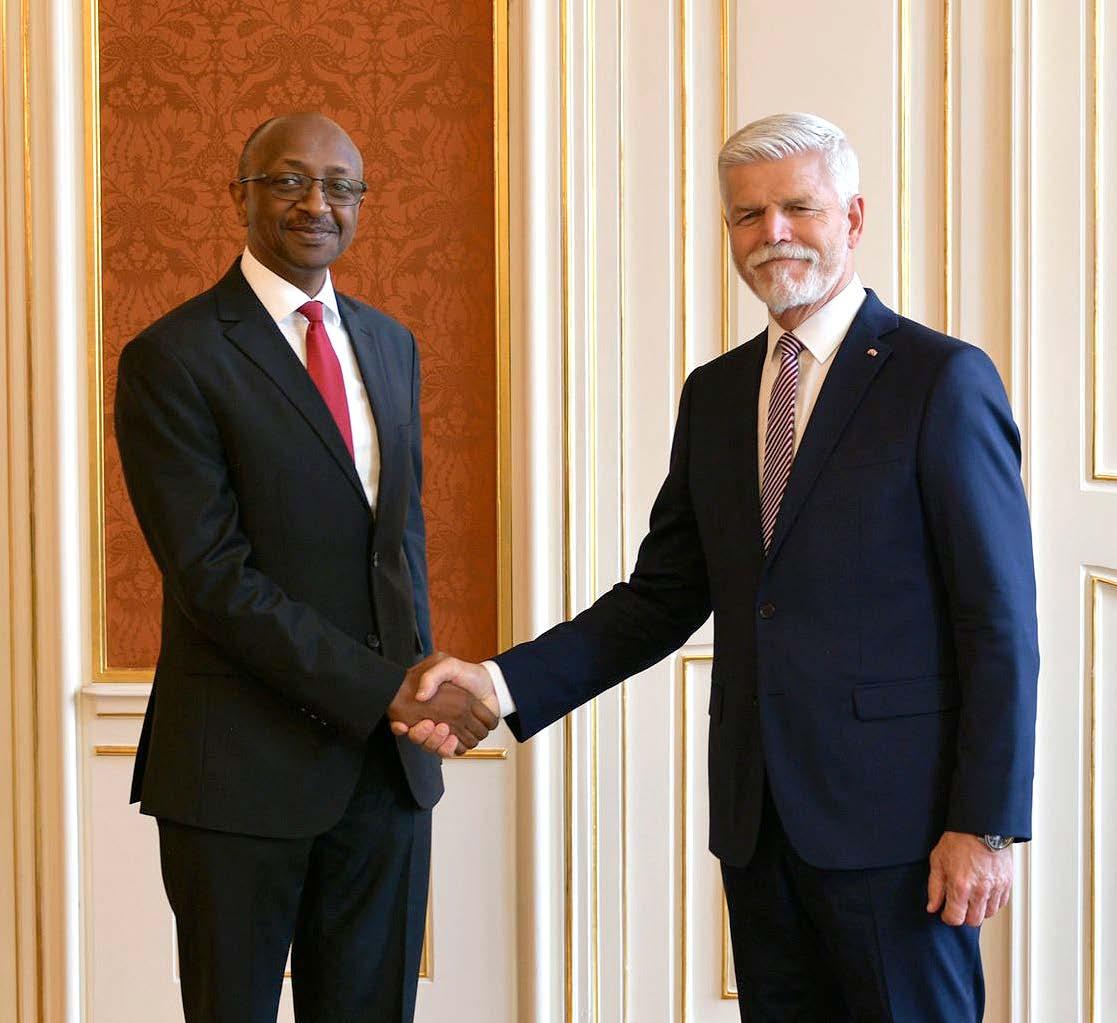
How does the willingness of Rwanda to host immigrants fit your country’s development goals?
Thank you for this question, which has been in the news quite a lot lately.
My country Rwanda has itself been one of the world’s largest producers of refugees. Rwandans share a deep awareness of what it means to flee home. I, myself, and several of my countrymen have been refugees – as I mentioned earlier. We understand what it means to seek safety and opportunity in a new land. For this reason, Rwanda has committed itself to providing
a safe haven to vulnerable people. We have done this for thousands from our neighbouring countries, and even for people as far as Afghanistan and Libya.
And yes, we also understand the role they can play in our national development.
Let’s move to the Czech Republic in our interview now, where you arrived about a year ago to take up the function of an ambassador. What have your impressions been so far?
I arrived in the Czech Republic in August 2023 and was glad it was smack in the middle of summer – when the weather was still very similar to what I was accustomed
to where I was coming from. It gave me time to settle in before the temperatures dropped, after which I adjusted – with some difficulty – to the cold.
The ceremony to present my credentials was most definitely one of the highlights for me. Beyond the very colourful and elaborate event, the opportunity accorded the audience to meet –and briefly engage with – President Pavel during the ceremony, which will remain very memorable.
As I moved around Prague, I was struck by the diverse and beautiful architecture, which is very captivating and takes one back through Central European history.
I also appreciated the obvious sense of security one feels as one goes around the city. I have travelled to several countries, and the sense of safety here is palpable.
Which countries did you serve in before?
The Czech Republic is the second country in which I have served as Ambassador. Prior to this, I was Rwanda’s Ambassador to Kenya for four and a half years.
Does being an ambassador match your personality and character?
I like engaging with people, and hearing others out even when we have very different opinions.
I am also a strong believer in compromise; I am curious and always willing to learn. As an ambassador, one is involved in establishing and sustaining strong relationships between countries so the ability to engage constructively is critical. Also, many times you find that you are dealing with cultures and backgrounds very different from your own so it’s important to be a good listener, and, when you have differing opinions, it is important to have principled compromise.
What do you see as the most difficult part of being an ambassador?
As a diplomat, the biggest challenge is keeping up with the trends and pace in a fast-evolving world. You cannot afford to be behind in terms of the news cycle because it directly impacts your work.
How do you spend your free time?
I like to spend time with my family. I also like to read, occasionally
watch a movie, and, here in Prague, I enjoy exploring the city.
Do you promote your country as a holiday destination, and if so how?
Rwanda promotes itself as a holiday destination for Czech tourists through strategic collaborations with travel agencies, digital marketing campaigns, cultural exchange programs, and participation in travel fairs. While most efforts have traditionally focused on the broader European continent, the opening of the Embassy in the Czech Republic allows for a more targeted approach to attract Czech tourists specifically.
Additionally, Rwanda’s global influencer collaborations and partnerships with major football clubs such as Paris Saint-Germain, Arsenal, and Bayern Munich significantly enhance its visibility. Events such as Kwita Izina, the annual naming ceremony of newborn gorillas, feature renowned public figures and are broadcast internationally, further boosting Rwanda’s profile as a premier travel destination.
The country’s renowned attractions include mountain Silverback gorillas in the Volcanoes National Park and Safaris in Akagera National Park, to only name a few. Rwanda’s strong emphasis on safety makes it an attractive destination for high-profile visitors, whose social media endorsements further boost Rwanda’s appeal. To reflect this safety, Rwanda has been ranked 2nd safest country worldwide for women to travel to, after Slovenia.
Lastly, Rwanda focuses on sustainable tourism practices, supporting local communities and conservation efforts.
In June 2019, as part of Rwanda’s conservation efforts, Rwanda and Czechia achieved a historic
milestone with the largest-ever translocation of rhinos from Europe to Africa. Five critically endangered eastern black rhinos were successfully relocated from the Czech Republic’s Safari Park Dvůr Králové to Rwanda’s Akagera National Park. This initiative has been highly successful, increasing the park’s rhino population to over twenty and contributing to the expansion of the species in their natural habitat.
In July, Rwanda celebrates its National Day. What are your thoughts on this occasion?
The National Day we remember this month of July is the liberation of our country on July 4th, 1994, when the genocidal regime and the Rwanda Armed Forces were defeated by the Rwanda Patriotic Front, ending the genocide against the Tutsi. Rwanda moved from being led by oppressive regimes – which espoused politics of division – and embraced democracy and participatory politics. What I wish for my country is that we as Rwandans continue to rally behind our leadership, preserve national unity, and continue contributing to national development.
The peace and stability we enjoy were won at a very high price, and this can only be sustained by continuing to work together and with determination.
To quote my President: “The endpoint of the liberation struggle was to build a state in which each of us is valued, and citizens are always at the centre of government.”
Regarding the Czech Republic, my desire is that our relationship continues to grow, and develops into a long-term partnership that is mutually beneficial, with clear economic and political goals.
Dear readers,
I joined the diplomatic service of the Republic of Moldova three decades ago and had quite interesting experiences over the years, but the last four years in Prague were certainly fulfilling, with professional challenges and achievements.
I enjoyed my posting in Prague, and I learned a lot. I experienced the world health pandemic crisis with its restrictions and curfews, witnessed the general elections and change of the government, the election of the new president, the start of the Russian war of aggression against Ukraine and the refugee crisis, and the Czech EU Council Presidency. And all of these had an impact on Moldova and our bilateral relations.
Looking back to those wonderful years in Prague, I am very glad to mention the significant development of Moldo-Czech relations and the pleasure of discovering the rich cultural and natural heritage of my host country.
The enhanced political dialogue, economic cooperation, and cultural exchanges – and especially the support for Moldova’s EU accession process – were priorities on my agenda over the last few years. The multiple high-level visits both to Prague and Chișinău provided several occasions to express the Czech support for Moldova’s resilience and its future in the EU family, as well as launch important bilateral cooperation initiatives.
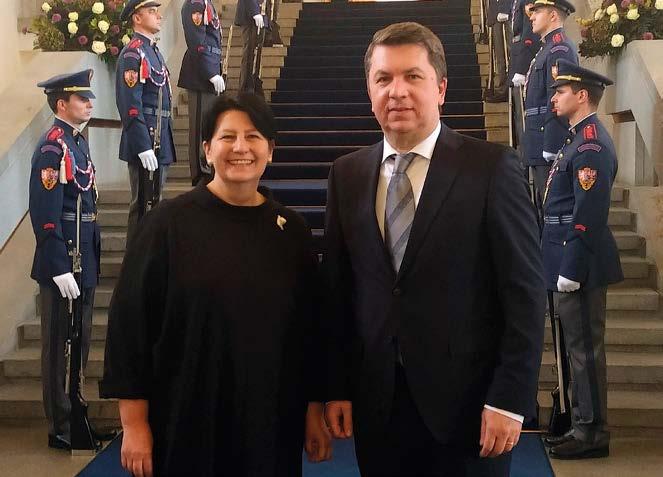
Given the growing interest in bilateral cultural exchanges and people-to-people contacts, I was glad to participate in the launching of the direct flight connecting Chișinău and Prague, support the first-ever performance of the Moldova National Theatre at a theatre festival in Prague, open the Moldo-Czech exhibition at the National Art Museum in Chișinău and the Moldovan exhibitions at the Municipal Galleries in Brno and Tábor, and organise the Moldovan concert at the Academy of Performing Arts in Prague to celebrate the official launching of EU accession negotiations with the Republic of Moldova.
I am honoured to have also been accredited from Prague as a non-resident Ambassador to the Holy See.
I am grateful to the Czech institutions’ officials for the good
relations and valuable cooperation over the years, as well as to many Czechs I met on various occasions during my tenure. I have happy memories of the time spent with my Diplomatic colleagues, and count many of them as friends. Thank you for your friendship and support!
Together with my wife Svetlana, we were delighted to visit many towns and world heritage places in Czechia, but above all appreciate the marvellous Prague, full of history, architecture, music, and breathtaking panoramas. “Prague never lets you go... this dear little mother has sharp claws” is a famous quote from Franz Kafka. The magnificent Prague will remain forever in our hearts.
La revedere, na shledanou!
Alexandru Codreanu
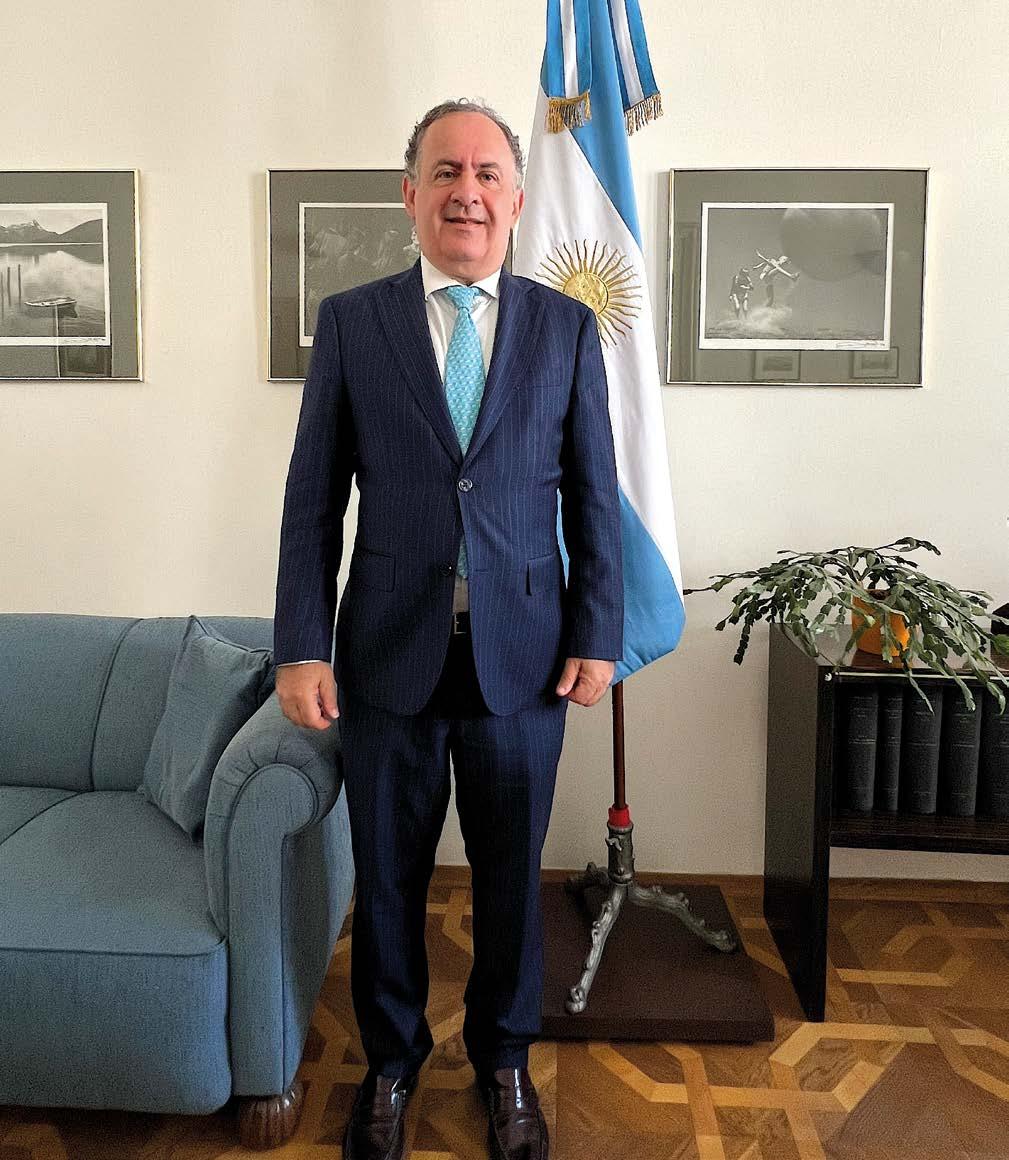
“This is a fundamental year in our diplomatic relations, marking its 100th anniversary,” says H.E. Mr. Claudio Javier Rozencwaig, Ambassador of Argentina. “President of Argentina visited the Czech Republic in June, the first in 100 years to do so, and my objective as an ambassador is to deepen those ties that unite us.” Prague is Mr. Rozencwaig’s first position in Central Europe, and, as he puts it, “a place, currently, very important due to the international context”.
Can you tell us a few words about yourself?
I am Claudio Rozencwaig, I am married, and I have a 14-year-old daughter. I am a lawyer who graduated in Buenos Aires, and, since last year, the ambassador to the Czech Republic.
What made you become an ambassador?
I studied law in Buenos Aires, was in Milan at the Istituto Per gli Studi di Politica Internazionale (ISPI) for one year as a researcher on the diplomatic relations between Italy and Argentina, and then attended Luigi Bocconi University, where I took some specialization courses.
I then entered the diplomatic career in 1994. I was always interested in international relations, as well as in collaborating on bringing together countries and peoples. That was the key to why I chose to be a diplomat. During my career, I was Ambassador to the FAO, IFAD, and WFP in Rome, Ambassador in Tunisia, Undersecretary of Foreign Policy in Buenos Aires, and have now been Ambassador to the Czech Republic for almost a year.
You took your position in the Czech Republic less than one year ago. How has it been so far?
It has been very interesting arriving in Prague, my first position in Central Europe –
a place, currently, very important due to the international context. I arrived during the centenary of the diplomatic relations between our countries, which meant that I had to immerse myself in the preparation of political, cultural, and economic-commercial events. My objective has also been to quickly contact the Czech authorities, businessmen, politicians, the press, cultural and scientific actors, and other sectors to deepen those ties that unite us.
Which countries did you serve in before?
I have served twice in Italy – first as a Secretary and Counsellor in our bilateral embassy, and many years later as Ambassador to the
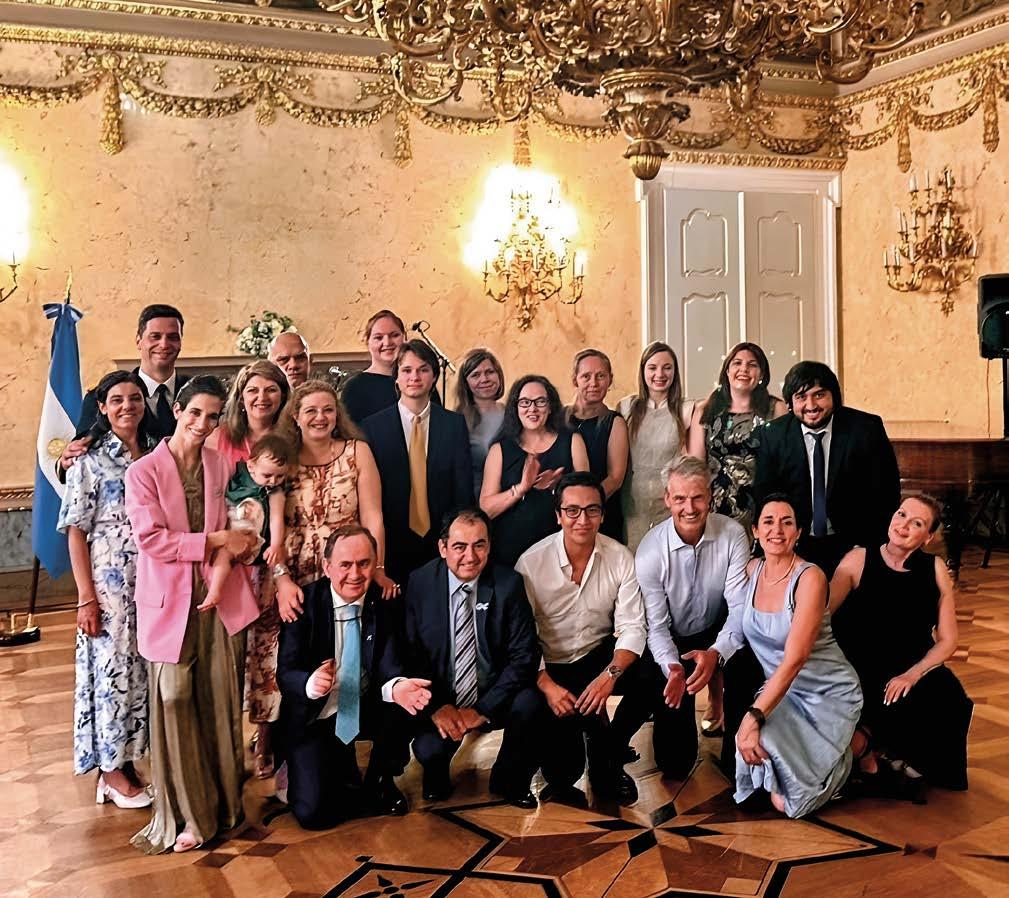
FAO, IFAD, and WFP. I therefore know that country very well, and love it very much, especially Rome, and I married an Italian woman as well.
As I already mentioned, I was also Ambassador to Tunisia, a country with an immense historical and cultural heritage, to which I am also very attached.
Does being an ambassador fit into your lifestyle?
Being a diplomat is a way of living, which affects your personal life, marital life, and children. It is a great responsibility because you represent your country. It is a great honour, but also a great responsibility. I think I enjoy it a lot, but it has had a very big impact on my private life.
Have you had any unusual adventures during your career?
I don’t know if it’s an adventure, but work trips to the most remote places in the world have been something that I carry in my heart. In Africa, in Asia, they have taught me many lessons. But I’ve never been bitten by an animal, or hit a car, or that sort of thing.
What, in your opinion, is the most difficult part of being an ambassador?
The most difficult thing about being an ambassador is that you can never unplug or disconnect. You are an ambassador 24 hours a day, 7 days a week. This represents a different dimension of life.
When you do have free time, how do you spend it?
I really like travelling by car, seeing places and different people, and trying different foods. I also really like reading and watching television, especially historical movies.
I am curently taking the opportunity to explore this wonderful country, not only Prague (which is a fantastic city) but also Brno, Český Krumlov, Kutná Hora, Karlovy Vary, and the entire interior of the country.
Can you give a piece of advice to the next generation of ambassadors?
Two or three tips for the new generation: Love this job very much, because otherwise it is impossible to enjoy it. Be clear about the objectives of a meeting, a visit, or a negotiation, and study a lot before each event and meeting. Finally, for this job it is necessary to have a lot of patience – it is a long-distance race, where nothing can be taken for granted.
Czechia and Argentina are marking their 100th anniversary of diplomatic relations. How is this being celebrated?
This is a fundamental year in our diplomatic relations. We started on January 8th, with an event at the Ministry of Foreign Affairs featuring Vice Minister Jiří Kozák. We continued with Minister Lipavský’s trip to Buenos Aires in April, after which came the visit of the Speaker of the Chamber Jan Skopeček, Minister Ženíšek (former President of the Commission of External Affairs of the Chamber), and other deputies to my country.
We had the visit of President Javier Milei to the Czech Republic in June, the first Argentinian president in 100 years to travel to this country, who met Prime Minister Fiala and President Pavel, and also received an award.
We also had significant participation in the Book Fair, had organized the Malbec World Day, are going to organize a film festival, and we hope to have other visits in
the latter half of 2024, as well as during 2025.
I think it is a year of relaunching bilateral ties, where both parties have great hopes of strengthening relations in the future.
Bilateral ties may be strengthened through holiday travel as well. What would you recommend to a Czech tourist visiting Argentina?
Go to the end of the world and you will find the Iguazu Falls, the Perito Moreno Glacier, and an open and welcoming people. Have lunch or dinner with an excellent Malbec wine and the best meat in the world, take the opportunity to go to the stadium to watch a soccer game, and end up dancing the tango! All of this and more you can find in Argentina.
Can you evaluate the current state of Czechia–Argentina relations?
Relations between our two countries are excellent at the moment. These relations are celebrating their 100-year anniversary with a political relaunch, a presidential visit, common visions in foreign policy, huge collaboration in international organizations, and a growing interest in increasing trade and investments in various areas such as technology, medical equipment, energy, mining, and others.
This interview is also done to mark Argentina’s National Day. What do you wish for on this occasion?
On this Independence Day, I hope that both countries can walk together on a path of peace and prosperity, affirming our common values of defence of democracy, freedom, and human rights.


On the occasion of Argentina’s National Day, and 100 years of diplomatic relations between the Czech Republic and Argentina , the Ambassador of the Argentine Republic H.E. Mr. Claudio Javier Rozencwaig hosted a special reception at the beautiful Kaunický Palace. We bring you the speech he gave to the guests.
Mr. Eduard Hulicius, Deputy Minister of Foreign Affairs of the Czech Republic was the honored speaker.
Today we celebrate our Independence Day and, on this special occasion, we also commemorate a significant step in our diplomatic history: 100 years of diplomatic relations between our two countries.
A century ago, Argentina and Czechoslovakia began a relationship that, over the years, is full of cooperation and mutual respect. This partnership has been a testimony of how two nations can
work together towards common goals, despite the geographical distance. Our countries have shared cultural, academic and commercial exchanges that have mutually enriched our societies. From collaboration in scientific and technological fields to the promotion of our respective culture.
On this day, we celebrate not only our independence, but also the spirit of collaboration that has characterized our relations with
the Czech Republic. This is an occasion to reaffirm our commitment to the values that unite us: democracy, peace and respect for human rights.
We share views in our external policies. In fact, Argentina is grateful for the support of the Czech Republic so as to finalize the Agreement Mercosur-UE, also to the support of your country so as Argentina could enter on the OCDE, and your support to the Argentina´s will to enter in a global association with NATO.
Also, let me say that we share our firm support to Ukraine and its right to legitimate self-defence in the face of Russian aggression. Argentina is firmly committed to defending international law, and in particular the principle of territorial integrity.
In this centenary, we started with an event at the Černín Palace with the presence of Vice Minister Kozák and we continue with an
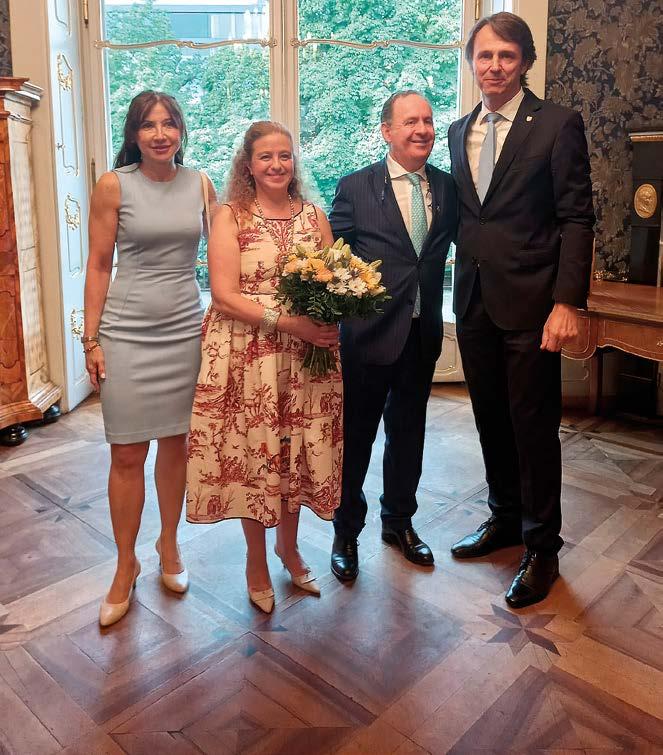
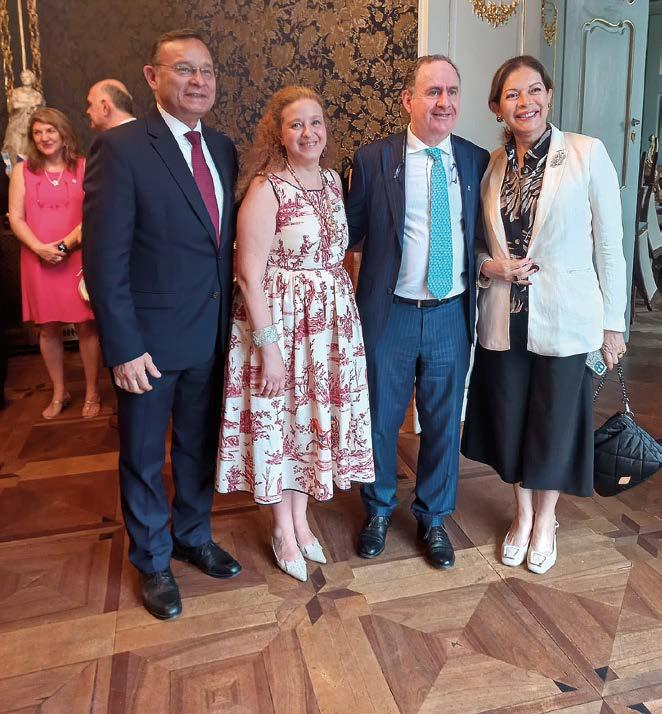
important visit of Minister Lipavský to Buenos Aires, the visit of the Speaker of the Chamber Jan Skopeček and other members of the parliament as the Minister of Science Marek Ženíšek and a few weeks ago the visit of our President Milei to Prague.
It was the first visit of an Argentina´s president to the Czech Republic and it was during this celebration of the centenary, with meeting President Pavel and Prime Minister Fiala. And we also prepare other visit for the second half of the year, and cultural and comercial events.
In addition to the daily tasks of promoting traditional Argentine goods such as beef, wine, and other products, we will focus on consolidating and expanding our economic relations, and actively seeking new facilities for bilateral trade.
We will focus on strengthening cooperation and investments in energy sector and technology, in particular hydrogen, lithium and rare minerals, and also areas like knowledge-based services, creative industries, information and communication technologies, medicine and defense. The visit of Minister Síkela to Latin America, and the possibilities of other high level visits in the forthcoming months are very important and we will work on this.
Viva Argentina!
Viva Czech Republic!

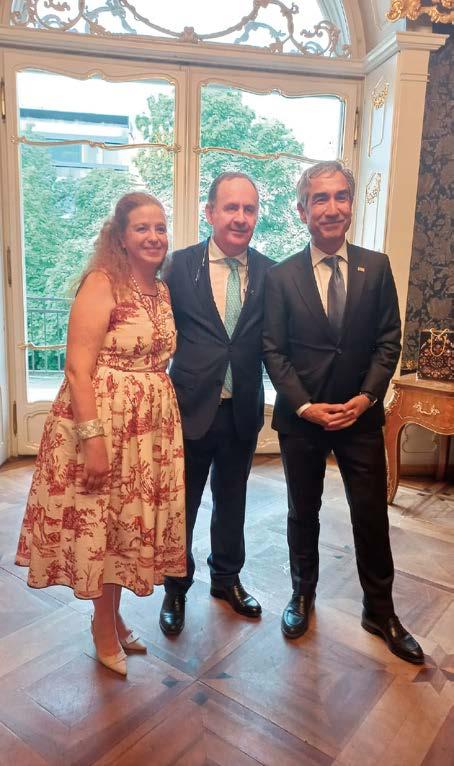

It has been an honor for me to serve Czech-Swiss relations for the past four years. It is indeed a privilege for a Swiss diplomat to represent my country in the Czech Republic, a key Central European country whose importance has been further underlined by the war in Ukraine.
The period of my mission in the Czech Republic has been marked by a series of international crises: the COVID-19 pandemic, Russia’s war of aggression against Ukraine, and more recently conflicts in the Middle East. But, on the other side of the coin, we had the success of the Czech Presidency of the EU Council, with the first-ever EPC meeting held in Prague – something that will forever remain in European history.
Above all, I will take with me the memory of the solidarity of the Czech people, who opened their arms wide to almost half a million Ukrainian refugees, victims of this dreadful aggression by the Kremlin. Half a million at the beginning of the war meant 5% of the total population, the highest rate in Europe.
Due to the Czech Presidency of the EU on the one hand and the Russian aggression against Ukraine on the other, the bilateral political relations at the official level have intensified since the beginning of my mission in Prague. A highlight in this regard will be the State visit of President Pavel to Bern next November, the only State visit my government will organize this year. This visit is aimed, among others, to give the Czech Republic the attention
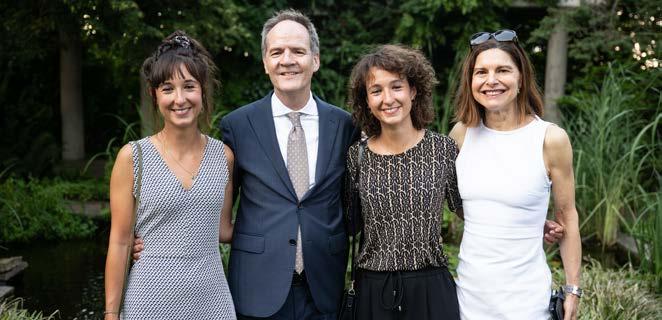
it deserves, whose positions may have perhaps not been sufficiently taken into account in the past, in particular in connection with our relations with the Kremlin.
My four years in the Czech Republic have also enabled me to deepen the historical ties between the Swiss cantons and the Czech lands. As a child of the Cold War, I knew very little about the history of countries and regions beyond the Iron Curtain.
Let me just give you an example of how deep our historical ties are. I graduated in my 35,000inhabitant hometown of Fribourg, whose college was founded in the 16th century by the Jesuit Pierre Canisius, the same Pierre Canisius who founded the Klementinum in Prague a few years earlier. Another example – it was an Italian-speaking Swiss who was the architect of the 17th-century Baroque Černín Palace, currently the Czech Foreign Ministry’s headquarters. There are dozens of these examples that you can discover in a book by Swiss historian Denis Dumoulin published by Czech editor Argo, entitled “Mezi českým Ivem a helvétským křížem”.
It is with a lump in my throat that I am closing the Czech chapter of my career. And this chapter is particularly important as it marks the end of my career – a 35-year career that has taken me to Paris, London, Luxembourg, Brussels (European Union), Belgrade together with Podgorica, and finally Prague.
Nothing in the world would have made me prefer a different career. But I cannot hide the fact that, after 35 years, I feel like I am closing the loop. And I am very much looking forward to my new post-professional life, which will be re-oriented towards arts, visual arts, and performing arts. But don’t worry, I am not going to be on stage, but only behind the stage curtain.
For sure, Prague and the Czech Republic will remain deeply anchored in my heart, as well as in my spouse Françoise’s heart.
Vive la Suisse! At’ žije Česká republika! Long live Switzerland and the Czech Republic!
Prague, 1st August 2024

Can you tell us a little bit about your background?
I was born in Hanoi, the Capital City of Vietnam. I studied English and Economic Management at the Hanoi University for Teachers of Foreign Languages (HUTFUL) and the National Economic University of Vietnam, respectively. I then got a Master’s degree in international relations at George Washington University in the United States.
I have served as a career diplomat for over 30 years now and have held a variety of roles such as America Desk Officer, Economic and Trade Negotiator, and Spokesperson and Interpreter for top leaders of Vietnam. For my career journey of over 30 years I have been to many countries, experiencing different cultures and meeting with a lot of people. I always find my job exciting and rewarding.
Having served as a career diplomat for over 30 years now, H.E. Mr. Duong Hoai Nam commenced his duty as Ambassador of Vietnam to the Czech Republic in March 2024. As the Ambassador says in our interview, this is his first time in this beautiful country, and he assures us that he is “proud to represent my country in the Czech Republic, particularly at a time when the two countries are making preparations to celebrate their 75th anniversary of diplomatic relations.”
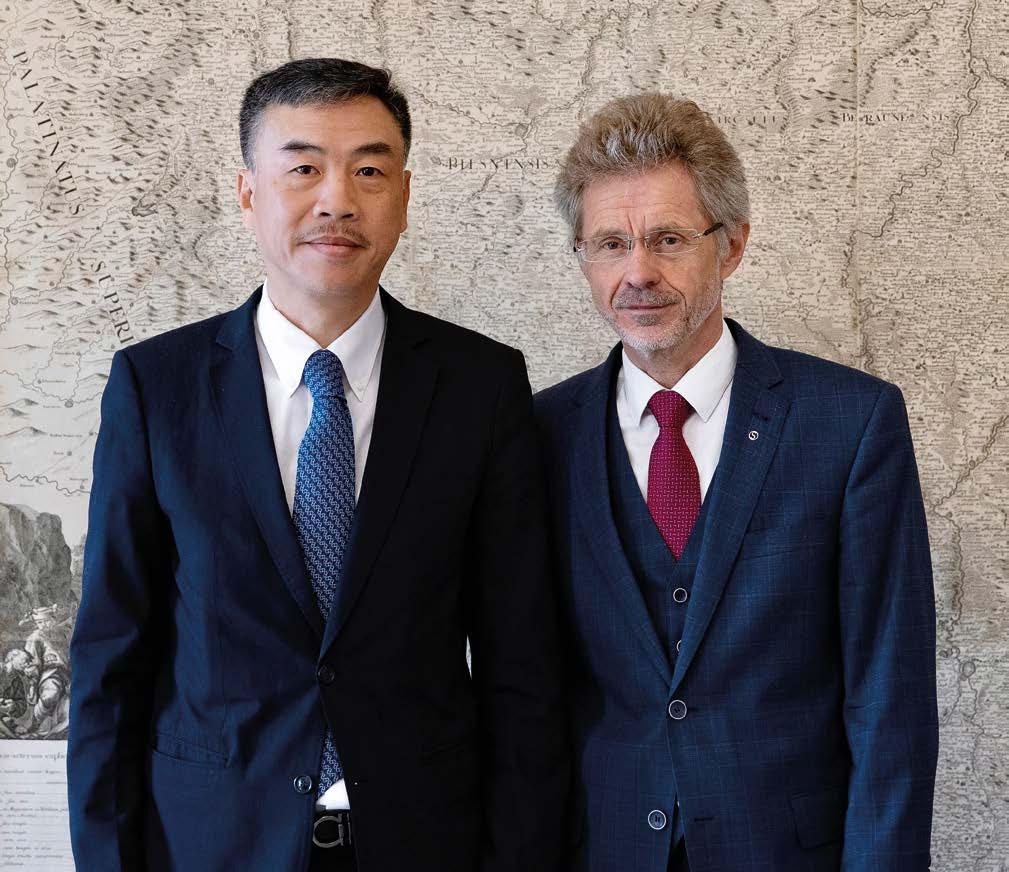
If asked to highlight the most exciting adventure of your professional career, what would you talk about?
Being part of the Vietnamese team responsible for UN Security Council issues during Vietnam’s first time as a non-permanent member of the UNSC (2008-2009) was truly a challenging and intense time for me. We had to engage in debates and express our positions on a series of sensitive issues which have the thin line between right and wrong, such as between secession and national self-determination, or between terrorists or freedom fighters, just to name a few. And, I think I have learned a lot from such interesting philosophical arguments.
You now represent your country as an ambassador. What made you assume this role?
Throughout my entire career, I have tried to accumulate experience and develop extensive skills in various aspects of diplomacy. I think that my dedication to and passion for the job have made me become an ambassador.
Until now, I have served as a diplomat in three countries, namely the United States, Australia, and now Czechia. Each country always leaves deep imprints on my heart.
You commenced your duty as Ambassador of Vietnam to the Czech Republic in March 2024, which makes
it just a few months ago. Can you share some of your impressions so far?
This is my first time in this beautiful country. I am very impressed with the ancient and unique architecture of Prague. It is unique in the sense that Romanesque, Gothic, Renaissance, Baroque, and Rococo architecture can be found throughout the city. It is also worth mentioning that Czech people are very friendly and open-minded.
I am proud to represent my country in the Czech Republic, particularly at a time when the two countries are preparing to celebrate their 75th anniversary of diplomatic relations. Both Vietnam and Czechia are working
very closely together to bring this relationship to new heights on this occasion.
Does your current role seamlessly fit into your lifestyle?
I can tell you that being a diplomat is exciting. It also involves a lot of hard work and a great deal of selflessness. We, as diplomats, do
not work for ourselves – we work for our country and people. This responsibility can, at times, be crushing to bear. But it is so worth it when things go well and our interests are advanced.
Regarding my free-time activities, I must say that as Ambassador I don’t have much of it. Playing golf and meeting with my fellow
Vietnamese in Czechia on the weekends are my favourite activities of choice.
What do you feel is the most difficult part of being an ambassador?
Although being an ambassador is rewarding in many ways, one of the most difficult things is being
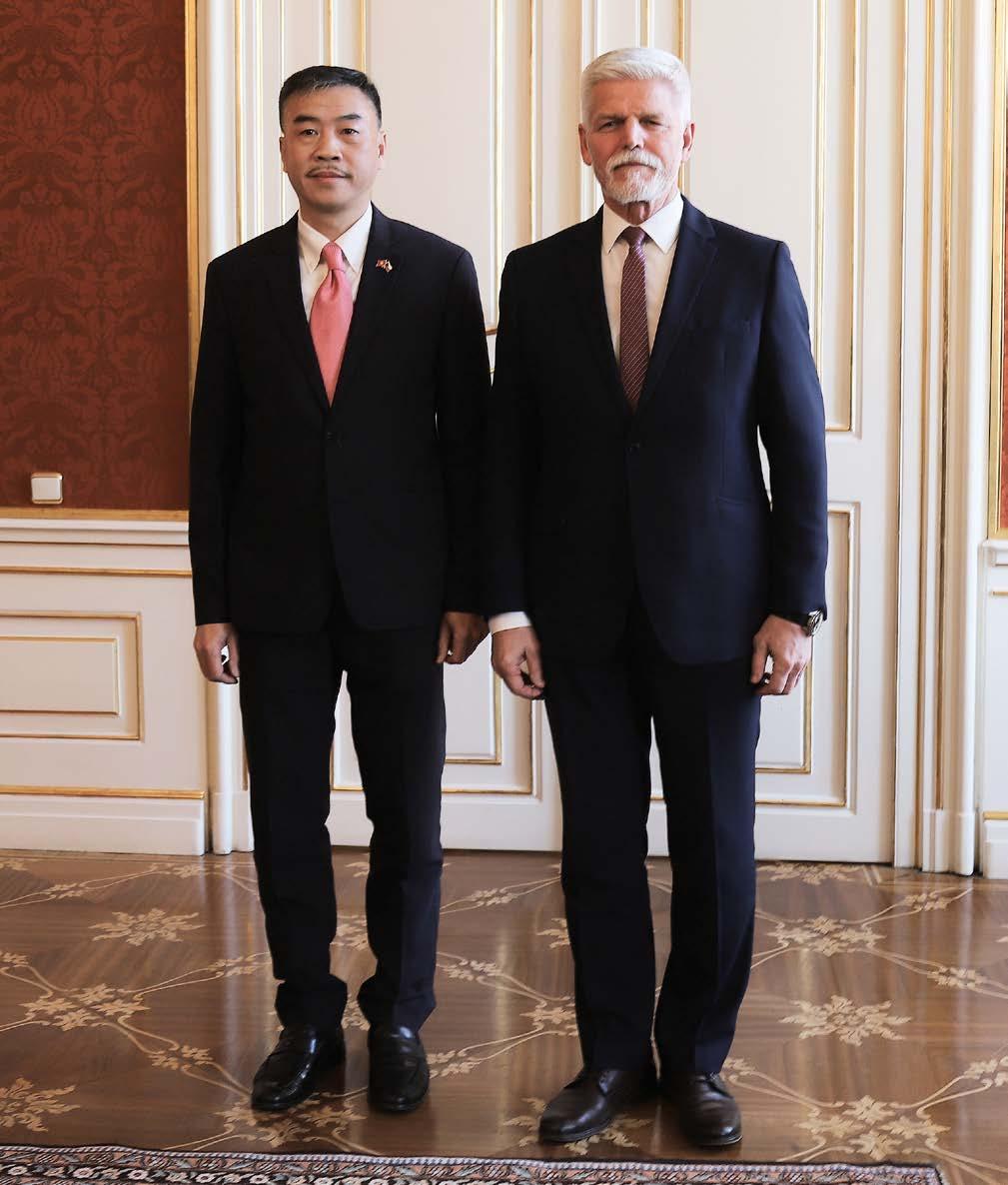
away from our home country, friends, family, and everything we are accustomed to. It is simply because this job often requires frequent relocations, sometimes to remote or politically unstable regions, which can disrupt our personal lives. It is also difficult for our kids to immerse themselves in frequently changing learning environments.
Can you give a piece of advice to the next generation of ambassadors?
Being an ambassador requires a high level of professionalism, cultural sensitivity, and the ability to adapt to new environments. It can be a challenging and rewarding career for those who are well-suited to it. So, my advice to them is that passion, dedication, and hard work make for an excellent Ambassador.
Vietnam has one of the biggest Skoda Car factories outside of the Czech Republic. Are there any plans for enhanced cooperation between the two countries?
Vietnam and the Czech Republic are enjoying a time-tested friendship and multifaceted cooperation. The two economies are highly complementary, which promises broad prospects for stronger cooperation, particularly in areas where each country has the edge.
For Czechia, these areas can be manufacturing, mining, heavy industry, chemical industry, pharmaceutical production, education, and training. For Vietnam, its strengths include information technology, agricultural products, garment and textiles, footwear, culture, and tourism.
Choosing our holiday destination to enjoy ourselves to the fullest is a high priority
for many Czech people, and it seems Vietnam has been gaining in popularity. How do you promote your country?
As you know, Vietnam is renowned for its stunning landscapes and rich cultural history, and is home to many UNESCO World Heritage Sites. The country is endowed with many beautiful white-sand beaches. And it is also worth mentioning that Vietnamese food has been conquering millions of food lovers around the world.
A direct flight between Vietnam and Czechia, once established, will untap the huge potential for connectivity and cooperation between the two countries.
Can you evaluate the current status of Czech-Vietnamese relations?
The relationship between Vietnam and the Czech Republic has been constantly flourishing across the board over the past decades.
Now, fast forward to 2025: We are on the eve of the 75th anniversary of our diplomatic relations, and have a trade relationship that has reached a record high of US$ 2.9 billion in 2023. That is more than 10 times greater than a decade ago. Vietnam is proud to be Czechia’s largest trading partner among the ASEAN Member States.
We want to see this continue to grow. As I mentioned earlier, a direct flight between the two countries will significantly deepen our trade and investment ties, as well as people-to-people exchange.
In other areas, we have very beneficial and cooperative relations across the full spectrum of issues, whether it is defence and security or climate, energy, education, culture, labour, and virtually any area you can think of.
And, of course, we are very proud of the fact that we have about 100,000 Vietnamese people residing in Czechia. The Vietnamese community has made outstanding contributions to Czech society since it was recognized by the government as the Czech Republic’s 14th ethnic minority group in 2013. They truly serve as a bridge that fosters a closer bond between our two countries.
Vietnam and the Czech Republic are working very closely together today, and I think what has driven that growth over the last 10 years – and will continue to drive it –is our shared realization that Vietnam and Czechia are good for each other, and that our cooperation benefits peoples of both countries.
To conclude, what are your wishes for your home country of Vietnam, and for your host country of Czechia?
Elevating the Vietnam-Czech Republic relationship to new heights is always high on my agenda, especially in 2025 when our two countries celebrate their 75th anniversary of diplomatic relations. This has been my ardent desire since I commenced my duties in Prague, back in March, and I will do my utmost to make it become true as this will bring benefits to our two countries and peoples.
I also wish our bilateral ties will be ever stronger, and that our two countries and peoples will continue to enjoy peace and prosperity!
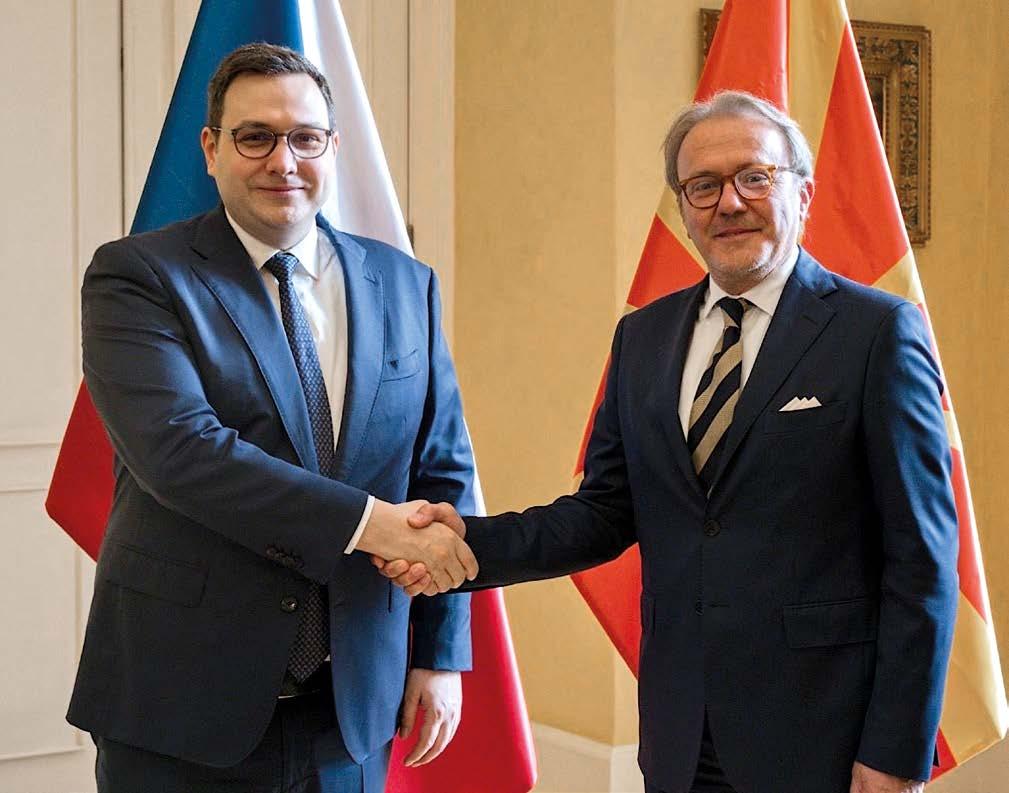
Can you tell us about yourself?
During my childhood, I was surrounded by different types of newspapers, as well as magazines, books, and encyclopedias. I lived in the centre of Skopje in a building where many journalists, editors, directors, and diplomats lived. My father was the editor of Kultura, a famous Macedonian Publishing House, and later on, of the Lexicographic Institute Miroslav Krleža in Zagreb. These circumstances
H.E. Mr. Emil Krsteski, Ambassador of North Macedonia to the Czech Republic appointed since December 2023, has engaged in writing, foreign policy, and international relations throughout his career, including writing six books on international relations. When speaking about the relations between North Macedonia and Czechia, he describes them as “excellent and friendly”, highlighting the fact that the Czech Republic “was one of the first countries, after the fall of the Berlin Wall, to clearly define its strategic goals –membership in NATO and the EU. Now, it is North Macedonia who deserves to become a member of the EU, and the Czech Republic firmly, openly, and unreservedly supports us on our path to EU integration, as it did with our NATO membership.”
seemed to predetermine my profession as a journalist, and I have been professionally engaged in writing, foreign policy, and international relations throughout almost my entire career. I have been writing and publishing short stories and poems since elementary school. In Skopje, I studied journalism at the Faculty of Law of St. Cyril and Methodius, the State University, where I received a Master’s Degree in International Law and International Relations, as well as a Doctorate in Political Science (international politics).
I worked as a journalist and editor for Macedonian Television, the daily newspaper Nova Makedonija, and the political weekly PULS, which I co-founded. I was a correspondent for TANJUG, and later served as a State Advisor for Foreign Policy and International Cooperation in the Cabinet of the President of the Macedonian Assembly for twelve years. I was the Director of the State Archives for nearly five years, and, since December 2023, I have been appointed as Ambassador Extraordinary and Plenipotentiary to the Czech Republic.
What made you become an ambassador?
All my work experience in foreign policy, filled with many trips and following international events, as well as my education and the six books I have written on international relations, were sufficient signposts leading me to the door that opens the horizon of diplomacy.
You have been in the Czech Republic for over eight months. Can you share some of your impressions?
I was fortunate that just two weeks after I arrived in Prague on February 15th, I presented my Credentials to the Czech President,
Petr Pavel, and soon after had an official meeting with the Minister of Foreign Affairs, Jan Lipavský. The presentation of the Letters of Credentials at the Presidential Palace was conducted with the highest honours and a perfectly organized ceremony, during which the Macedonian flag flew on the roof of the Palace, the military band played the Macedonian anthem at the entrance, and I passed and greeted the military guard before entering to meet President Pavel. This solemn moment and the almost half-hour conversation with President Petr Pavel will remain deeply engraved in my memory.
Do you manage to enjoy Prague during your free time as well?
In Skopje, I usually play tennis two or three times a week, ride my bike in the morning, paint, write short stories, listen to good music... I find time for everything.
Unfortunately, due to my significant responsibilities as an Ambassador, I haven’t been able to maintain these activities in Prague. Usually, during the weekends, I am in contact with my son who lives and works in Berlin with his wife and my granddaughter, and with my daughter in Skopje. I also read non-fiction and fiction, take walks with my spouse Ana in the parks in and around Prague, and prepare lunch. I’m learning Czech. I don’t watch TV at all, except for parts of the world hockey championship held in Prague and Ostrava, and, of course, tennis sometimes.
Does being an ambassador fit your lifestyle?
I openly say that I perform this position with pleasure and dedication because, from the very beginning of my career, I have had the opportunity to constantly engage with politicians
and diplomats and successfully prepare and publish analyses of international relations. It’s kind of second nature to me, and I do it with passion.
Which countries did you work in before your current post?
As a journalist-editor and state advisor in our Assembly, I travelled extensively. I also had several study visits, lasting a few months each, at institutions such as the International Court of Justice in The Hague, the Institute for European and International Studies in Luxembourg, Harvard University in Boston, the NATO Assembly in Brussels, the Marshall Center in Garmisch-Partenkirchen, and twice in the USA at the invitation of the State Department, obtain a Diploma as the Ambassador of Good Will of Arkansas in the world, sing by President Bill Clinton. I was also a guest of the British Consul in London, as well as the Inter Nations of Germany. While working in the Cabinet of the President of the Assembly, I was an official guest of the Italian, Austrian, Swiss, and Swedish Parliaments.
However, my greatest diplomatic experience was the four-year following of the sessions of the European Parliament in Strasbourg, and the three-year stay in New York, where I collaborated with the International Peace Institute and completed my doctoral dissertation on American foreign policy at the beginning of the 21st century, the Mediterranean, and the Arab Spring.
Have you ever dealt with any weird situations in your professional life?
While I was an Adviser on Foreign Policy, among other things, I wrote speeches for the President of the Parliament. Once, I had to write a speech for an International conference in which the President
was supposed to participate and address, unplanned. I had less than 24 hours to prepare, and the topic was quite complex. I started working in the Cabinet but took the diskette home to continue writing the speech in the afternoon. At one point late in the evening, I pressed a button on the computer, and the entire text disappeared. I felt my blood run cold. I immediately called my son, who was good with computers, for help and started shouting in a panic: “My career is going to fail, I have to find the text, I don’t have time to start from the beginning, the text should be ready early in the morning.” I repeated this several times while my son worked on the keyboard. For those fifteen minutes, until my son recovered the text, I was in a real panic and thought my career was in jeopardy. But, in the end, everything turned out well.
North Macedonia is a NATO member and wants to join the EU. Do you feel there is strong support for your country on that path?
Many EU member states support the enlargement of the Union to include the countries of the Western Balkans. The Czech Republic firmly, openly, and unreservedly supports us on our path to EU integration, as it did with our NATO membership. This was particularly confirmed during its presidency of the Union in the second half of 2022, when North Macedonia received substantial help from the Czech Republic in protecting our southern border from the wave of migration and signing the agreement with FRONTEX, the first agreement signed with the EU in the Macedonian language.
This year, the Czech Republic also marked its 20th anniversary of joining the EU, during which President Petr Pavel emphasized the need for the EU to continue
the process of enlargement, help Ukraine and Georgia, and not forget the countries of the Western Balkans. The Czech Republic and some other countries are against setting bilateral issues and problems as conditions for obtaining a date to start negotiations with the EU.
Can you evaluate the current status of Czechia-North Macedonia relations in more detail?
I can state with great pleasure that we have excellent and friendly relations with the Czech Republic on a political, economic, and cultural level. It significantly facilitates the work of an Ambassador when there are no open and disputed issues with the host country. Instead, there is understanding and cooperation, both bilaterally and multilaterally. I became even more convinced of this last fall during my preparation for the defence of theses and assuming the duties of Ambassador in Prague, when I visited and spoke with the highest representatives – or those responsible for international cooperation – in all our ministries.
The Czech Republic is a respected and influential country in the international community, both in international organizations and within its political-security, economic, and cultural influence in Europe. Its role in NATO’s eastern wing is significant, especially after the outbreak of the war in Ukraine and the condemnation of Russian aggression against this country. It was one of the first countries, after the fall of the Berlin Wall, to clearly define its strategic goals – membership in NATO and the EU. The Visegrad group of countries (the Czech Republic, Poland, Hungary, and Slovakia) was then formed, which, by demonstrating successful political and economic regional cooperation, decided to adopt Western values, laws, and norms and join NATO and the EU.
The Czech Republic firmly, openly, and unreservedly supports us on our path to EU integration. This was especially confirmed, as I mentioned earlier, two years ago during its EU presidency, when the Western Balkans countries greatly benefited from their European integration efforts. The Czech Republic is one of our largest equipment donors for security purposes, particularly for controlling and preventing illegal migration.
Apart from political-security cooperation, I want to emphasize the possibility and mutual interest in expanding economic and cultural cooperation. In addition to my regular contacts with representatives of the Czech Ministry of Foreign Affairs and other political entities following and reporting on current situations and events in the country, I also have regular cooperation with the Ministry of Industry and Trade, whose minister visited North Macedonia in the spring. In Brno, as the main business and fair city, opportunities are opening for business contacts with the participation of our companies in those fairs, as well as attracting larger Czech investments in our country and establishing the Macedonian-Czech Chamber of Commerce business association, for which specific steps have already been taken.
At the end of March, in the National Gallery of Prague, I opened an exhibition of paintings, sculptures, models, and photographs owned by the Museum of Contemporary Art of North Macedonia, which lasts until the end of September. All these works presented at the exhibition, including works by important Czech authors, were donated to our Museum of Contemporary Art after the catastrophic earthquake
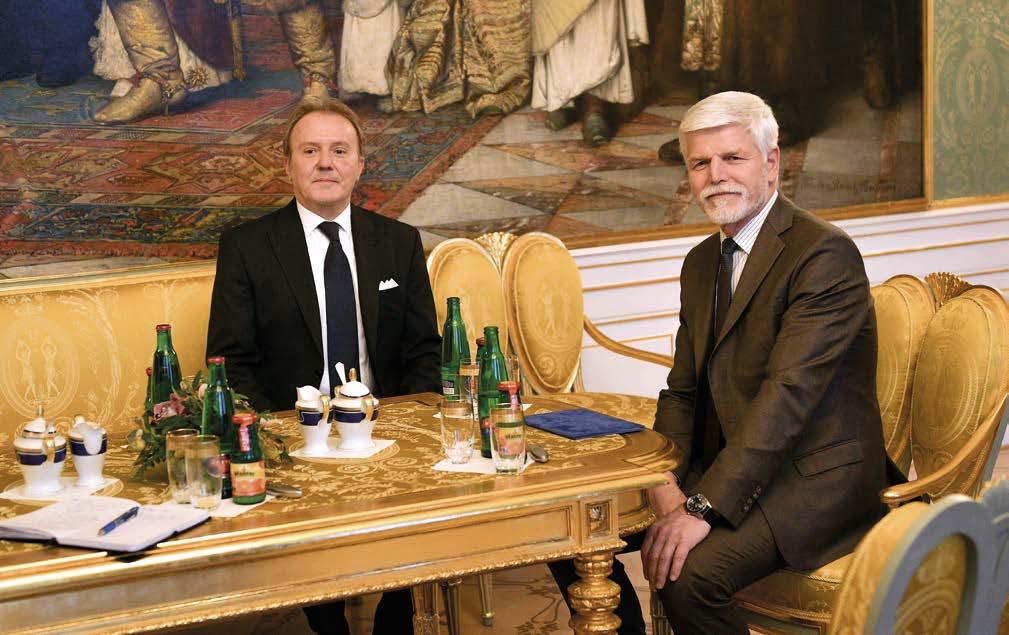
in Skopje in 1963, when our capital was the world centre of solidarity. I expect such and similar cultural events to occur more often and strengthen cooperation between the two countries, as building such bridges of cooperation brings the two countries and their people closer. Therefore, I anticipate the establishment of a Cultural Centre in Prague, which will be a temple of mutual cooperation.
In July, on the day when the Czech Republic celebrates the Day of All-Slavic Educators, the brothers Saint Cyril and Methodius, I met with our fellow citizens in Prague to celebrate this holiday, which connects our two countries. It is estimated that around 4,000 of our compatriots live and work in the Czech Republic and have established two official Clubs, which also represent a significant element for further deepening the excellent friendly relations between the two countries.
People can also be brought closer by travelling. How do
you promote your country as a holiday destination for Czech people?
North Macedonia has its own economic and tourism promoter based in Warsaw, responsible for the Visegrad Group of countries. He often comes to Prague, and together we visit the Ministry of Industry and Trade, as well as the Czech Chamber of Commerce. Our priority task is to reestablish a direct flight between Skopje and Prague as soon as possible. North Macedonia offers a Mediterranean climate, many natural beauties, three natural lakes, numerous rivers, mountains with ski centres, and opportunities for developing rural and extreme sports tourism. At every step, you can find historical sites, cultural centres, monasteries, private wineries, restaurants with traditional cuisine, healthy and natural food, fruits and vegetables, and hospitable hosts.
This interview is done on the occasion of your National Day. Do you have a wish you would like to express?
We celebrate Independence Day – September 8th every year – marking the day in 1991 when the people expressed their will to create an independent republic in a referendum. In Prague, we mark this date, as well as the 30th anniversary of the establishment of diplomatic relations with the Czech Republic, with a reception and a cultural and artistic program.
In the future, I wish and expect our relations with the Czech Republic to develop further, leading to successful and prosperous cooperation at every level. I also hope that soon both countries will be equal member states in the EU, as our political and economic orientation and perspective align with that goal. As diplomats often say: It is better to be seen at the table, than on the menu.
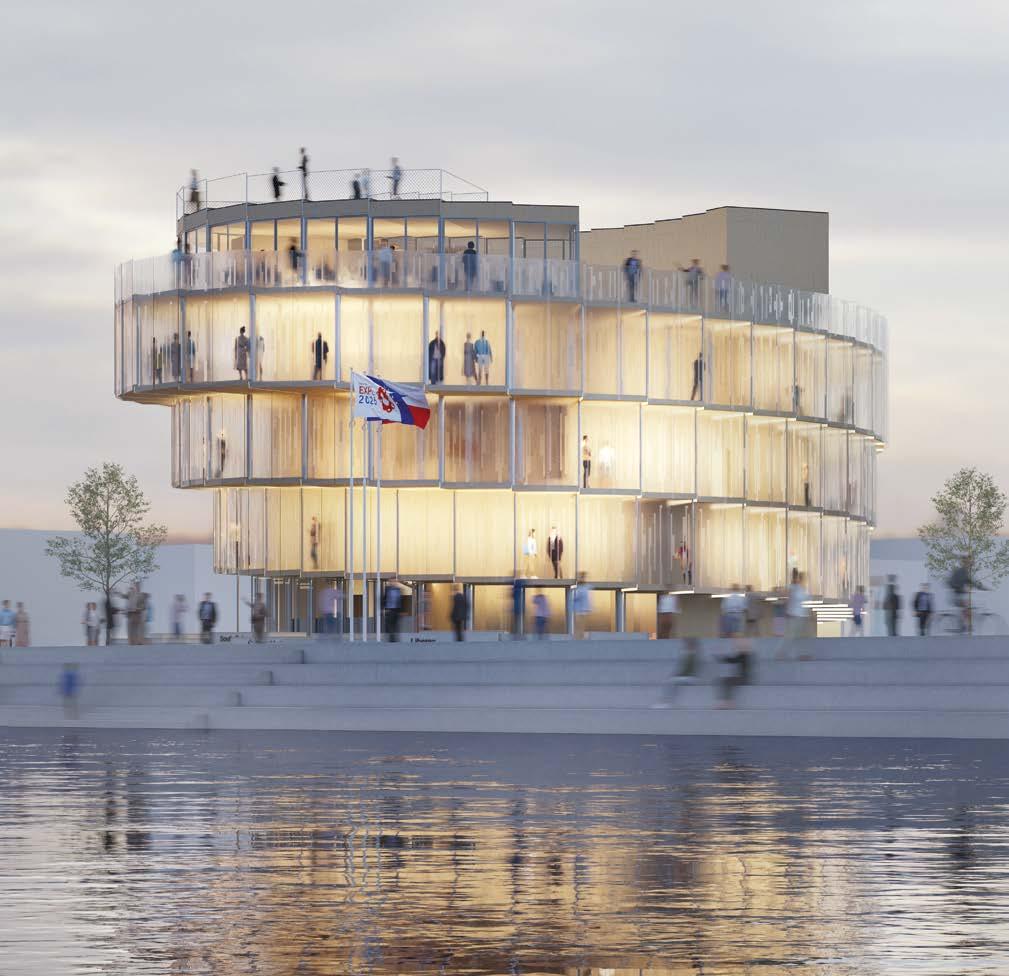
The Czech national pavilion for EXPO 2025 in Osaka, Japan, will speak the language of wood and glass. Designed by Apropos Architects and based on the shape of a spiral, the pavilion will offer visitors a path that gradually winds upward, widening as it goes. It symbolizes a future in which technological advances are fused with a tradition of craftsmanship, representing the development of society and mankind itself.
The world exhibition EXPO 2025 is returning to Osaka, Japan, after fifty-five years, and the Czechs are not going to miss it.
“The concept of the architecture we’ve designed is the dynamic formation of a mass that from the outside appears light, transparent, and airy, seemingly
defying the earth’s gravity. Upon closer inspection, however, a clear geometric design principle is evident throughout the entire building,” says architect Michal Gabaš of the studio Apropos Architects, which operates in Zürich, Prague, and The Hague.
The first wooden structure of its kind
The task was to create an innovative national pavilion made of sustainable and recyclable materials. “We are used to designing wooden buildings – in Switzerland, among other countries, this is common practice and the current standard. CLT technology, meaning cross-laminated solid wood, also suggested itself for several reasons as it is a modern wood processing technique that is done at a high level in Czechia. One of the other factors is the possibility of prefabricating and producing the pavilion in Czechia, and subsequently (dis)assembling it like a jigsaw puzzle,” explain Michal Gabaš and Tomáš Beránek from Apropos Architects.
They add: “Our studio’s work is not based on a banal visual signature. Our goal is to create architecture, public spaces, and objects that meet current and future demands for quality, aesthetics, functionality, and ecology. We strive to proceed from the context of the task,
the location, and the needs of the investor. In this we see the potential of each brief and its uniqueness.”
The pavilion will be located in the challenging environment of an artificial island by the sea, with high winds and potentially even seismic loads. In Japan, the Mecca of modern architecture, it is set to become the first wooden structure of its kind without a metal frame.
“The project brilliantly shows that CLT and glulam timber have almost no limits, although challenges exist at all levels of the design, manufacturing, and construction processes,” say the architects.
The pavilion will take advantage of its exposed position at the intersection of the coastal promenade and the main boulevard, and will draw attention to itself in all weather conditions with its dominant solitary mass. The building’s very silhouette will be iconic. The spiral, as a symbol of gradual upward movement, corresponds to the internal
arrangement of the space. The accessible ramp of the exhibition space winds around the central cylinder of the multifunctional hall – the auditorium – which has an internal diameter of fifteen and a half meters and rises to a height of twelve meters above ground level. The exhibition space rises along with it, and its movement is mirrored by a ramp with seats for visitors which forms the stands inside the auditorium.
“The overall structure of the pavilion is unique precisely because of the use of CLT panels connected by interlocking elements designed to withstand heavy loads, earthquakes, and typhoons while appearing light and airy. On the outside, perhaps the most striking feature is the so-called cantilevering (a structure protruding into space without additional support) of the exhibition space above the entrance façade. On the inside, it is the roofing of the auditorium, made of wooden beams with a circular skylight,” say the architects, describing some of the challenging aspects of the design.
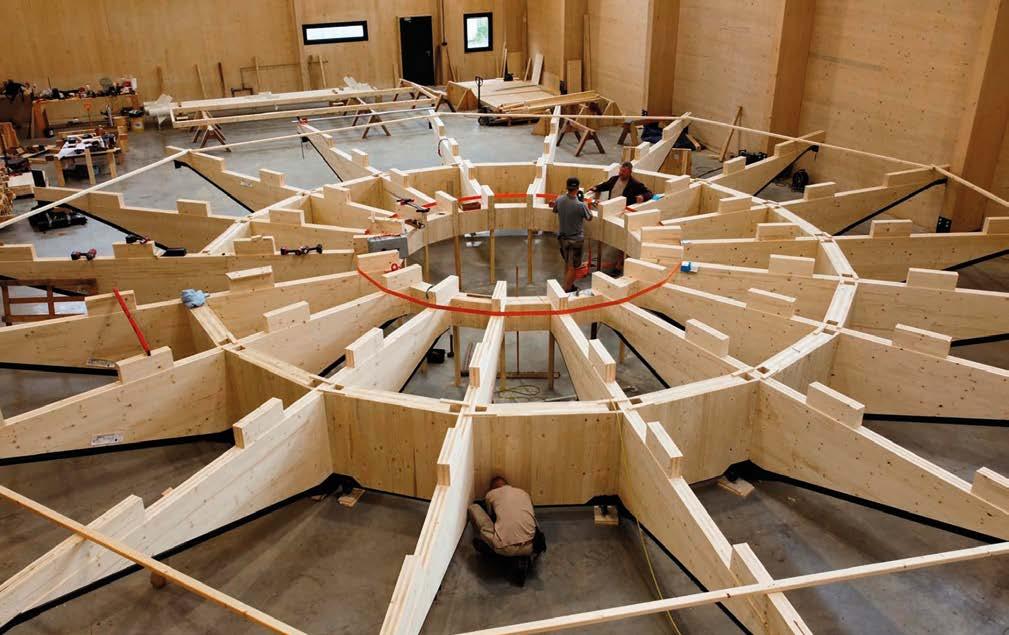
announcement of the results of the architectural competition

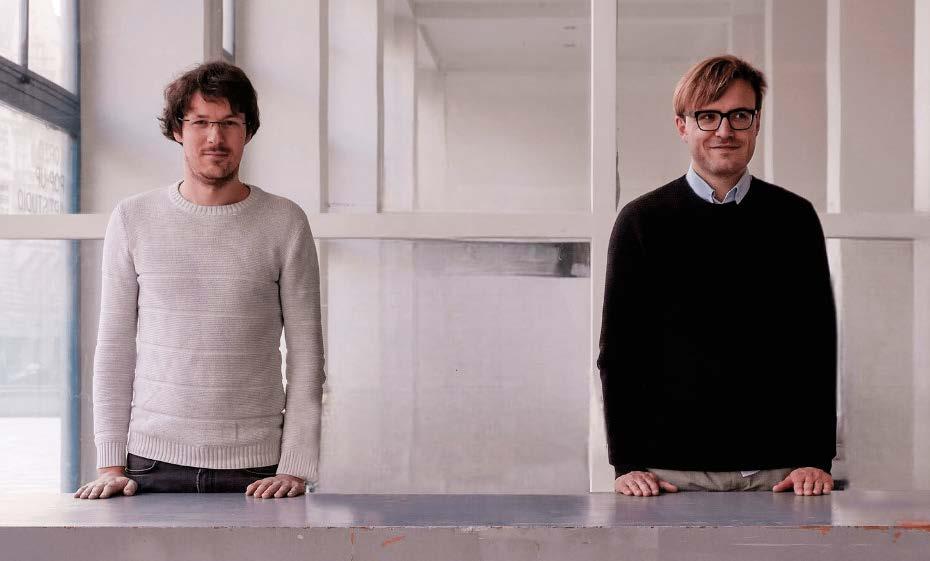
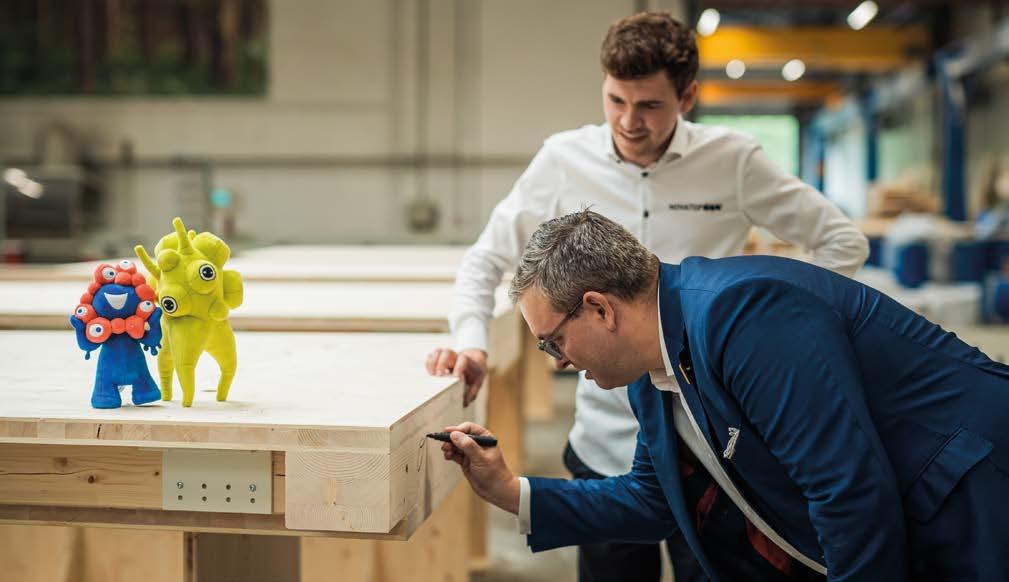

The design of the pavilion draws attention to itself with its delicate visuality. The façade made of artistic plate glass points to the rich history of glassmaking in Czechia, which has made a name for itself all over the world. It also offers unconventional exhibition spaces with a changing interior atmosphere.
The spiral that wraps around the central auditorium also serves as a connecting ramp, along which visitors can walk smoothly upward. The path is 260 meters long and broadens at the front and rear of the pavilion as it transforms from a nearly twometer-wide passageway into a wider exhibition area. At a height of twelve meters, the ramp opens up into a spacious
viewing terrace with a rooftop “crown” featuring a VIP Lounge. Here, visitors can not only take in the breathtaking views of the calm sea but also have a look through the glass skylight into the auditorium.
Another key element is the staircase, which is integrated into the cavity between the double walls of the cylinder and opens
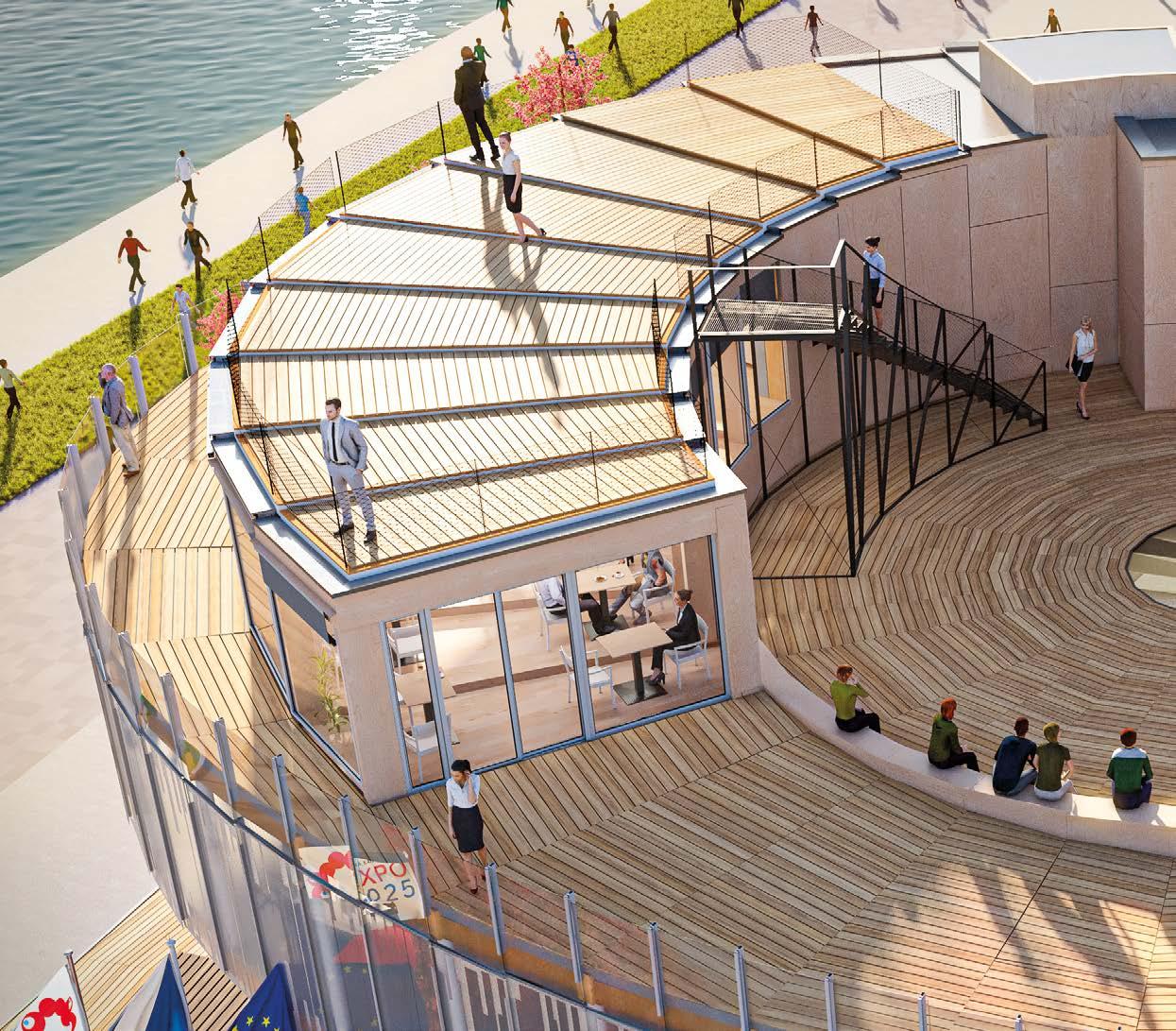
onto the ground floor with the restaurant. Parallel to the visitor staircase, a second staircase winds up the inner cylinder, serving the needs of the auditorium and connecting the ground floor restaurant with the auditorium, its stands, and the lounge. Thanks to this pair of ingeniously designed staircases, it is possible to completely separate the exhibition space from the multifunctional hall.
The wood used in the structure and the ceiling is eye-catching. The supporting structure is composed of a system of cross-laminated CLT panels
that form the central part of the auditorium with the embedded staircases and elevator. The core of the building is complemented by horizontal panels that form the exhibition spiral on the outside, and the balconies of the multifunctional hall on the inside.
“It is mainly spruce, harvested in the Czech Republic and processed into CLT boards of various thicknesses, or into square or round columns. These are further processed and shaped into the exact elements of which the entire pavilion is composed.
The wood’s journey to Japan will of course be very long, but CLT panels in the parameters we need for the pavilion are not produced there locally. Moreover, Japanese wood is much softer than European wood, and so we would not be able to obtain all the necessary permits. So, there was no other option but to import the entire wooden structure from Czechia,” adds Tomáš Beránek regarding one of the structure’s primary materials.
“Moreover, this gives skillful Czech companies the opportunity to supply the Czech national pavilion, which is a great reference order
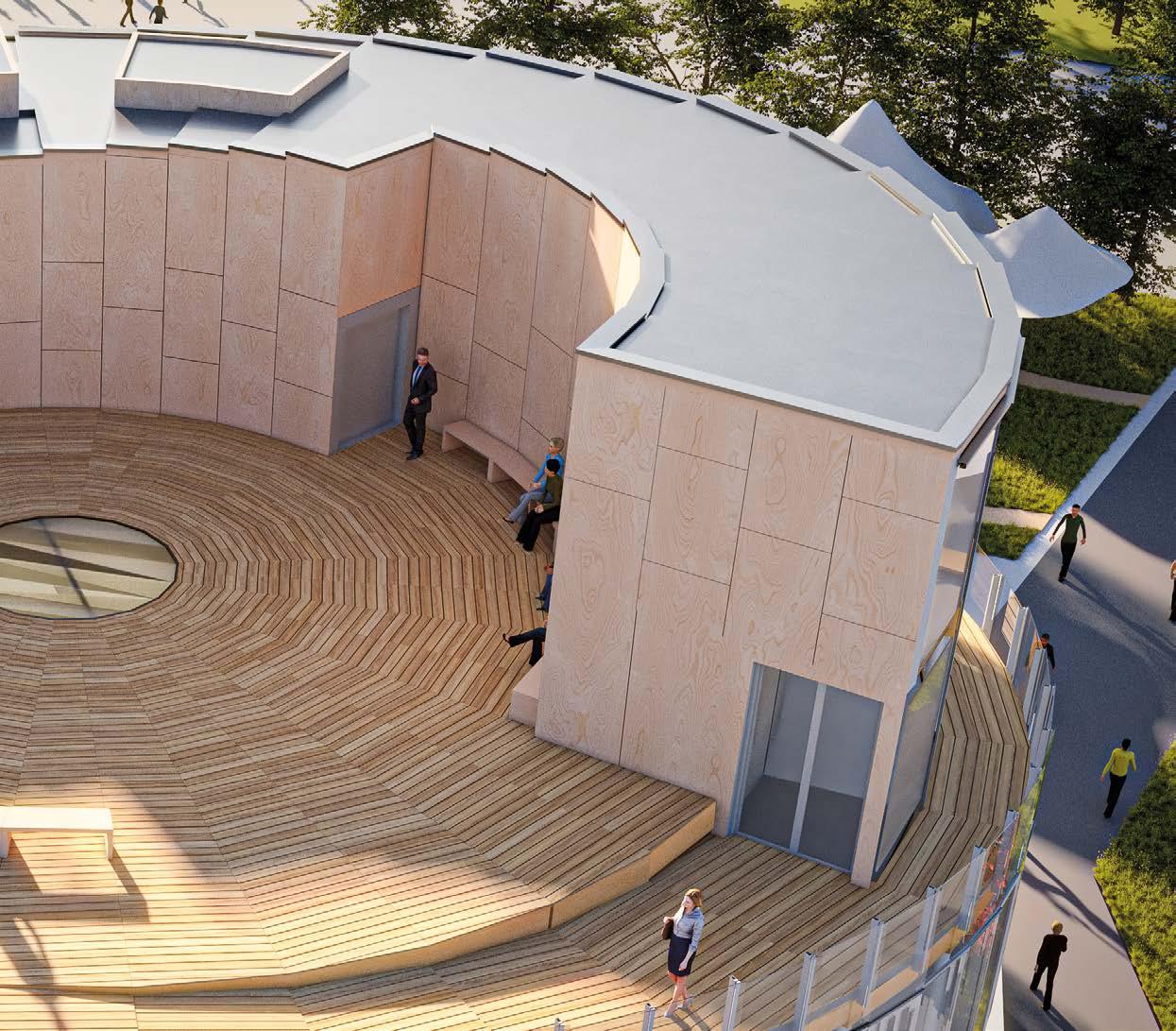
for them. At the same time, they can use this experience to expand their foreign activities and grow their companies,” adds Ondřej Soška, Commissioner General of Czechia participation at EXPO 2025.
And how will the construction materials be delivered? The individual parts of the pavilion are sent to Osaka via Hamburg by ship, and it takes about eight to ten weeks to transport one batch. In total, fifty containers of timber are headed to Japan, all of which were shipped out gradually during the summer months. Other containers with the glass parts will follow.
The Czech pavilion has already garnered a number of international awards. Its latest achievement is world-renowned architecture magazine Dezeen listing it among the thirteen most interesting pavilions of the entire show.
“For Czech companies, the World EXPO can bring new markets; it can help them with expansion or exports. A number of studies have shown that state investment into export promotion bears efficient returns. Among other things, we would like to contribute to attracting new investors or expanding existing investments in Czechia. Incidentally, Japan is the second largest foreign
investor in Czechia. We are also interested in further expanding scientific research cooperation between Japanese and Czech entities, and we would like to help attract Japanese tourists to regions other than just Prague,” concludes Ondřej Soška.
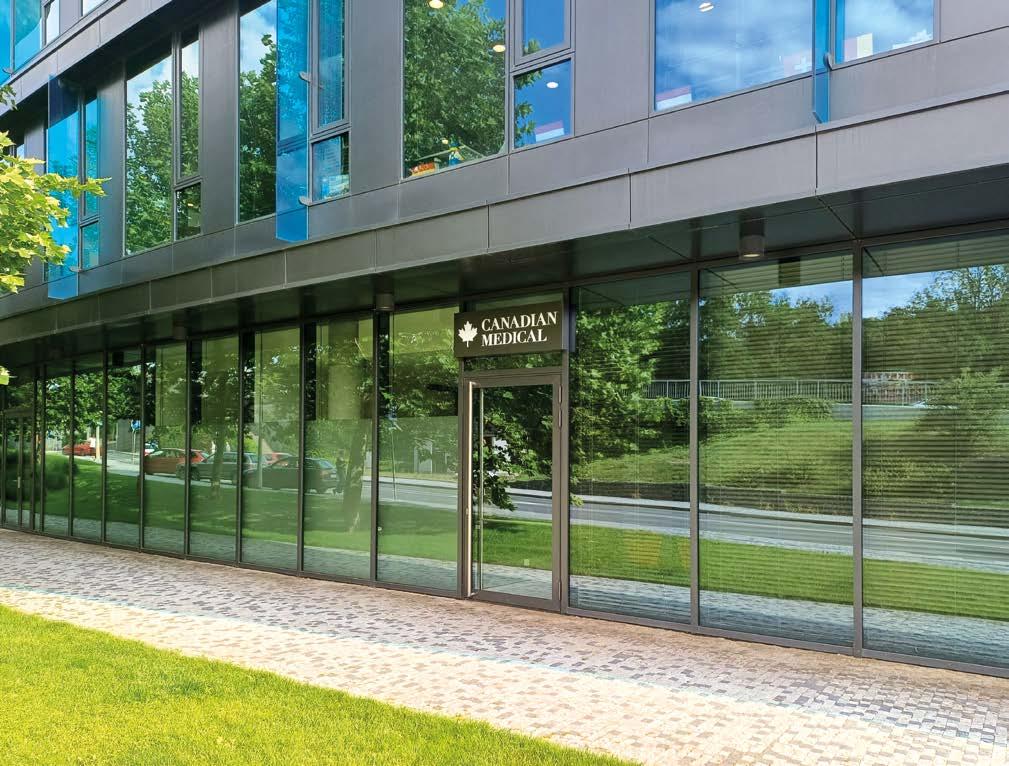
Canadian Medical expands its one-day surgery care by opening a new vascular centre in Prague 5. The newly built outpatient facility complements the range of care in the field of oneday surgery, which is now a standard part of healthcare offerings for clients at the nearby Waltrovka Clinic. Dr. Jan Bafrnec, an experienced specialist in vascular surgery, has become the head physician of the facility. The first operations in the newly opened vascular centre already took place in June.
Chronic venous insufficiency: a silent enemy affecting up to 80% of the population
Chronic venous insufficiency (CVI) is a health issue affecting up to 80% of the population. This condition disrupts blood circulation in the veins, particularly in the lower limbs, where the veins lose their ability to effectively pump blood. This leads to stagnation and swelling in the legs. Although CVI is common, it can pose serious health risks, especially if it progresses to advanced stages.
The disease has six stages: from minor enlarged capillaries to visible varicose veins to leg ulcers.
The most common symptoms include vague pains, swelling, and visible varicose veins. In the initial phase, CVI may be asymptomatic, but as the disease progresses, inflammation, superficial thrombosis, and leg ulcers can occur. In some cases, CVI can also be a source of pulmonary embolism.
It is crucial not to underestimate the initial symptoms and difficulties and to seek expert help as soon as possible.
Innovative care for all forms of chronic venous insufficiency
The Canadian Medical vascular centre specializes in comprehensive

diagnostics and minimally invasive treatment of varicose veins at all stages, including leg ulcers. One-day surgery, where patients can go home a few hours after the procedure, is more manageable for many patients than long-term hospitalization. Recovery takes place in a home environment, positively affecting the patient’s mental wellbeing and accelerating treatment.
The new facility offers a wide range of outpatient procedures, such as aesthetic mini-phlebectomy, laser ablation (EVLT), sclerotization, and the innovative VenaSeal method, which uses venous adhesive. “We treat all forms
of chronic venous insufficiency, including leg ulcers. We provide care to clients with complicated diagnoses that are not suitable for conventional therapy under general anaesthesia. All procedures are performed on an outpatient basis with local anaesthesia, allowing for a quick return to regular activities immediately after the procedure. Our clients are cared for by a qualified team of doctors with international experience in the field, following the latest knowledge and international recommendations. A procedure room equipped with modern devices for the relevant surgical methods is standard practice,” says Dr. Jan Bafrnec, a specialist
in general and vascular surgery and head physician of the new Canadian Medical vascular centre.
Diagnostics is a key component of care at the newly opened Canadian Medical vascular centre. During the initial consultation, the vascular surgeon performs a complete physical and ultrasound examination, while other imaging methods, such as CT or MRI, are used only rarely. The examination is also recommended for clients with small capillaries, where significant impairment of the main superficial veins may be
revealed. Subsequently, a “tailored treatment” is proposed, and the client is scheduled for an outpatient procedure at a specific time.
Treatment is indicated primarily for symptomatic patients with swelling, cramps, pain, and a feeling of heavy legs. The goal is to alleviate symptoms and prevent the progression of the disease to a more serious stage, such as leg ulcers. Conservative therapies (such as venopharmaceuticals, compression therapy, and lifestyle changes) can be effective for milder forms of the disease, while more severe findings require surgical intervention. Procedures
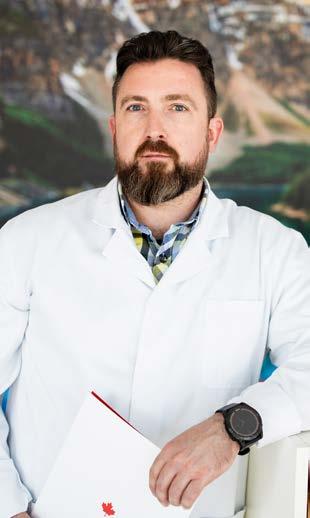
are performed in a modernly equipped procedural room, and, for greater comfort and peace, music is played upon request.
How do you make an appointment?
The new Canadian Medical vascular centre is strategically located in the Aviatica building, near the Waltrovka Clinic. “The demand for our services is high, especially since diagnoses and surgeries are performed by a certified vascular surgeon. Clients do not need any referral from a doctor for examinations at our facility; they just need to make an
appointment,” explains Radim Stein, operations manager at the Waltrovka Clinic.
Those interested in treatment can schedule an initial consultation with a doctor, who will choose the most appropriate treatment method based on their health condition and plan the date of the procedure. Care is available to all clients with Czech health insurance; to those without Czech health insurance and foreign clients it is offered on a direct billing basis.
DR. JAN BAFRNEC
is a recognized specialist in general and vascular surgery, with over ten years of experience. After graduating from the 1st Faculty of Medicine at Charles University in 2007, he focused on general surgery, in which he was certified in 2014 at the 3rd Faculty of Medicine at Charles University. He expanded his specialization to vascular surgery, obtaining a certification in 2022. Dr. Bafrnec specializes in laparoscopic and endovenous vein surgery, as well as oncovascular surgery. Since 2011, he has served as a surgical consultant at the Royal Vinohrady Teaching Hospital, where he is involved in the comprehensive care of general, laparoscopic, and vascular surgery. In addition to clinical practice, he is also engaged in academic activities as an assistant professor at the 3rd Faculty of Medicine at Charles University. His professional career also includes work as a clinical research physician, and he is actively involved in publishing.
In the offices and operating rooms of Canadian Medical you will find doctors with extensive experience from the best Czech hospitals, as well as abroad, who are well-informed about current developments in their fields. Today, Canadian Medical has over twenty years of client care experience, and, thanks to the diligent work of doctors, nurses, and colleagues in support roles, has also undergone dramatic development. The comprehensive care is offered at seven locations in Prague and Brno, including a hospital department with two modern operating rooms. Due to the quality of care, Canadian Medical continues to be the facility of choice for foreigners living in the Czech Republic. Today, the largest portion of Canadian Medical patients comprises of Czech clientele who want to take the best care of their health and seek a high standard of services.


A growing number of frequent flyers are beginning to look for ways to trade their miles and hotel points, converting them into actual cash. My own frustrating experience of accumulating miles, only to realise later how limited the ways of using them are, led me to recognise a market failure. Creating a secondary market where frequent flyers could sell their miles would provide a much-needed solution.

Encountering a significant market gap
While working for a subsidiary of France Telecom, I frequently travelled and collected miles across various airline loyalty programs. When I tried to use these miles for a family vacation, I realized the severe limitations
in availability, especially during peak seasons. This frustration led me to recognize a widespread market failure affecting frequent flyers like myself. After over two years of in-depth research, I discovered that airlines owe more than $500 billion in miles to frequent flyers. I knew that creating a secondary market,
where frequent flyers could sell their miles, would provide a much-needed solution.
I’ve always been fascinated by how technology can improve our lives, particularly through financial models. This fascination led me to establish MyleFly. Airline miles and hotel points trading is gradually
being adopted by frequent flyers, and MyleFly is at the forefront of this change in Europe. It is the leading brand for frequent travellers looking to convert their miles into actual cash.
We simplified our model
MyleFly initially aimed to be a trading platform for miles. However, due to the complexities of mile valuation and regulatory limitations, we simplified our model. Today, we buy miles and points from over 50 airline and hotel programs directly from individuals, and sell them as award tickets to a global network of travel agencies specializing in mileage flights.
Frequent flyers can check the prices we offer on our website. If they are interested, they submit a request to sell, receive an official price offer, and then provide access to their airline program. We use the miles and pay them, or they go through a short verification process, receive payment upfront, and then provide the credentials to their loyalty program. Once the miles are used and flights are flown, the frequent flyer can change the account access details. This process has evolved to become much faster and more straightforward.
Pricing miles is complex, which is why we shifted from a trading platform to setting rates ourselves
based on the market value of miles. The price per mile is influenced by several factors, including the terms of the loyalty program, airline taxes, the flexibility to use miles with airline partners, and the ability to convert credit card points to airline miles. For example, miles value can decrease dramatically due to certain credit card promotions in different continents. Given these variables, we set the price per mile as a derivative of the market value, considering all real-time market conditions.
Our business model allows the use of miles without the need for
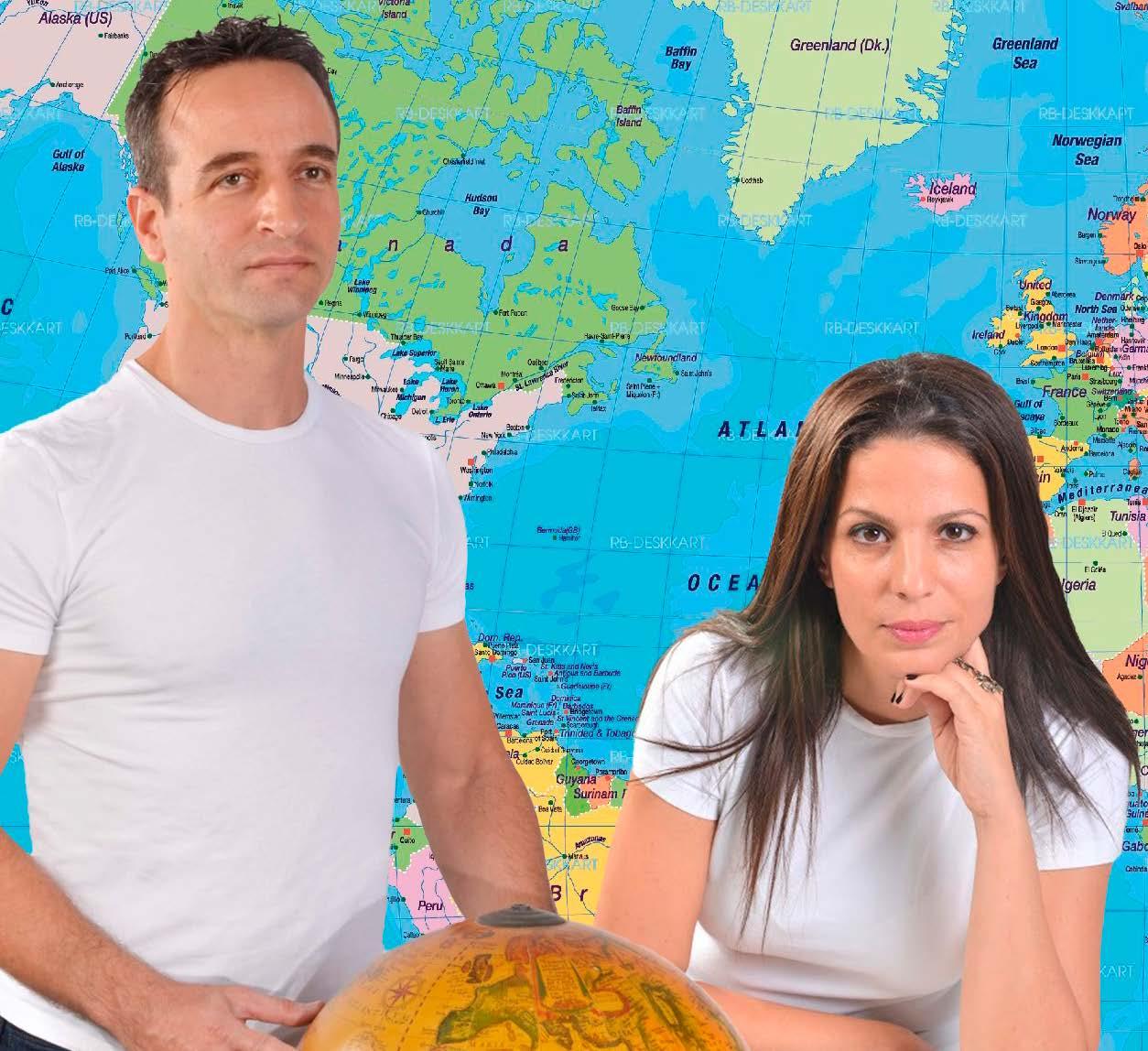
limited award flight availability, and converts miles to cash. However, airlines prefer that miles remain untraded, which hinders our ability to automate more of our workflow. Additionally, some frequent flyers are intimidated by airlines’ opposition to this model, making it challenging to gain widespread adoption. Despite these challenges, we are seeing increased traction and recognition from the industry, with more frequent flyers registering for our service and referring others.
As an entrepreneur, you must always remember that the key is to identify a real problem that
needs solving. Don’t create technology for its own sake; focus on how your innovation can genuinely improve people’s lives. Be prepared for constant learning and adaptation. The tech industry moves rapidly, and what’s cutting-edge today might be obsolete tomorrow. Stay curious, keep learning, and be ready to pivot when necessary. I can say that determination is crucial. Even with thorough research and a solid business model, the journey will be long and challenging. If you know your industry, have a robust business model, and a good solution, keep moving forward and find answers to every
obstacle. Every problem can be seen as a challenge, and once solved, it becomes an advantage.
In our view, the lack of a secondary market for miles and flights, despite the existence of alternative markets in the travel industry (e.g. Airbnb for hospitality and Uber for transportation), indicated a significant need. We were ready to build a solution to address this gap, and make it happen.

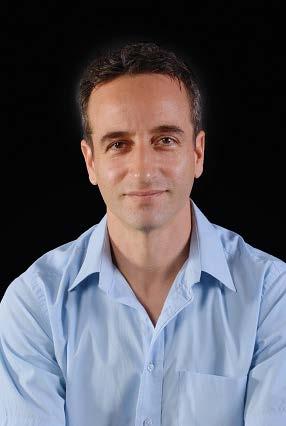
is a 52-year-old tech enthusiast with a passion for exploration, founder and CEO of MyleFly startup. Growing up in Tel Aviv, he was surrounded by a vibrant startup ecosystem that nurtured his entrepreneurial spirit. His interest in financial markets led Moskovich to pursue a BA in Economics and later an MBA. He also became a lecturer in advanced financial topics (Futures and Derivatives) at the College of Management Academic Studies in Israel. Concurrently, he gained valuable experience working for major tech companies and startups, which provided insights into how technology can transform industries. His MyleFly stands at the forefront of this change in Europe. It is the leading brand for frequent travellers looking to convert their miles into actual cash.
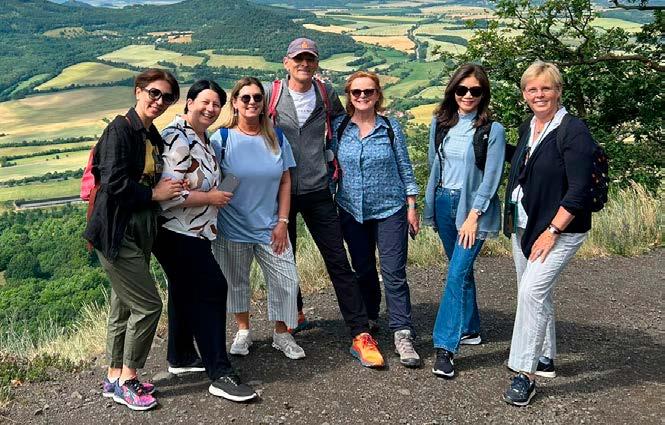
Dear Members of the DSA Walking Group, and dear readers of Czech & Slovak Leaders,
It was a great pleasure and honour for me to be able to share my knowledge and joy of sports activities with the members of the Diplomatic Spouses Association Prague (DSA).
For four and a half years, I was the leader of the DSA Walking Group. During that time, I organised and led over 120 walks in Prague and quite a few walks outside of it, discovering famous and lesserknown places, especially parks. In total, we walked almost 800km. The communication within the group was done via WhatsApp, which made the organization of activities flexible and simpler. I organised the first walk on 12th December, 2019, in Stromovka Park, and the last one on
12th June, 2024, to Prague’s Petřín Hill, to see the roses in bloom.
The Walking Group was probably the most visible and visited group within the DSA. It was also the only active DSA group at the time of the COVID-19 pandemic. Participation in the walks depended on the weather or the time of year, as well as the place we were going to. On warm days there were more than ten of us, and on colder days we were four to six. Over the years, the Walking Group has had a total of 45 members.
The walks were primarily about walking, but also about talking and socialising, learning about Czech history and culture, natural sights, learning about plants and animals, and picking various natural fruit. After the walk, we often continued socialising over coffee or tea in cafés or residences.
This made it easier and quicker for the new members to integrate into the diplomatic community, faster and easier for us to get to know each other and become closer through the Walking Group, and for the new members to get to know Prague and parts of the Czech Republic.
In addition, we have diligently photographed all the walks, and have therefore created a comprehensive photographic record of our activities and precious memories, which, thanks to Mrs. Svetlana Codreanu, the spouse of the Ambassador of Moldova, have been published in the DSA newsletters. We presented the outgoing members with a book of photographs at the end of their stay in Prague.
Dear members of the DSA Walking Group, your friendship and joy of walking gave me the motivation to organise and lead a walk every Wednesday morning.
I would like to continue the walks after my departure from Prague too, and I warmly invite everyone to join me on my walks around Slovenia.
Thank you!!!
Toni Strniša, Slovenia August 2024

Natalia Bayona began her career working for the government of her native Colombia, eventually becoming its youngest manager responsible for promoting the country abroad, at the age of 27. Six years ago, she joined UN Tourism to create and lead its Innovation, Education, and Investment Department, focusing on the “three key areas for the development of the tourism sector”, and investing in “the three pillars – people, planet, and prosperity”, she believes.
What do you feel you have learned from your time, back in 2006, when you began your career in the team creating the first international tourism campaign for your home country, “Colombia – the risk is wanting to stay”?
What fond memories I have of that time! I thoroughly enjoyed those moments, and, looking
back, I believe I learned a great deal from that experience. I was the youngest manager responsible for promoting the country, but I also started there at a very young age!
My first steps in ProColombia were as an intern when I was very young, and I was awarded as the best trainee of that promotion. Then, right after that, I started
with my first contract. I remember thinking that I was working in something that I liked and enjoyed, and year by year I continued growing, learning, and opening doors for tourism in the country, which at the time was something unexplored.
I learned many things during those years. One of them is that finding what makes a city or a community different from the others, and working on letting the world know why they are special is the basis for boosting the tourism sector in a certain place. I also learned that working with local communities is key to developing the tourism sector, providing them with educational resources, and supporting innovation projects. This also requires support from the institutions, both at local and national levels, to generate frameworks that promote tourism investment, as well as encourage entrepreneurship.
I have walked this path because tourism has been my passion, along with innovation and education. What I didn’t know at that time was that these three things combined, and added to my determination, has been what has brought me here, to my current position at UN Tourism.
Now, with all these things I have learned, I continue to be so passionate about tourism, the most human economic sector of all, and thinking that education and innovation are instrumental for change.
I also believe that tourism must be understood as a state policy, because it is a sector that can drive development and influence many others, not only culture sector, it is also required in order to support security, conservation of heritage and the ecosystem, etc. Therefore, for adequate development, it is necessary to have, as I said, public policies that favour
it, as well as private initiatives willing to invest.
You are passionate about tourism. Are you a tourist too?
These days I am travelling so much that I have to admit I am not sure about the exact number of countries that I have visited by now. More than 100 countries, for sure. And in all of them, I find thousands of reasons to revisit and stay longer.
My list of visited countries is growing month by month due to my professional commitments. However, I will continue travelling because I find it one of the best ways to open our minds and learn about others.
Does such extensive international travel, required as part of your current position, still fit your lifestyle?
Six years ago, when I came to UN Tourism to create the Innovation, Education, and Investments Department, I had already lived in several countries, and had experienced being surrounded by different cultures and nationalities. And I have always loved to travel.
All this, together with education and my passion for travelling, gives me an international mindset. We also must take into account that we live in a global and interconnected society right now, so thanks to technology we can do things that we never imagined, and travel in different ways. People and information are travelling faster and further than ever before.
What is the best travel adventure you have been on?
This job allows me to get to know many places and different people, understanding how they live, and how tourism can transform their region and give new development
opportunities. When I think about adventures, I am lucky, because I remember many anecdotes.
Nevertheless, perhaps my best adventure is the work that I do day-by-day at UN Tourism. This job is challenging, because you need to travel a lot, but tourism opens minds and brings cultures together. It is a vibrant sector that is so alive that it is always changing, with new ideas, new scenarios, and, of course, new challenges. Therefore, working in such an exciting sector makes every day an adventure.
Can you share one of your more unusual experiences?
When someone travels as much as I do, anecdotes abound. But I remember one case that was quite intriguing, and that also happened to me in my homeland. It was a few years ago, we were in the middle of a mega event in Cartagena, Colombia, and I had to authorize a power cut for a few minutes to be able to have a perfect rider for the Colombian artists. They were going to present and perform in front of more than one hundred tourism ministers from all over the world, and they wanted to be sure that everything was going to be perfect. At the end of the day, we succeeded. That was in 2007, and I still remember it as an intense day.
What do you find is the most difficult part of being a UN Tourism Executive Director?
Being an Executive Director of a United Nations specialized agency is an honour, a challenge, and, above all, a great responsibility, which I have accepted with enthusiasm and the desire to work to bring innovation as the primary tool for the changes that tourism needs.
I am also incredibly grateful for this role because I believe that this appointment means that

the work done together with the team, over the past six years, as the head of the Department of Education, Innovation, and Investments has been relevant. It shows that not only this work deserves to continue but should be amplified since these are three key areas for the development of the tourism sector.
On one hand, we need adequate, diversified investments in key areas in order to develop all the potential that tourism has at all levels, both in the sector itself and its workers, and for the different countries. On the other hand, it is needed, in order to support entrepreneurs and to ensure that innovation and technologies help us move forward and remain at the forefront. Finally, it is necessary to achieve a skilled workforce with a higher education.
Training will allow not only the prospects of tourism as a sector to expand, but also the professional growth, on a personal level, of
those who are part of this wonderful sector in which we work.
Can you give us a closer look at your duties as Executive Director of UN Tourism?
The work in the executive management consists of overseeing key structural areas for the organization in order to achieve UN Tourism’s objectives in the most efficient way. The underlying idea is to create added value serving the tourism sector.
Right now, under my coordination are the five regional directorates (The Americas, Europe, Asia Pacific, Africa, and the Middle East), the Department of Innovation, Education, and Investments, the Department of Communications and the Technical Cooperation. We are working to always keep our finger on the pulse of the sector, anticipate trends, and adapt to the challenges that the actors who are part of it must face. That’s why, at the last General
Assembly, we at UN Tourism proposed a new investment framework based on investing in People, Planet, and Prosperity.
In People, by promoting education. This part is very important, considering that tourism is the main employer of young people. Over 50% of the workers in the sector are 25 years-old or younger, and it is estimated that, by 2030, around 882,000 jobs in the tourism sector per year will require vocational training.
In Planet, through more sustainable practices to achieve Prosperity, counting on innovation as a catalyst. This is because technology, which has always been very present in the tourism sector, is also the gateway to new ideas. That’s why, via UN Tourism, we encourage and support entrepreneurship with various initiatives, such as our contests for startups. We have already had over twenty contests, and this has given rise to an innovation ecosystem that brings
us much joy.
Do your professional duties allow you enough free time to enjoy other hobbies besides your passion for travelling?
As I said, education is one of my passions too. Therefore, I love to study. But I also have a taste for fashion. For many years, I have loved to meet emerging fashion designers and support them. It is those designers who create purposeful concepts and do what has been called ‘slow fashion’, and who tend to seek quality, authenticity, and durability, who particularly catch my attention.
I like to recognize these profiles because, as I was saying, this link with education extends to all levels. I am a mentor to young people and women who want to grow in their professional careers, as well as a startup mentor. And, when it comes to a personal
level, I must say that physical exercise is integrated into my daily life. I therefore try to walk at least seven kilometres a day. It is a fantastic exercise to stay healthy, but it also helps you think better, and, moreover, you enjoy the landscape and discover new places.
You have been successful in becoming a powerful influential woman. What piece of advice can you give to the next generation to help them also fulfil their ambitions?
As a mentor, my first advice is about learning. Education is the most powerful and transformative tool that we have. With education, we can transform not only someone’s life but also society. So, educate yourself as much as you can, learn things every step of the way, and never lose your curiosity and the desire to learn. And, when it comes to my beloved
sector, I will add another piece of advice for the next tourism leaders: see Tourism as what it is – the most human sector of all.
Because of that, it is important to focus on the three pillars that we have talked about before – People, Planet, and Prosperity. Investing in people through education is mandatory, and there is also a need for impulse green investments to develop countries and communities, as well as having a sector aligned with sustainable development goals. Last but not least, working in innovation in order to increase entrepreneurship and help entrepreneurs develop their potential could contribute towards creating a great landscape for the tourism sector.

The Fassati Art Festival aims to present artistic projects full of unusual experiences, which include the harmony of music, visual arts, design, gourmet delicacies, emotions, and mutual human harmony. “Czech Roots”, the 11th gala evening took place this summer in the intriguing premises of the top floor and terrace of the National Agricultural Museum in Prague Letná.
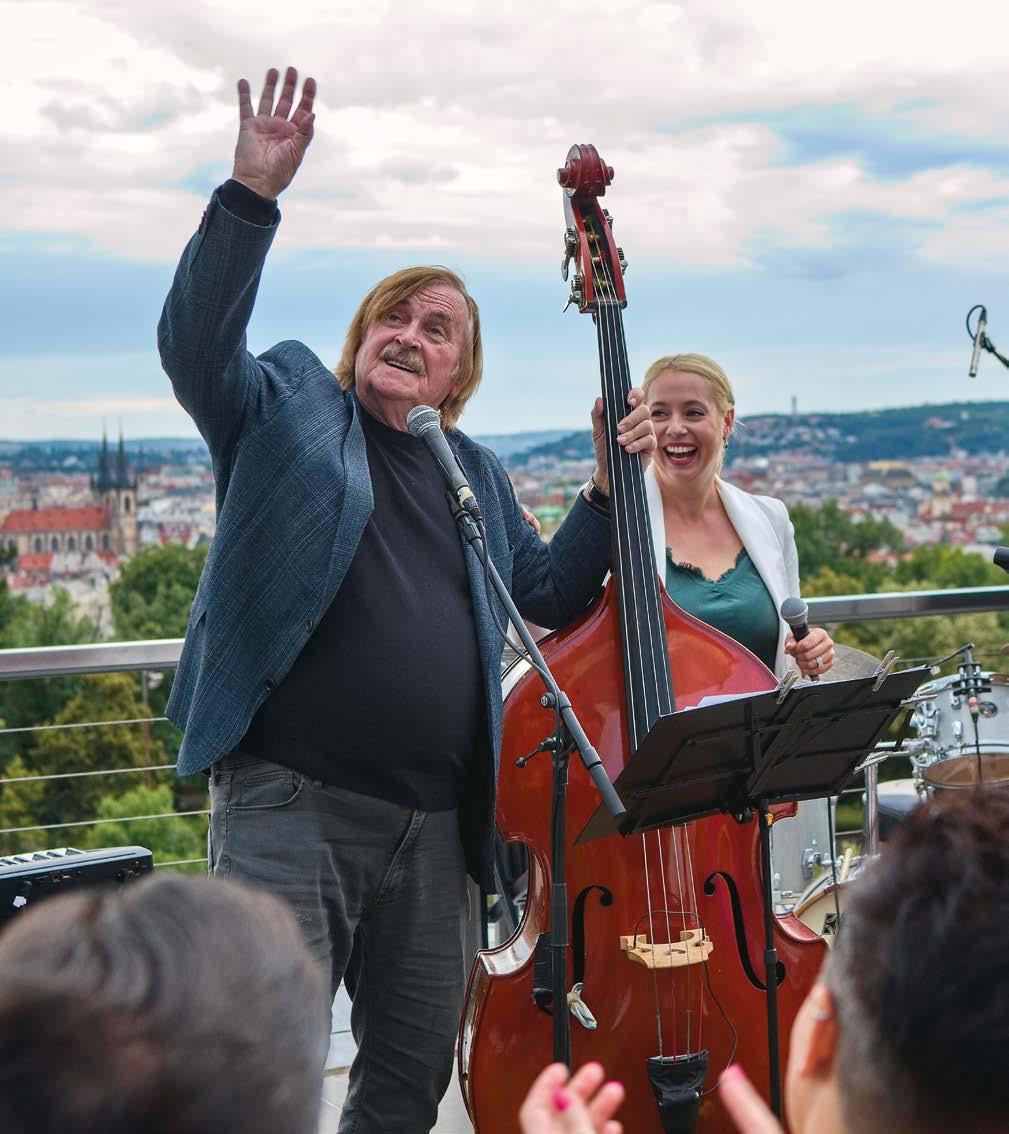

The concert was opened by the museum´s director Zdeněk Novák. Popular Czech melodies were played and enjoyed on the roof of the museum, delivered by such music legends as Karel Vágner, pianist Pavel Větrovec and his band, and singer Markéta Fassati.
The whole experience was further enhanced by the exhibitions of young glass designers from the YARTI Young Glass Art, works of the wood artist and writer Martin
Patřičný, and collectible Smart Coins by the BHS company. The BHS also prepared a competition for the guests called “What´s the weight of your future” with gold ingots as the prize.
Gourmet delicacies were traditionally arranged by the Food Bank for Prague and the Central Bohemian Region. During the evening, the wine world of Vinselekt Michlovský was introduced by its owner
Lenka Michlovská, and excellent coffee was once again served by Dallmayr Kaffee.
The 11th Fassati Art Festival gala evening received the patronage of the Minister of Agriculture Marek Výborný. The organizers would like to thank all the guests and partners for their support!
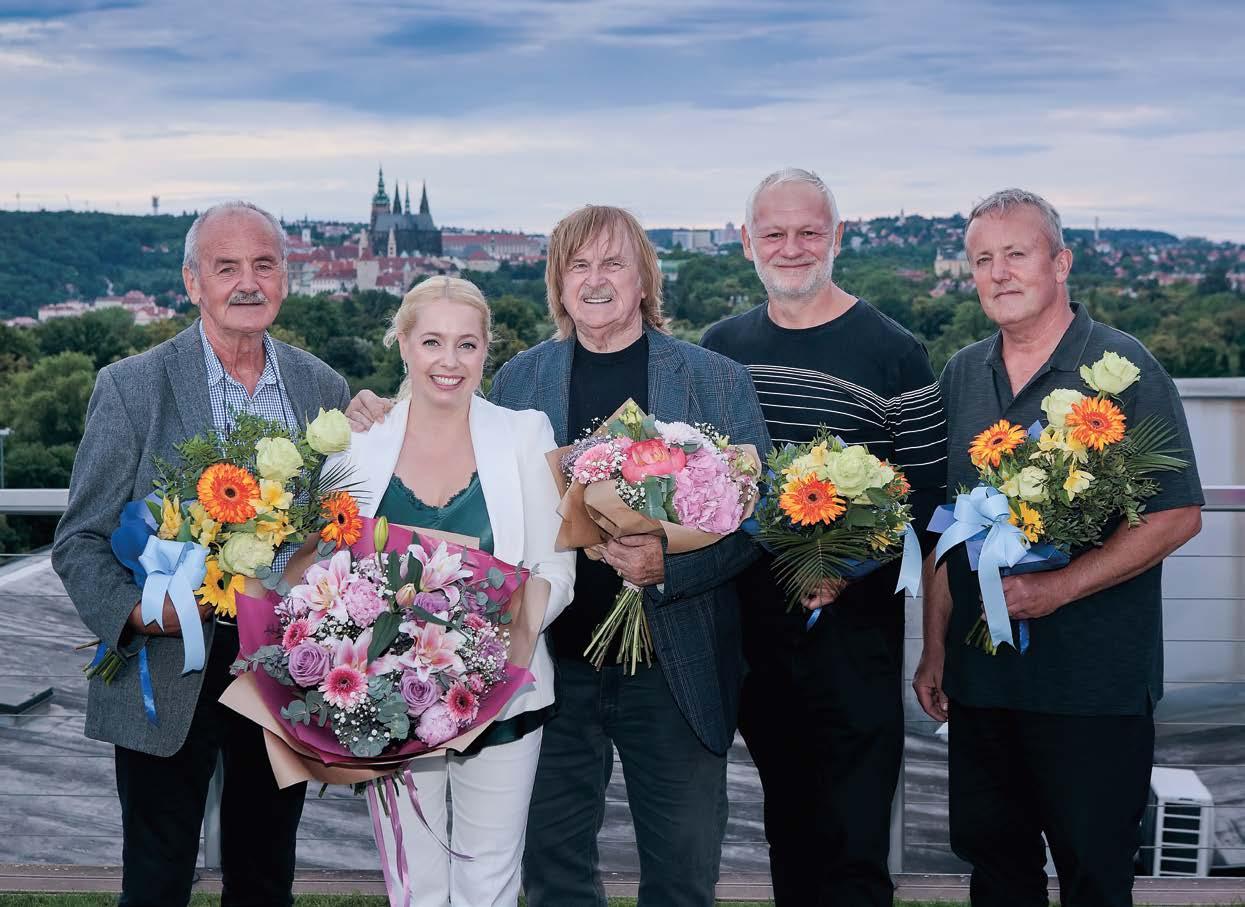
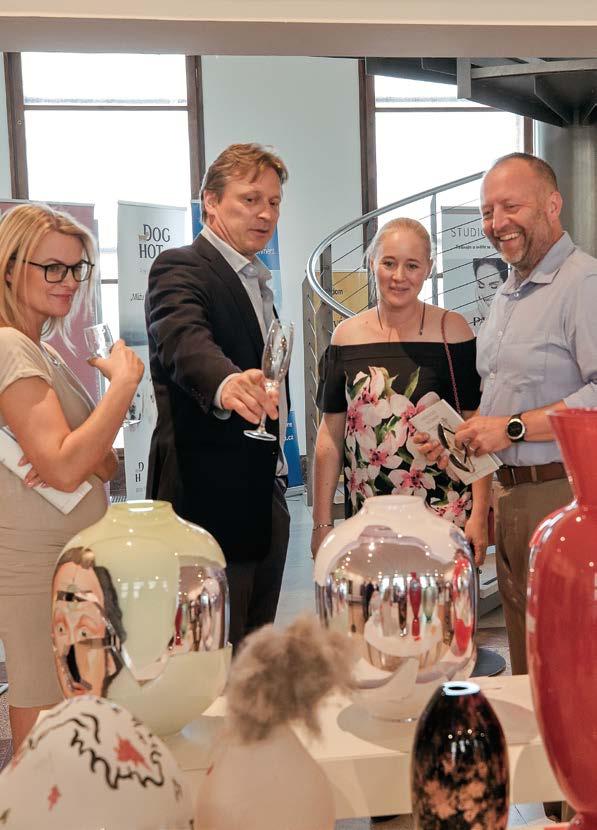
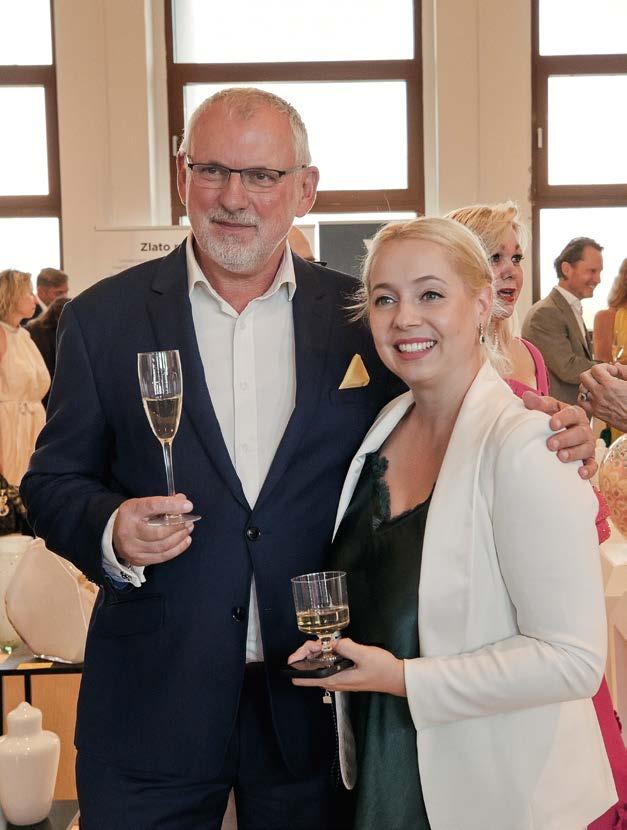
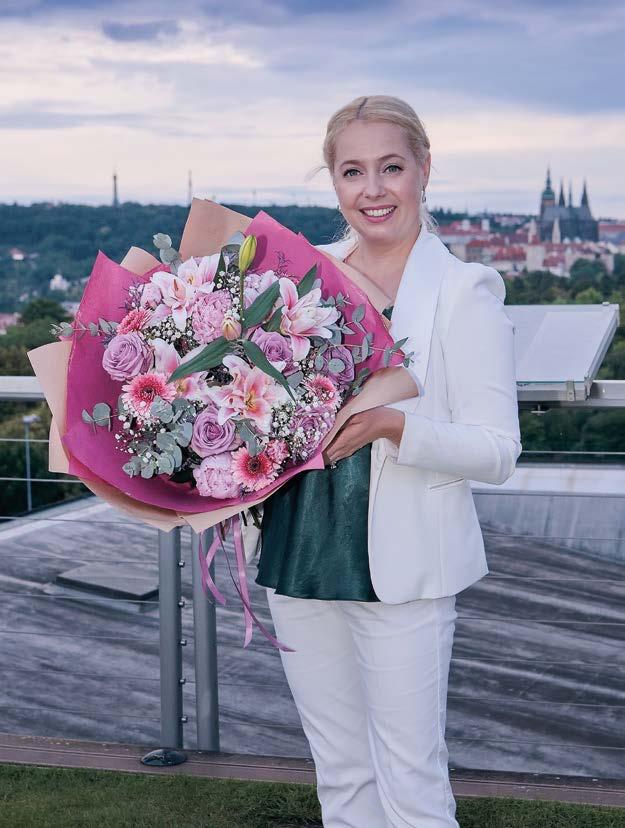


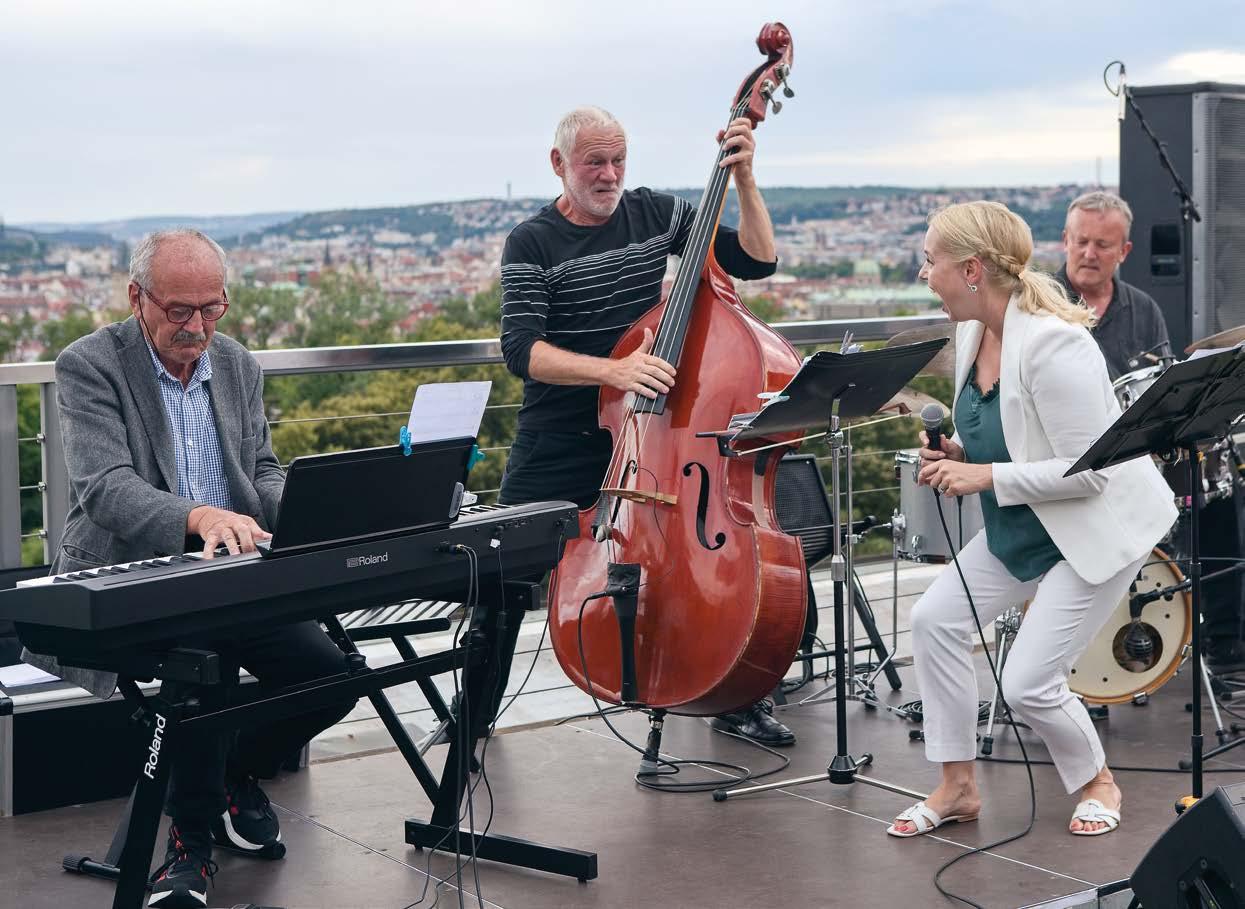
My name is Radek Pilař, and I am 190cm tall. You are probably asking, why is this guy telling me about his height? Well, simply because this is why I got the idea to help tall Czech guys find the right, good-looking T-shirts for their bodies. My own experience has shown me that such fitting and comfortable T-shirts are completely absent in the Czech Republic – and at TallGuys, we decided to start making them.

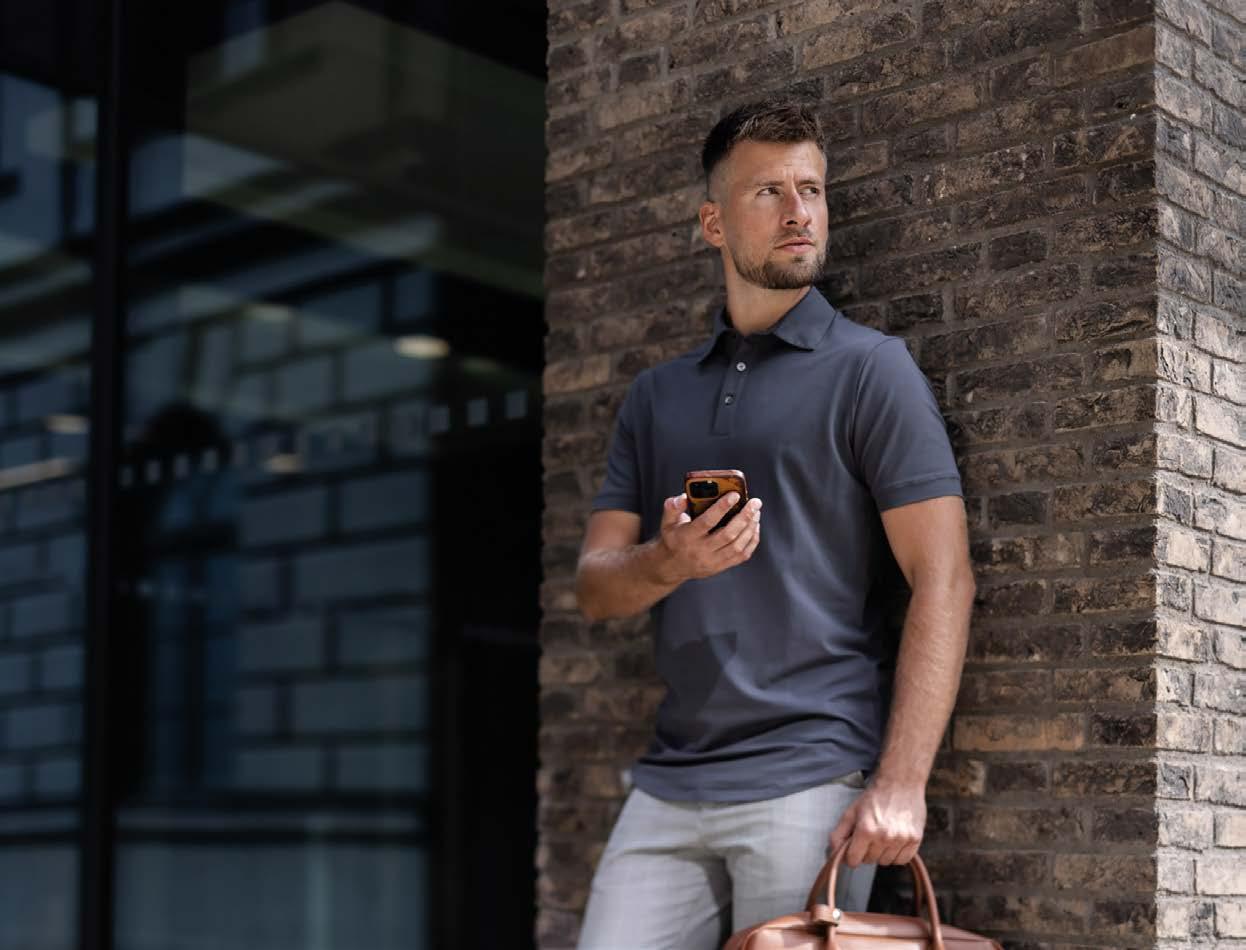
All my life, I was struggling to find clothes that would fit me. However, when I bought a couple of T-shirts in the US that fit me perfectly and were so comfortable, I didn’t pay any attention because I viewed them as a totally ordinary item. Only a few years after my return to the Czech Republic did I finally realize that T-shirts which fit like this are in no way ordinary but instead very special, and are completely absent in the Czech market. T-shirts from Czech stores were either too short or too wide, and when I accidentally found the correct size, wrinkles appeared
after the first wash. I asked myself: ’Radek, why don’t you make these simple, unprinted and natural cotton extended T-shirts yourself?’, and that’s how TallGuys was born.
TallGuys is the clothing brand that’s offering the kind of items you would like to find in stores: Well-fitting, with precision cut, quality materials, and an extended length (so you don’t have to keep pulling it down all the time).
I like to support other Czech entrepreneurs, so we sew our T-shirts exclusively in the Czech Republic. We aim to be friendly
to people and the environment. For many months we were working with Czech seamstresses to make our T-shirts perfect – from the type of neckline and lengthening to the unobtrusive logo. We were testing our clothes for a long time. Everything you can find on the e-shop is in my closet too.
We want to create minimalistic and universal clothing. That’s our intention. Clothes you can take anywhere, and that make you feel comfortable in every situation. You can create an outfit for the whole day with these timeless pieces. We don’t even show off our branding, it’s hidden on the side of the shirt.
It’s the fit and the premium cotton that we use that make the difference – it´s nice and comfy to wear a TallGuys T-shirt. I took a lot of care in the choice of material. At least 95% of the TallGuys clothing is made up of organic cotton natural fibres. You can count on a pleasant wearing sensation, which also lasts after many washes. The 5% elastane adds flexibility. Only natural resources and environmentally friendly processes are used in the production of our cotton materials. In addition, people work in decent working conditions on the farms. The material is suitable for very sensitive skin, as it is certified
OEKO-TEX Standard 100 + GOTS (Global Organic Textile Standard), which guarantees the highest purity of organic cotton under ethical and ecological conditions.
Above all, we want our customers to come back, be satisfied, and be in love with wearing our clothes. We are gradually expanding our assortment because our vision is for our customers to build a complete outfit with us. We are also seeking opportunities abroad and exploring new ideas. At the same time, we want to offer a stable assortment, so that even after years of buying and
wearing our clothes the customers can still find their favourite pieces and buy what they were already satisfied with.
We think that people should spend minimal time and energy on shopping, and the piece you buy should last a long time. That’s why we care so much about the quality of our clothing, as well as offer a wide selection of neutral colours – because they never get old.
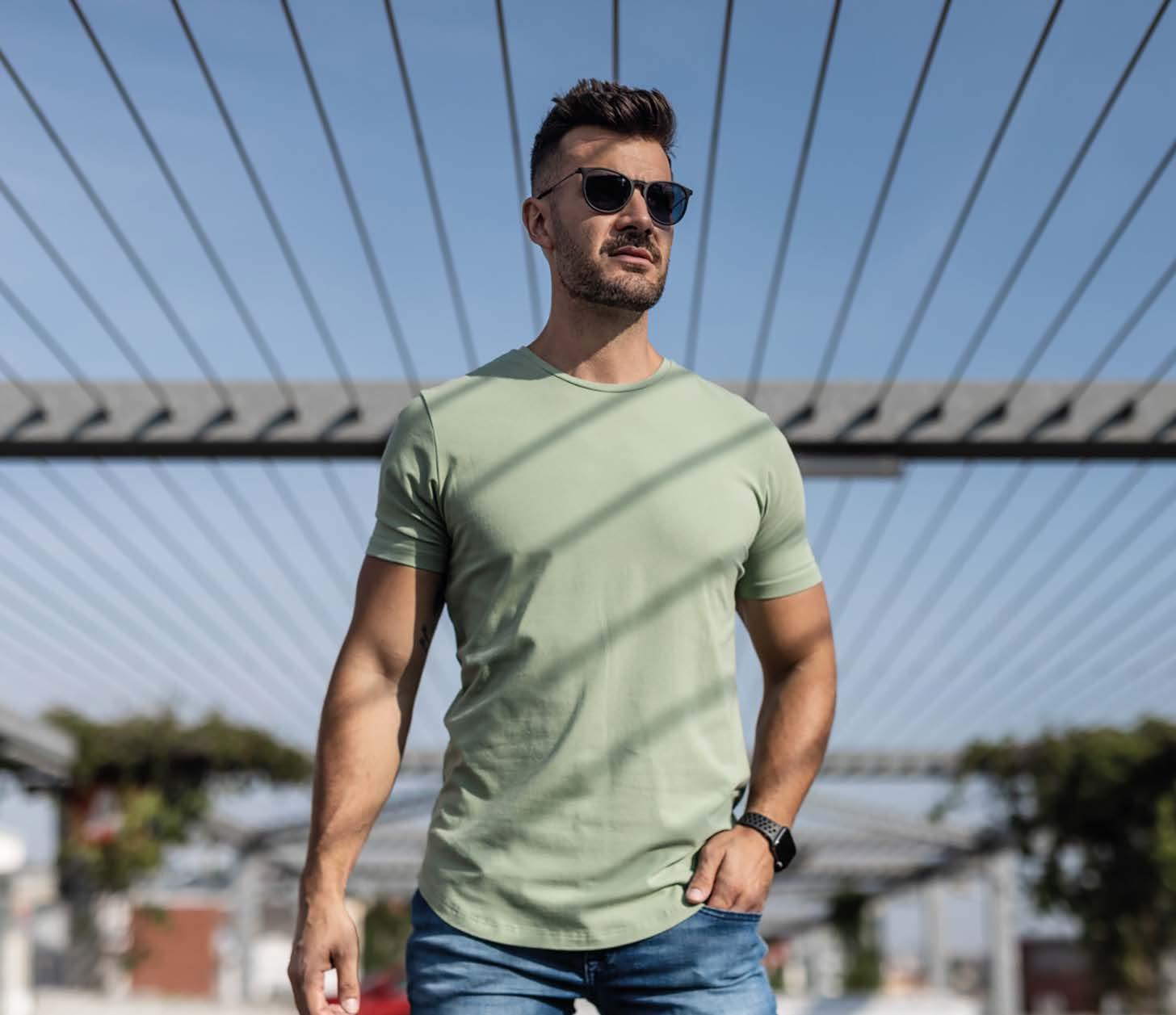
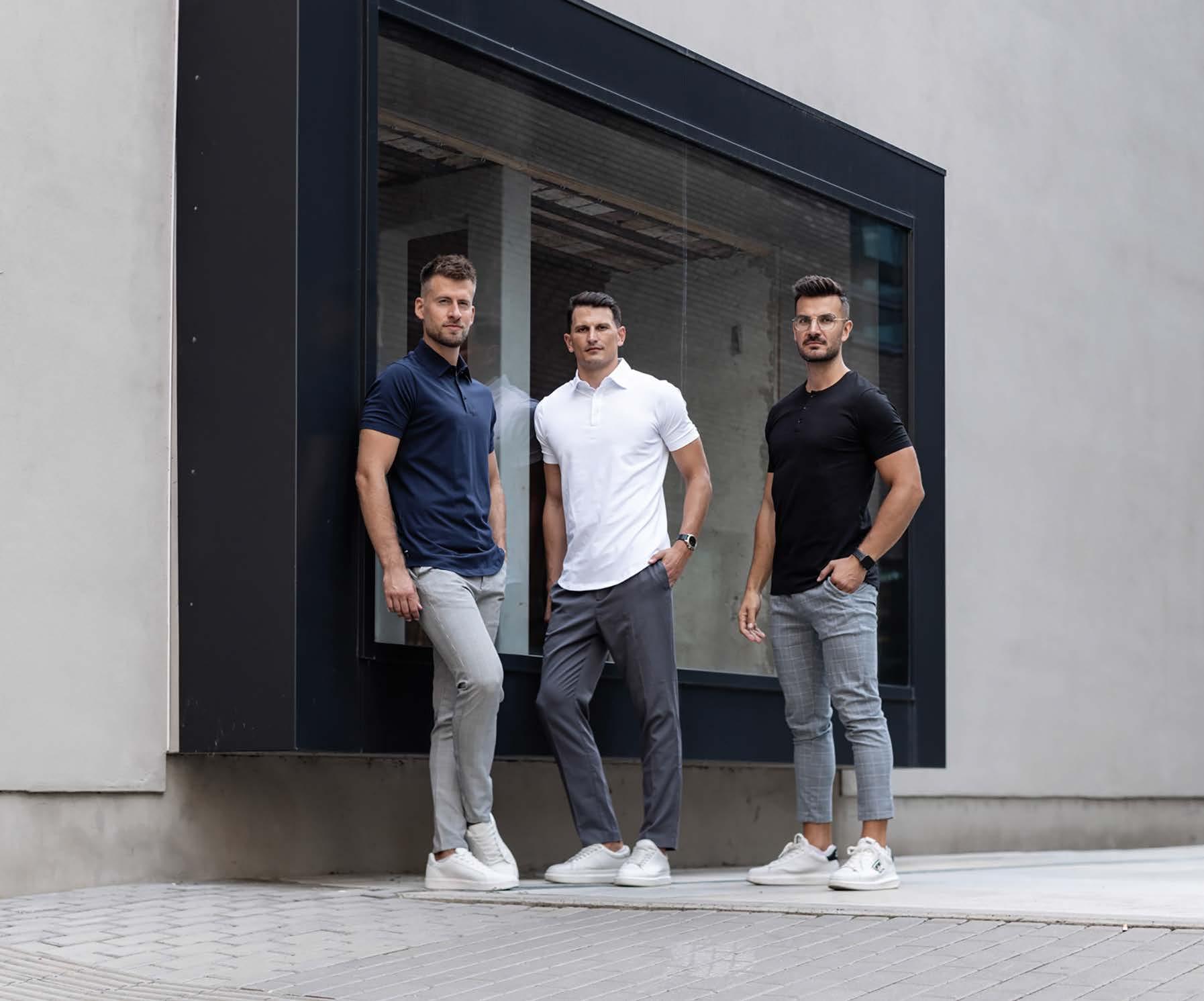
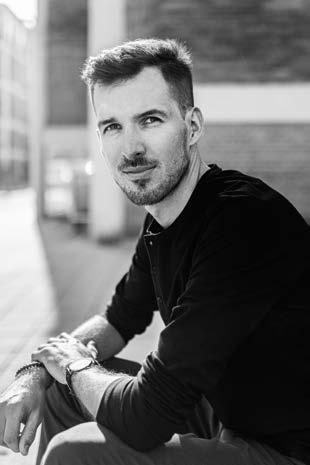
received a degree in Engineering Technology in Brno. Although he never worked in this field, the school equipped Radek with a lot of great experiences and personal qualities like striving for perfection. Delivering a perfect product became his goal in all activities he engaged in while working for different companies – he worked in marketing, made videos, took photos, prepared advertisements, and managed websites.
As time passed, Radek realized that TallGuys is not just business, but the path that he would like to go and help others feel self-confidence in everyday life, not just in clothing.

Polo is thought to have originated in China and Persia around 2,000 years ago. The game’s name may well have come from the word “pholo”, meaning ‘ball’ or ‘ballgame’ in the Balti language of Tibet. The first recorded game took place in 600 BC between the Turkomans (who won the game) and Persians.
The British settlers discovered the game during their travels in India, were captivated by it, and so they imported it to Europe. It was only at the end of the 19th century that these same Englishmen brought the polo culture with them to Argentina. The first polo match in Argentina was in 1875.
Argentina was a perfect place for polo to develop as a sport, partly because of the great plains you see all over the country. These plains, or ‘Las Pampas’, acted as natural polo fields, and still do, and the Argentine people revel in playing on their home turf – on their land on which they work to produce crops all-year-round.
Argentina is renowned as the capital of polo and is home to some of the world’s most famous polo clubs and players.
As part of 100 years of diplomatic relations between the Czech Republic and Argentina, the Ambassador of the Argentine
Republic, H.E. Mr. Claudio Javier Rozencwaig, organized a Czech-Argentine Polo Day at the beautiful Neo Polo Club in Březina, Moravia, with the support of Renocar (BMW).
The program included getting to know Argentina’s Polo, Horse Polo
theory, a practical Polo mallet exercise, a Horse Polo trainer, asado (original grilled specialties), and a tasting of Argentinian wine.



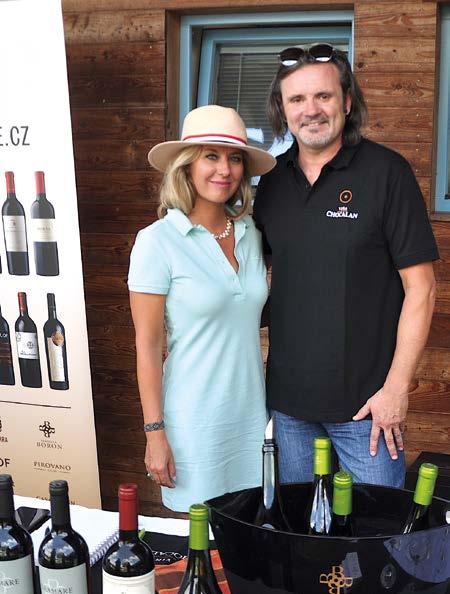


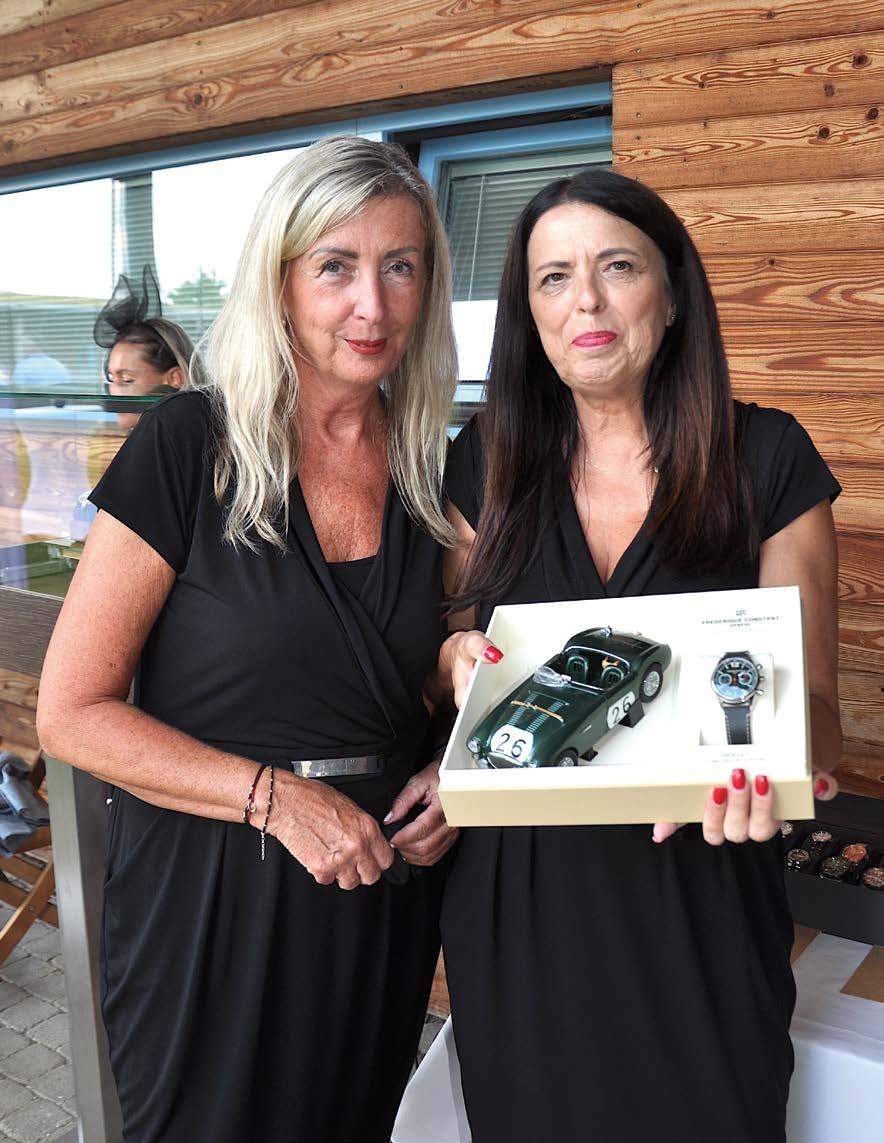


We are not a history magazine, but sometimes the story we come across is so interesting that we want to share it with you. Have you ever stayed in a hotel where you ate breakfast in the company of a bomb, used as decoration? That’s exactly what happened to us in Northwest Italy, a few kilometres from the beautiful seaside commune of Chiavari. Why have a bomb in a house? Where did it come from? And how old is it?

Summer is a holiday time for many, and we are no exception to the tradition. This year, we decided to enjoy the beautiful sights of Italy, booking a very nice apartment outside of Genova with the plans of visiting a dog beach. You can read more about our trip at the end of this magazine.
Leivi is a town and commune in the Metropolitan City of Genova, in the Liguria Region of Northwest Italy. A few kilometres from Chiavari, it is a centre for the production of olive oil.
We met our host, Ruggero Ferri, in the breakfast room, which was decorated with a collection of unique vintage items. Among those items was a big bomb. This made me very curious – why is there a bomb in this house? Where did he get it from? And how old is it?
As we spoke, Mr. Ferri explained its origins and history – it is an original bomb from the American bombing of Genova at the night
of 11th May, 1944. Genova was the largest and busiest port in Italy. During WWII, it was heavily bombarded by air and naval forces, suffering heavy damage.
According to Wikipedia, there were several major raids on the harbour in May 1944:
1st May, 1944
A raid on the harbour by six RAF bombers. Bombs also fell on the city, killing two civilians.
2nd May, 1944
A raid by twelve RAF bombers.
9th May, 1944
26 RAF bombers attacked the harbour. Bombs also fell on the city, killing four civilians.
19th May, 1944
A raid by the 15th Air Force, targeting the harbour and the marshalling yard. The objectives were hit, but many of the bombs fell on the city (especially the old city centre). Among the damaged

buildings were the University, the Cathedral, and the San Martino hospital, causing 111 deaths among the population.
28th May, 1944
Another raid by the bombers of the 15th Air Force, targeting the harbour and the marshalling yard.
Mr. Ferri found a bomb, and since it was in good shape with a serial number, he asked the American Army for details about it. After some time, he received related documents from them.
The restricted war diary from May 1944 speaks clearly – on 12th May, 1944, the staggering 42 planes took off at 05:15. The mission: Target of opportunity due to cloud cover, Chiavari Bridge. Assessment: Direct hit, causing severe damage.
The war diary provided by the US Army can give you more authentic details.
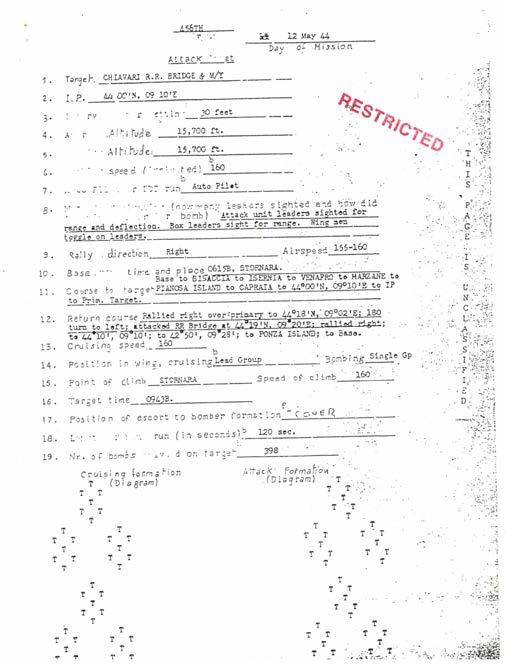

There is no doubt that Italy is among the most popular holiday destinations for Czech people. We love its history, the friendly people, the food, and the sea. We love it so much that we keep going back there every other year – together with our dogs, of course. This summer, we drove to Sorrento, specifically to our most favourite seaside place in the South of Italy – Relais Regina Giovanna.
A lot of things go through your mind while you prepare for a 10 day car holiday with two dogs. Among them are the sweet memories of our two Labradors (R.I.P.), who loved swimming in the Mediterranean Sea, and whom the Italian people called “Bello and Bellissimo”. With our two new puppies, Dexter and Boomer (who are Bernese Mountain Dogs), we now load the car for the trip to the south of Italy, about a 1500km drive in total, with a few stops on our way in order to explore Italy’s history before we can enjoy the seaside in our final destination of Sorrento.
When you travel with your dogs, about half of your car is full of their stuff. Several days before the trip, they should receive a dose of ‘Strong Hold’ – a medicine that will protect them against the infection carried by the Mediterranean Fly. You must prepare the dogs’ EU passports with the confirmation of required vaccinations, dog food, dishes, toys, towels, and treats. Much less is needed for us – basically our passports and travel insurance, clothes that we can wear when visiting museums and churches, and those for the beach. We bought The Vignette – Austria’s Motorway Toll Sticker. In Germany, there is no toll, and in Italy, you pay on the road.
With a full car and in an excellent mood, we left Prague early in the morning.
Prague - Baden-Württemberg (5h 45 min / 527 km)
Our first drive was from Prague to Baden-Württemberg to visit three monasteries: Ochsenhausen Abbey, Schussenried Abbey, and Basilica St. Martin. These are three monumental and exquisite examples of baroque religious art in former Upper Swabia. Although all of these were magnificent, in Schussenried you may see one of the most beautiful libraries in Europe.
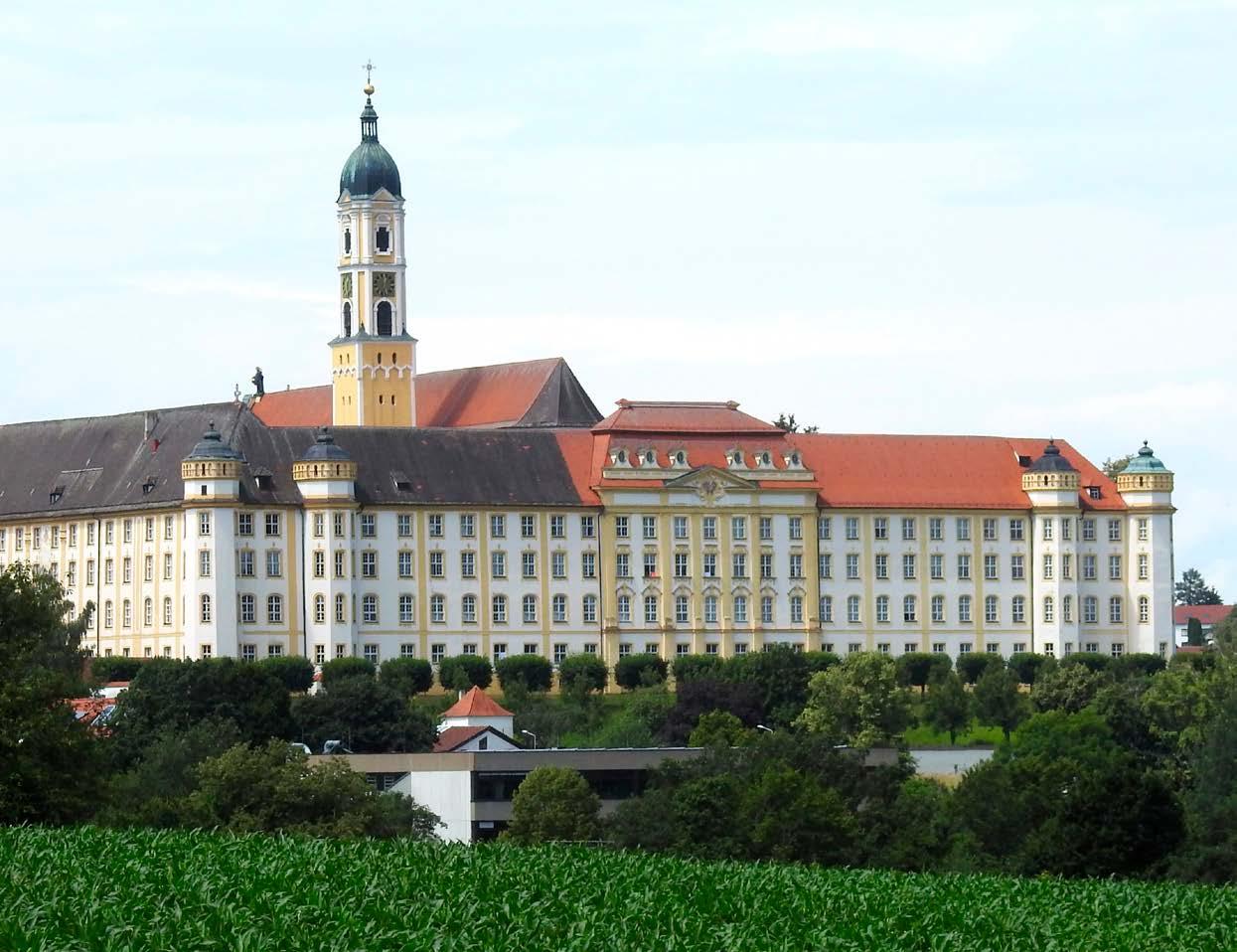


We spent our first night at the Austrian Löwen - Hotel & Gasthof, Kohlgasse 1, 6800 Feldkirch.
We made all our hotel reservations in advance via Booking.com, while opting only for hotels that welcome dogs and offer parking.
Feldkirch - Genova (5 h 30 min / 420 km)
After a tasty breakfast, we drove from Feldkirch to our next overnight stop at Ostello Bello Genova, a nice place when planning to explore Genova. This was a simple and clean hotel. It was a really hot day, so after a short walk in the city centre the “boys” were happy to sleep in the room and let us further explore the city on our own. We were lucky, as it was the day with free entrance to all museums. First, we visited Palazzo Reale
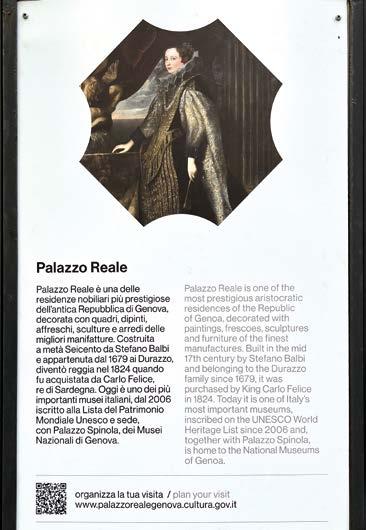


and Palazzo Spinola e Galleria Nazionale della Liguria. The Royal Palace is a huge urban palace, converted into a regal seat when new Genoa masters Savoy Royal House needed a representative palace in the Liguria Capital. On the other hand, Palazzo Spinola, hidden in the maze of small streets in the old town, is a beautiful representative of a Patrician palace, later changed into a Museum and Galleria.
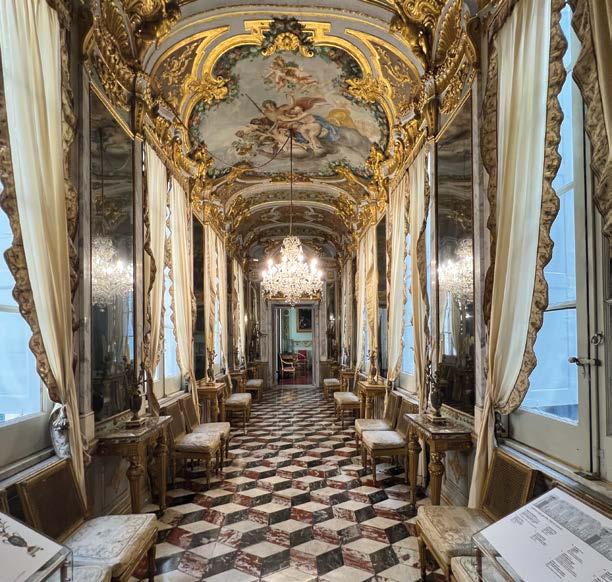
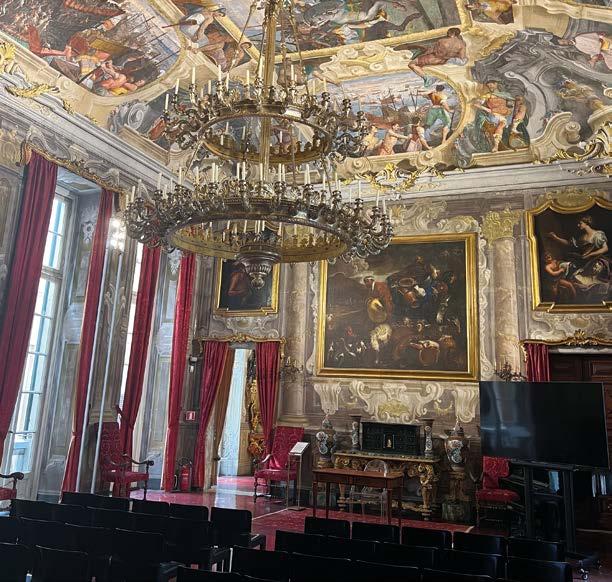
The next morning, we visited Villa del Principe and Giardini, a beautiful palace and garden with a completely different story. Villa, originally built as a suburban palace by Andrea Doria (famous navy admiral of the Genoa republic fleet), is considered a marvel of Italian renaissance. Adorned by splendid frescoes, Villa is still managed by the Doria-Pamphilj Family. Don’t miss it.

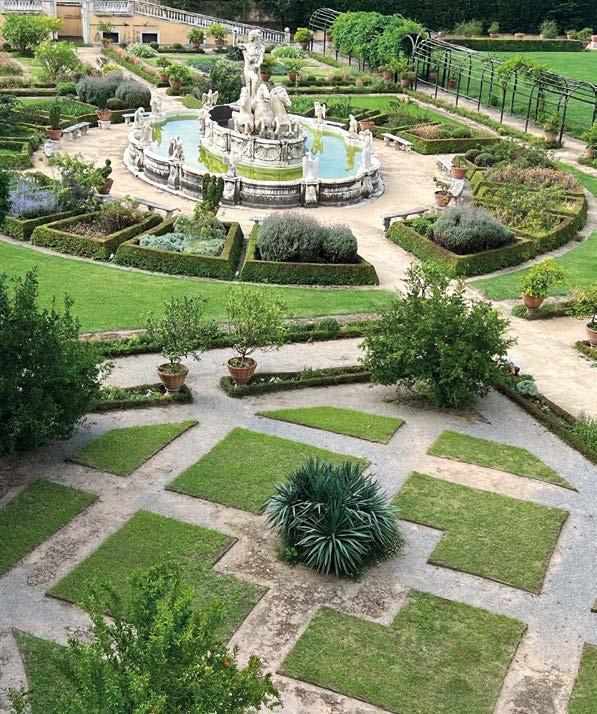

Genova - Santa Margherita Ligure (50 min / 49 km)
We drove again, this time from Genova to Santa Margherita Ligure, in order to see Chiesa di Santa Margherita and walk by the Monumento a Cristoforo Colombo.
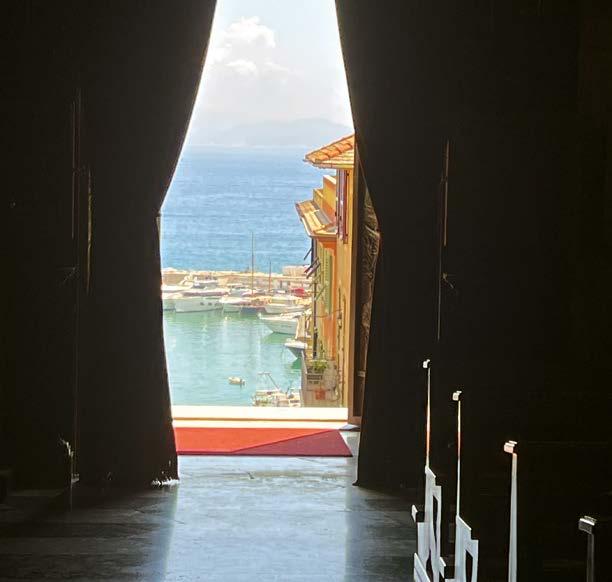

Santa Margherita Ligure - Chiavari (30 min / 19 km)
Our next hotel was Bed & Breakfast 4U, in the small village of Leivi. It is a nice small apartment hotel with a friendly owner. Watch out when parking there, they have a really narrow entrance. A short walk from the hotel was a local restaurant, Rostio (www.rostio.it), with really tasty food and a friendly service.
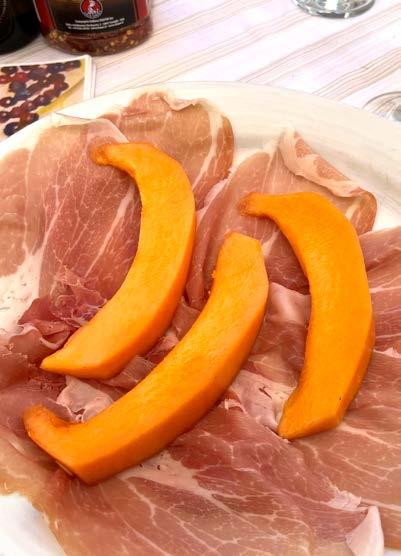


The next morning, we went for a small breakfast in the hotel itself. The breakfast room looked like a museum of vintage items, and we found out that the owner is a collector. One of the items that made me very curious was a big bomb (you can read more about it in our article on Chiavari Bridge).
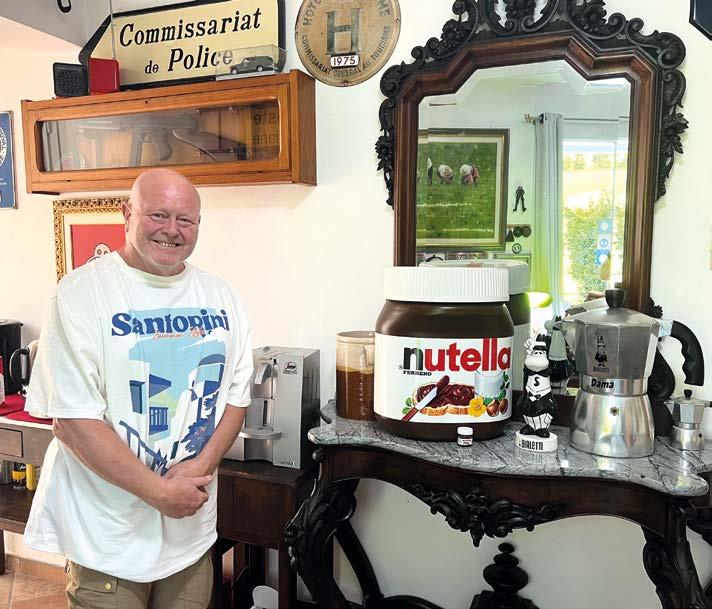

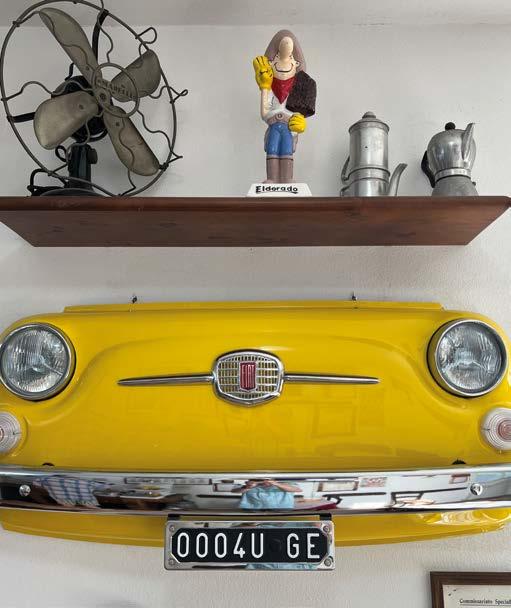
In Italy, dogs can swim only at special dog beaches. Bagni Oasi is one of them, located just a short drive from Leivi at Spiaggia Villa Piaggio. This would be the first time our puppies Dexter and Boomer will swim. How will it go? It was a new experience for them, they were a bit afraid but slowly tried it a few times.

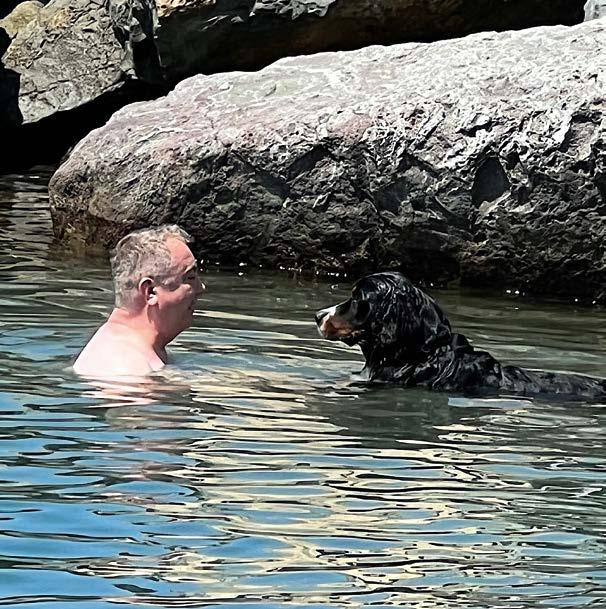
Chiavari - Tarquinia (4 h / 369 km)
The next morning, we left for Tarquinia, a small, charming city with really (!) old history, going back to pre-roman times. As one of the oldest Etruscan towns, it gave ancient Rome two of its seven legendary kings. It was a very hot day again, so we left the boys in our nice apartment in the old part of the town and went to explore the place by ourselves. We visited the Duomo di Santa Margherita, Museo Archeologico Nazionale di Tarquinia at Palazzo Vitelleschi (where you can see the famous horses from the Ara della Regina), and took a long walk to the Necropolis to see several tombs.
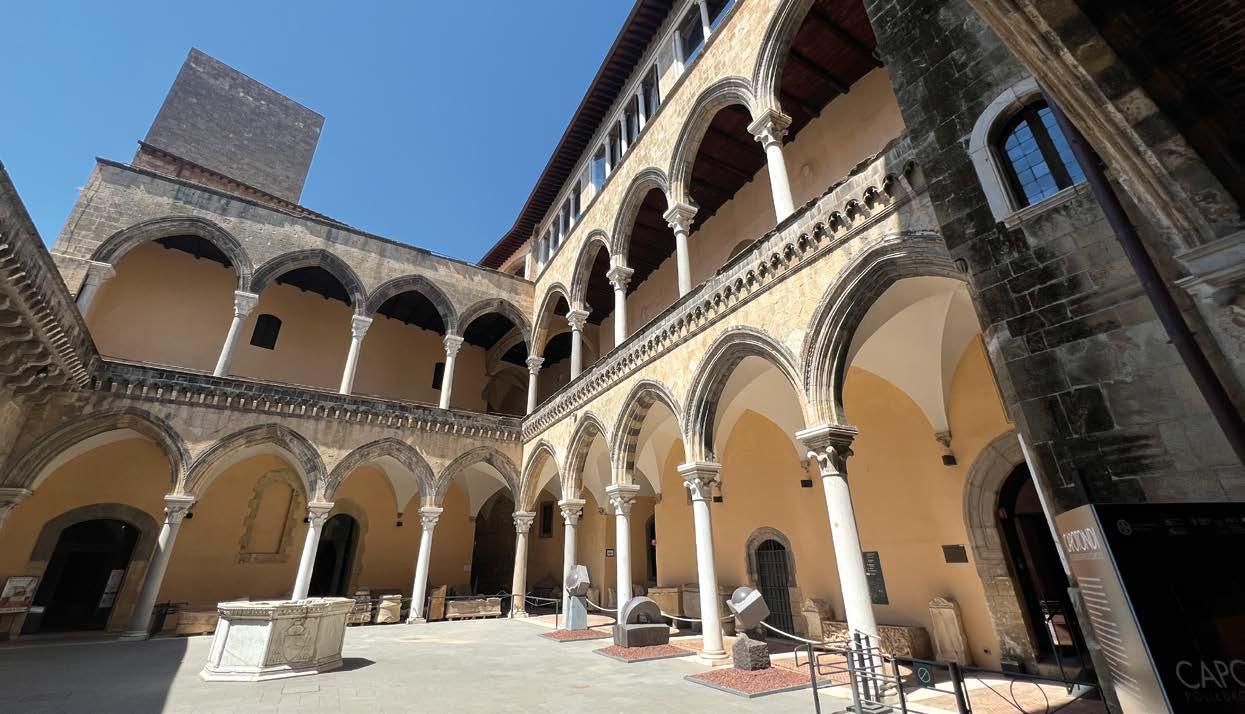
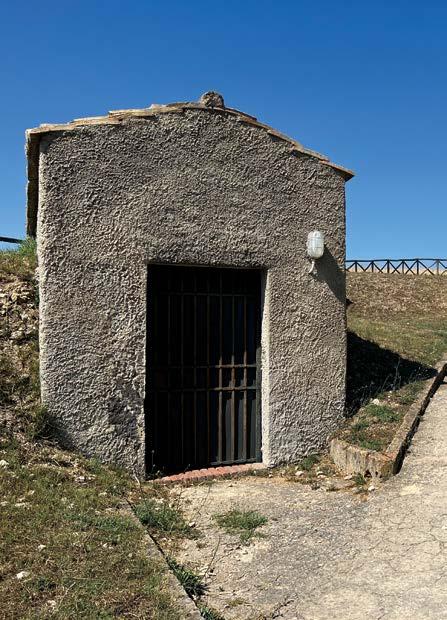

After a short rest, we had a great dinner at the restaurant under our apartment (THERRA - Osteria e Carne al Fuoco) – those large and tasty portions were something we hadn’t experienced in a long time.

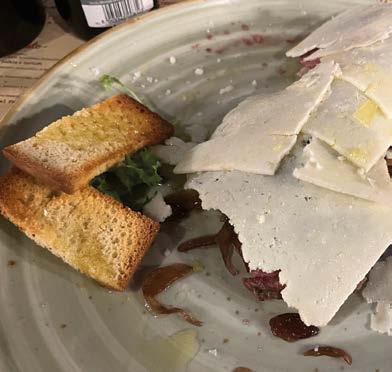

Tarquinia - Sorrento (4 h 20 min / 355 km)
New morning, new area. No more history. The real holiday is at the gate. We drove to our final destination of Sorrento, and, early in the afternoon, we arrived at the place we really love in South Italy – Relais Regina Giovanna. I still remember the first time we arrived in this magical place twelve years ago – a small, nice hotel with a private beach, where our puppies (back then it was only Zorro) will be allowed to swim. A charming place that the owner, Gianluca Picone, had big plans to make into a luxury home for people who want privacy, good service, and good and healthy food. Just above the beach, there was an empty place that became the heart of it all – a small restaurant and bar, with tasty food, wine, and of course Aperol Spritz. This venue’s incredibly friendly team made our holiday even more relaxed and fun.
We always feel at home here, walking around, surrounded by lemon and olive trees and a romantic sunset. In recent years, the hotel has become a bio-food hotel, with food made from their own vegetables. The breakfast is rich and tasty. The service is friendly. A very nice start to a real holiday at the beach.
So, here we are, and relaxing on the beach with our boys, Dexter and Boomer, was the highlight of this holiday. Our previous boys, Zorro and Choko, were Labradors and loved to swim. For our new Bernese Mountain Dog puppies, it was a new experience. It was Václav’s job to teach them how to enjoy the sea and swim, which wasn’t an easy task. After a few days at the dog beach, Dexter was swimming well, but Boomer hated it.
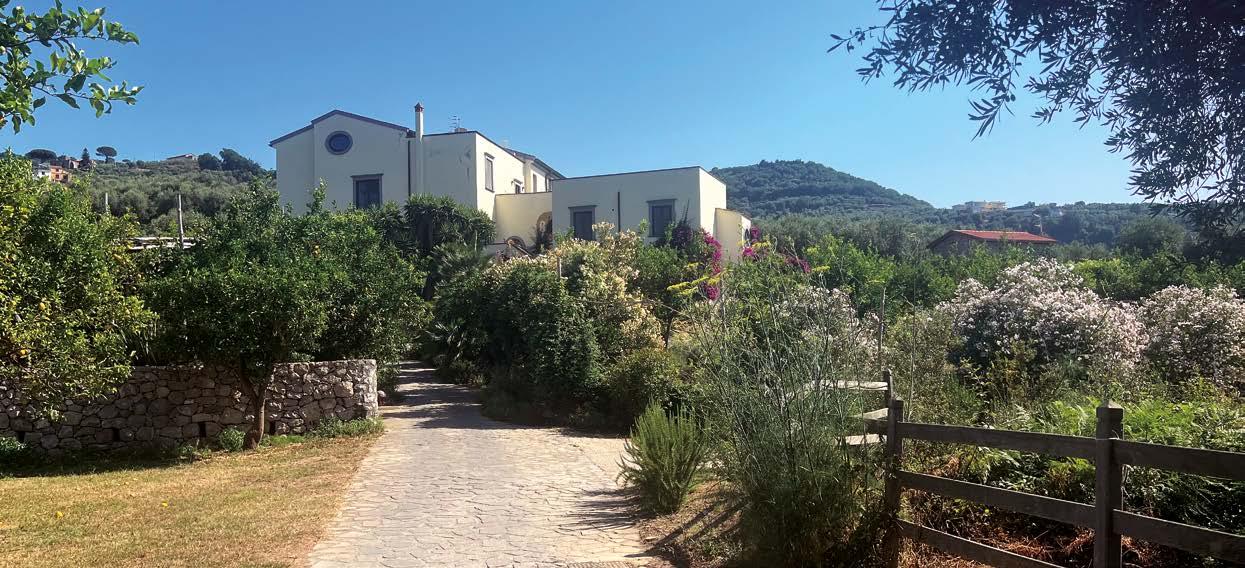
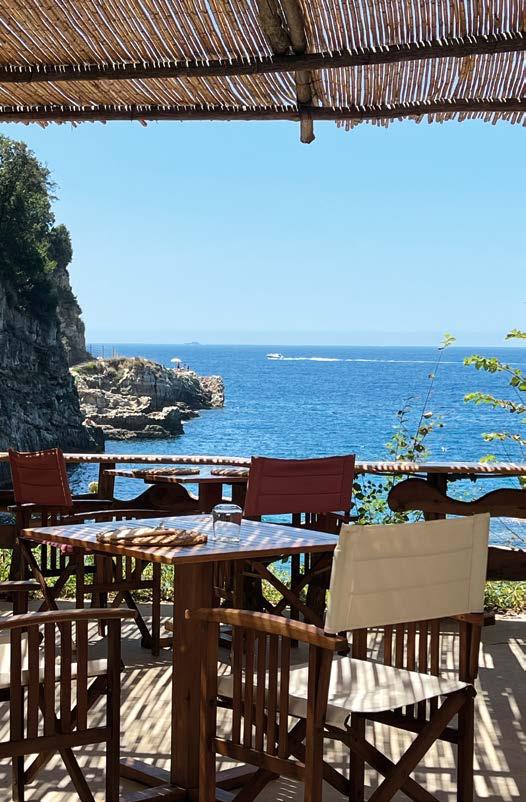
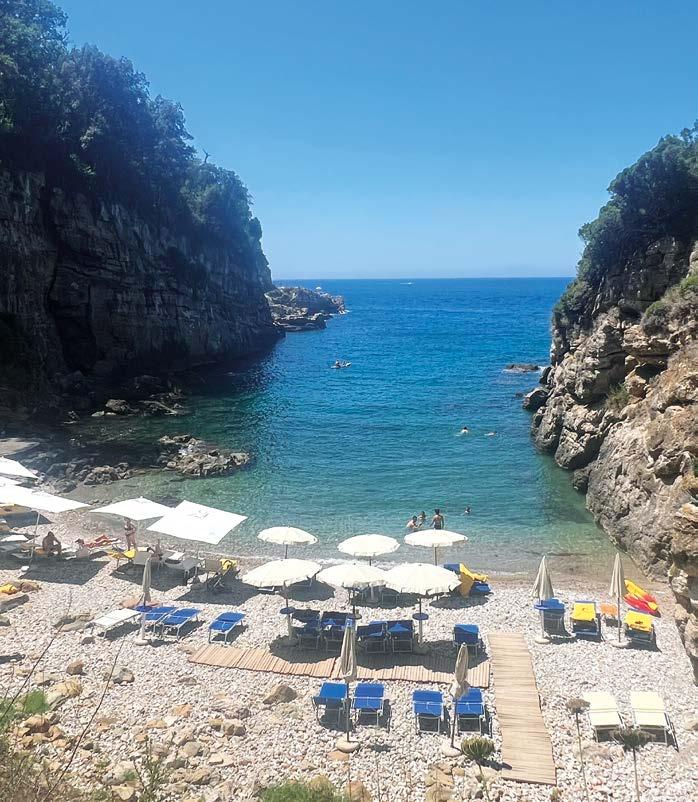
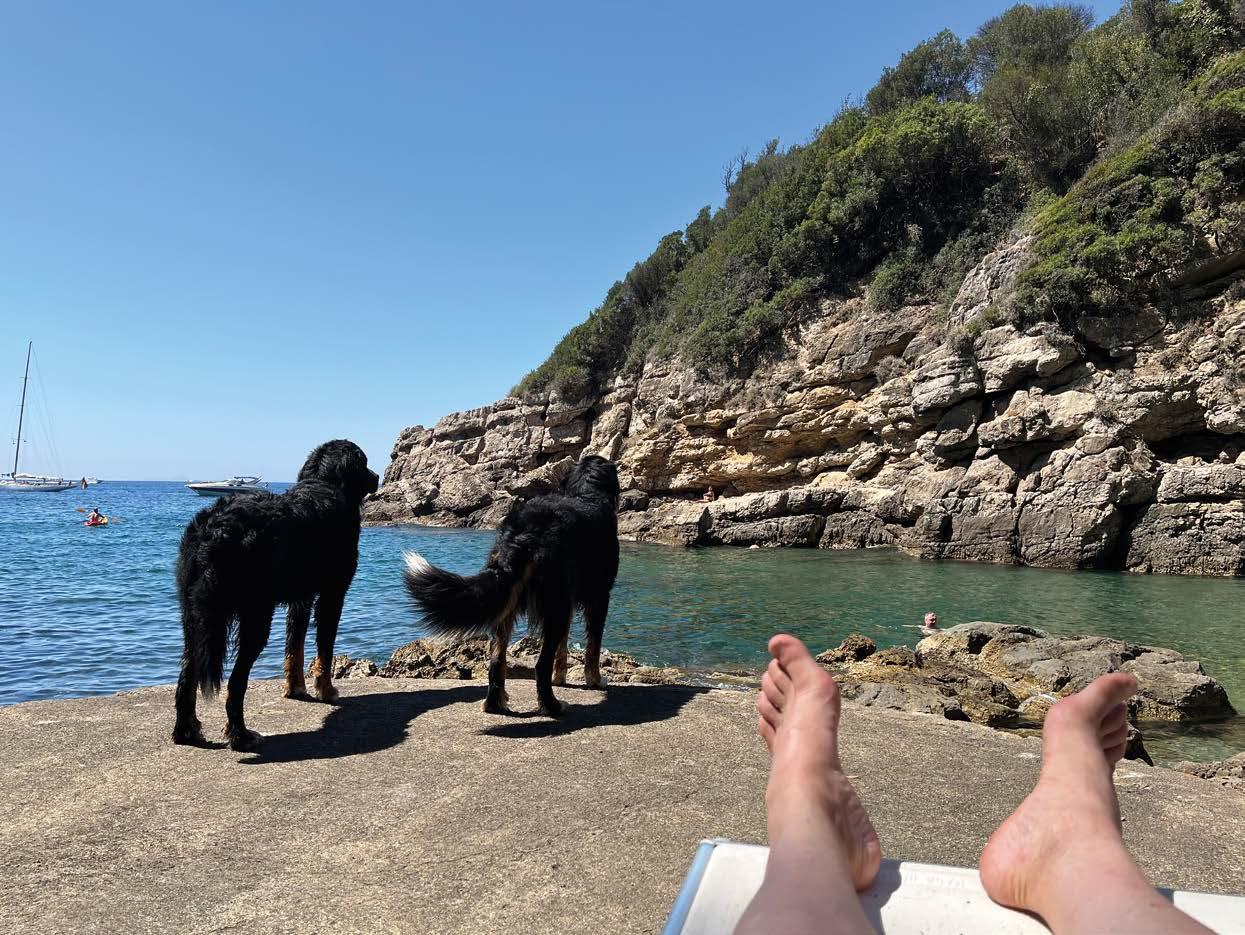
The hotel had an “a la carte” restaurant serving dinner, but the offer was limited, especially if you are not a seafood lover. So, in the evenings, we drove a few minutes to the nearby port Marina di Puolo, a place with a variety of restaurants. Ristorante-Bar DonVino was the best – make a booking in advance though, as it’s full most of the time.
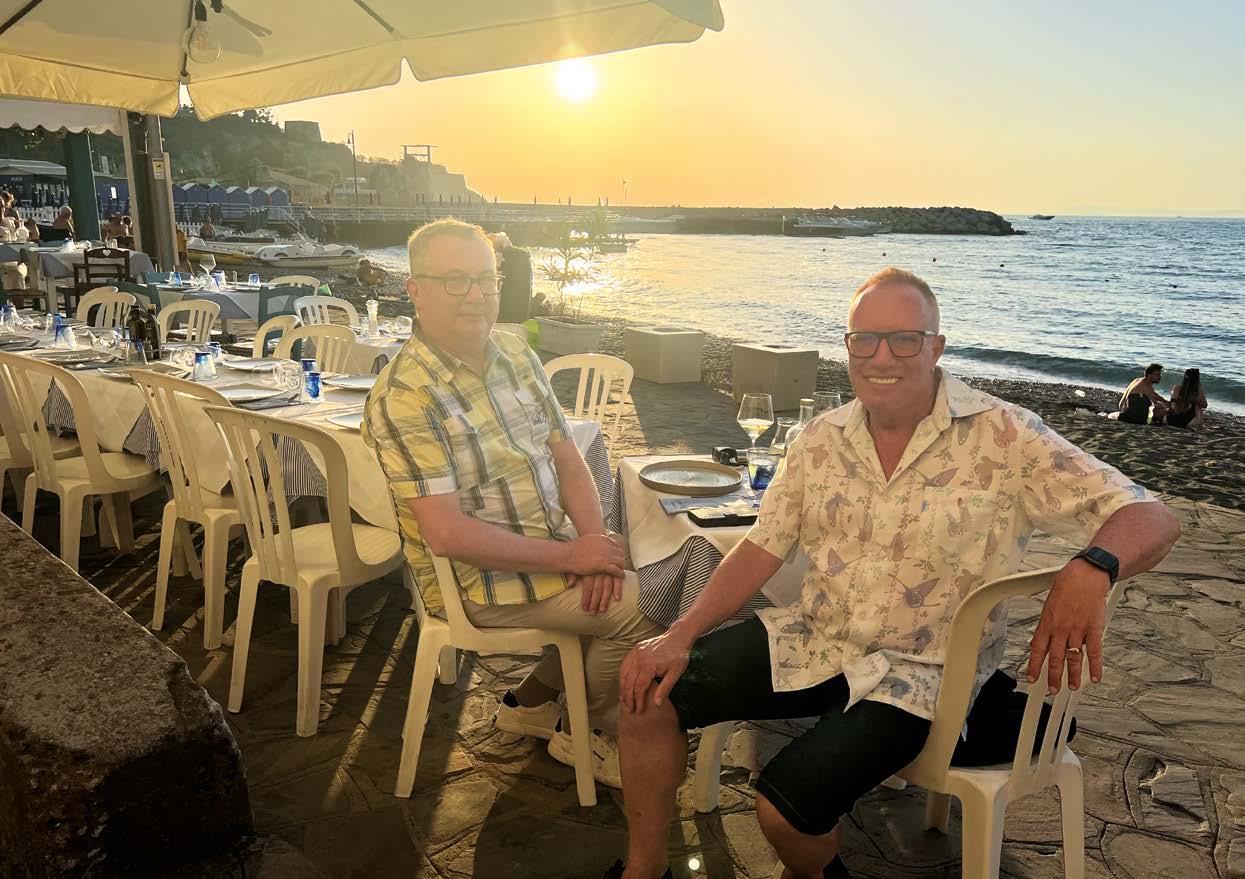


Sorento - Cori (about 4 hours of driving)
Every good thing has to come to an end, and so, after a few days in this heaven, we drove back north to our home in Prague, again with a few stops on our way. In Cori, we took a short walk in the town centre, before arriving at our hotel – Cincinnato Wine Resort.
What a nice surprise! This was a lovely place, with a big modern swimming pool and a delicious variety of wines. The restaurant is open only on weekends, but just a short drive away we found a very good restaurant with delicious food. Cincinnato Wine Resort is located about 40km south of Rome, and it is a nice place to return to for a holiday, a company event, or even for a romantic wedding.
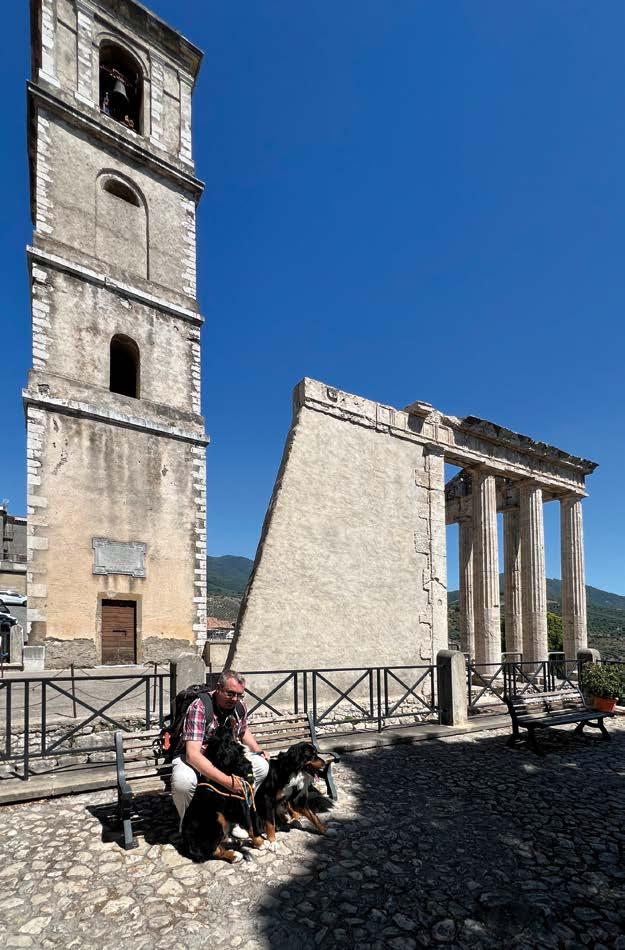
Cori - Trento (6 h 30 min / 627 km)
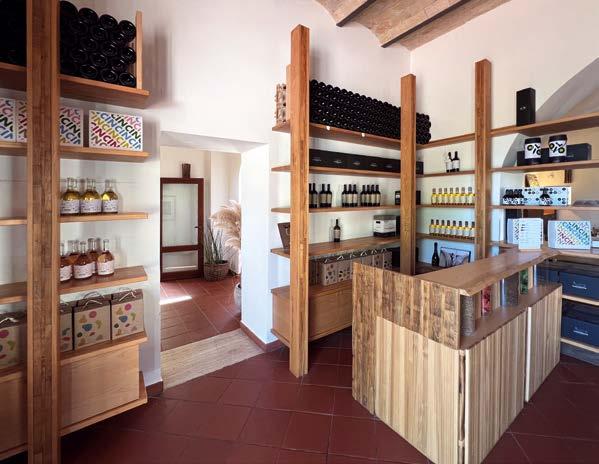

Trento was our last stop in Italy for now, and we stayed overnight only to continue driving again in the morning.
Trento – Prague (8 h 15 min / 729 km)
Home sweet home, full of new memories of our exciting adventures. We love Italy and the Italian hospitality, and hope to return soon. Arrivederci!
